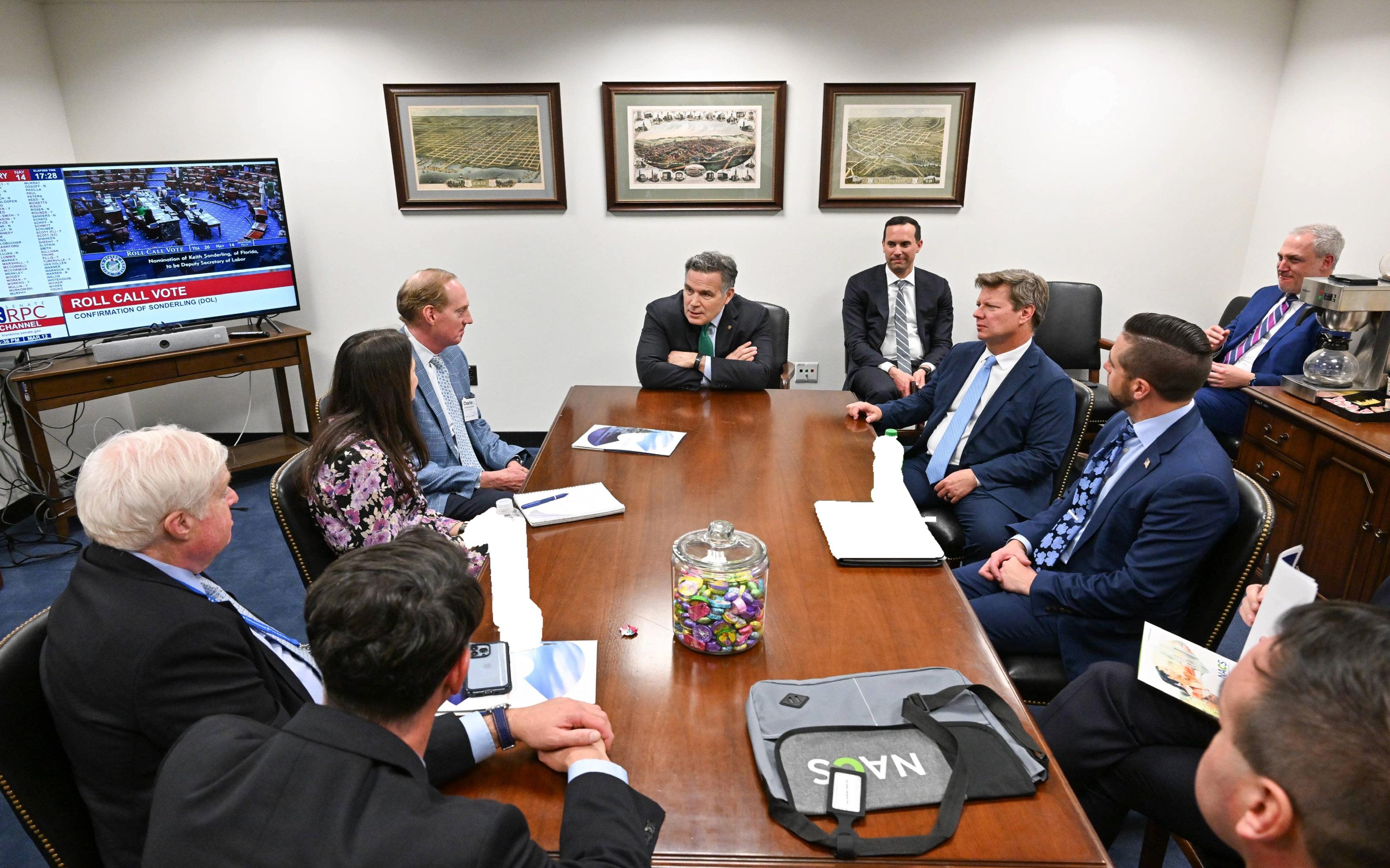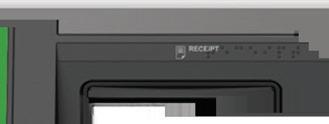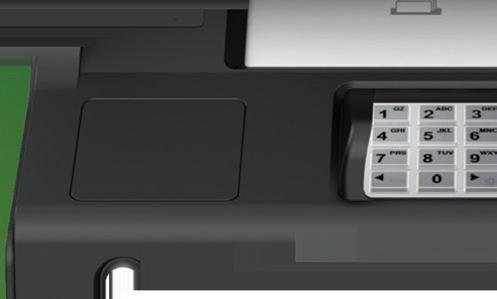Takeaways from the 2025 NACS Show reveal an industry accelerating forward
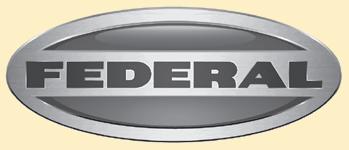
Learn from global trends
PRIVATE LABEL Sales slow but potential remains
FOODSERVICE IDEAS
Learn from global trends
PRIVATE LABEL Sales slow but potential remains

Takeaways from the 2025 NACS Show reveal an industry accelerating forward

Learn from global trends
PRIVATE LABEL Sales slow but potential remains
FOODSERVICE IDEAS
Learn from global trends
PRIVATE LABEL Sales slow but potential remains
Takeaways from the 2025 NACS Show reveal an industry accelerating forward


SCAN DATA BASE INCENTIVE
Receive a Scan Data Base Incentive payment for each eligible Scan Data transaction timely submitted to AGDC.
Boost your business with a responsible digital platform that enhances customer engagement and loyalty. The AGDC Digital Trade Program helps retailers connect with Adult Tobacco Consumers 21+ while driving business growth through incentives.
CONSISTENT LOYALTY ID (CID) PROMOTIONAL FUND
Earn incremental per-transaction incentive funds for each identified Consistent LID appearing 5 or more weeks in Scan Data.
SCAN DATA MAINTENANCE INCENTIVE
Submit weekly Scan Data files for 13 out of 13 weeks to receive additional incentive payments.
Contact your AGDC Representative to learn
32
Takeaways From ‘The Greatest Show on Earth’ (That Isn’t a Circus)
From TikTok (customizing the customer experience) to ‘tick tock’ (giving back time and providing energy), the 2025 NACS Show delivered on its promise.
46
Packaging Priorities
Consumers are gravitating to more sustainable packaging, but it’s not just the material that matters— performance does too.
48
Global Foodservice Trends
What can you learn from foodservice operators around the world?
58
Protein Possibilities
This Q&A is brought to you by Lower Foods.
Lower Foods shares insights into the evolution of proteins in foodservice.
60 A Multicultural Opportunity
Items inspired by traditional Hispanic cooking can attract consumers of all backgrounds and appetites.

Hungry customers flock to foodservice operators that have chicken on the menu.
66
Key Trends in Loss Prevention
More retailers are focusing on addressing total loss, implementing AI to prevent loss before it happens and training employees to help build confidence and capability.
74
A NACS survey reveals how consumers view c-stores, what they care most about and how to capture more of their business.
80
Private Label Profit Potential
Private label brands bring healthy margins and differentiation to c-stores.
88
Building Character
An effective mascot can dress up a company’s brand and create connection with customers.
Subscribe to NACS Daily—an indispensable “quick read” of industry headlines and legislative and regulatory news, along with knowledge and resources from NACS, delivered to your inbox every weekday. Subscribe at www.convenience.org/NACSdaily

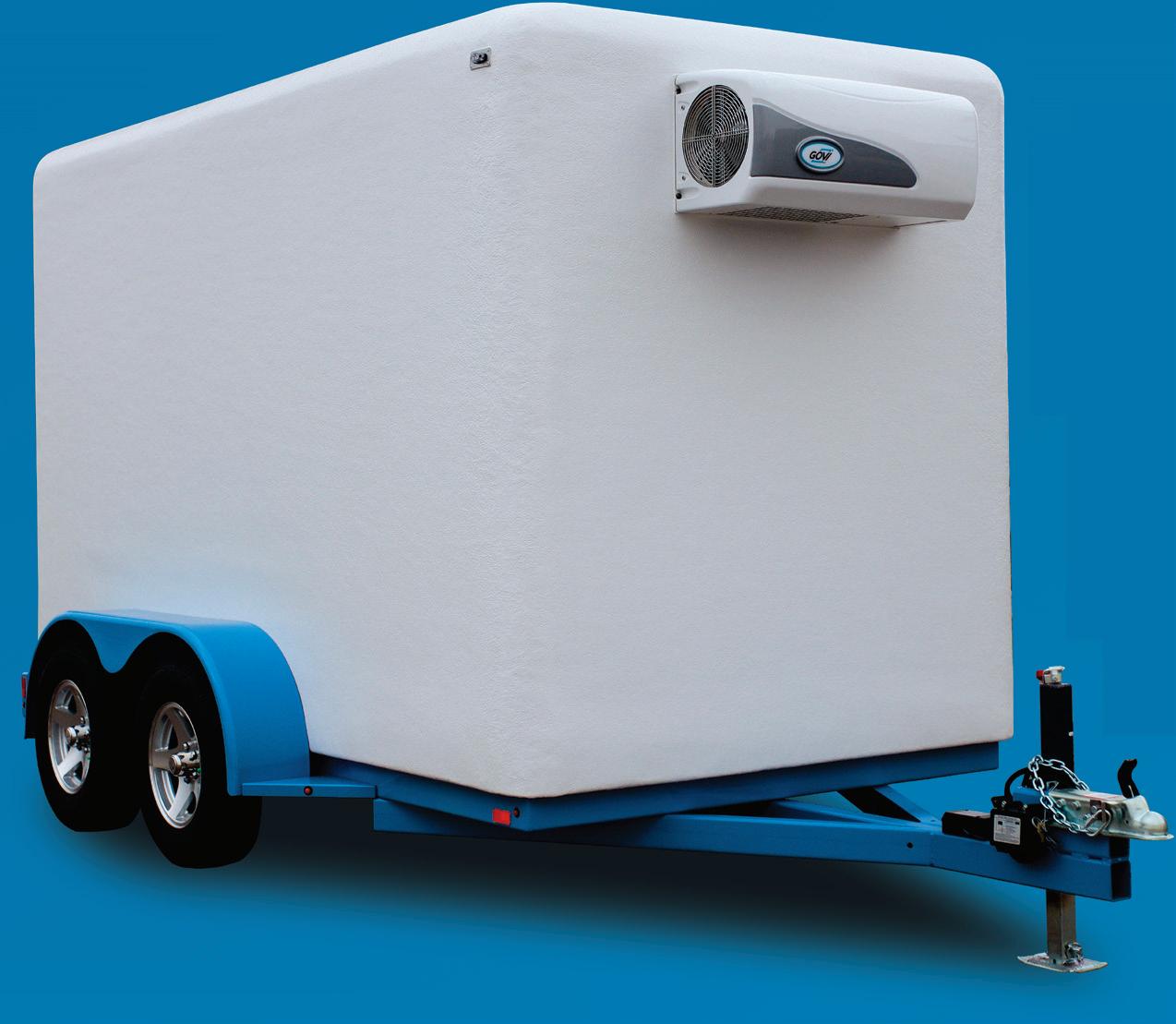





Jeff Lenard VP of NACS Media & Strategic Communications (703) 518-4272 jlenard@convenience.org
Ben Nussbaum
Publisher & Editor-in-Chief (703) 518-4248 bnussbaum@convenience.org
Leah Ash Editor/Writer lash@convenience.org
Lauren Shanesy Editor/Writer lshanesy@convenience.org
Noelle Riddle Editor/Writer nriddle@convenience.org
Chrissy Blasinsky Digital & Content Strategist cblasinsky@convenience.org
CONTRIBUTING WRITERS
Terri Allan, Lauren Fritsky, Sarah Hamaker, Al Hebert, Pat Pape, Adam Rosenblatt, Emma Tainter
DESIGN
Ji Ho
Creative Director jho@convenience.org
Erika Freber Art Director efreber@convenience.org
David Marvin Graphic Designer dmarvin@convenience.org
ADVERTISING
Stacey Dodge Advertising Director/ Southeast (703) 518-4211 sdodge@convenience.org
Jennifer Nichols Leidich National Advertising Manager/Northeast (703) 518-4276 jleidich@convenience.org
Ted Asprooth National Sales Manager/ Midwest, West (703) 518-4277 tasprooth@convenience.org
PUBLISHING
Nancy Pappas Marketing Director (703) 518-4290 npappas@convenience.org
Logan Dion Digital Media and Ad Trafficker (703) 864-3600 ldion@convenience.org
NACS BOARD OF DIRECTORS
CHAIR: Annie Gauthier, CFO/Co-CEO, St. Romain Oil Co. LLC (dba Y-Not Stop)
TREASURER: Lonnie McQuirter, Director of Operations, 36 Lyn Refuel Station
OFFICERS: Chris Bambury, Bambury Inc.; Tom Brennan, Casey’s; Varish Goyal, Loop Neighborhood Markets; Charles McIlvaine, Coen Markets Inc.; Natalie Morhaus, RaceTrac Inc.; Travis Sheetz, Sheetz Inc.
GENERAL COUNSEL: Doug Kantor, NACS
MEMBERS: Lisa Blalock, BP North America Inc.; Brian Donaldson, Maxol Limited; Tony El-Nemr, Nouria Energy Corp.; Terry Gallagher, Gasamat Oil Corp./Smoker Friendly; Erin Graziosi, Robinson Oil Corp.; Raymond Huff, HJB Convenience Corp. (dba Russell’s); Mark Jordan, Refuel Operating Co.; Thomas Love, Love’s Travel Stops & Country Stores; Crystal Maggelet, Maverik Inc.; Rich Makin, Wawa Inc.; Brian McCarthy, Blarney Castle Oil Co.; Andrew Mitchell, Toot’n Totum Food Stores LLC; Jigar Patel, Fastime; Robert Razowsky, Rmarts LLC; Stanley Reynolds, 7-Eleven Inc.; Kristin Seabrook, Global Partners LP; Babir Sultan, Fav Trip; Doug Yawberry, Weigel’s Stores Inc.; Scott Zietlow, Kwik Trip Inc.
NACS SUPPLIER BOARD
SUPPLIER BOARD CHAIR: Bryan Morrow, Chobani & La Colombe
CHAIR-ELECT: Kevin LeMoyne, The Coca-Cola Co.
VICE CHAIRS: Mike Gilroy, Mars Wrigley; Jim Hughes, Supplying Demand Inc. dba Liquid Death; Danielle Holloway, Altria Group Distribution Co.
MEMBERS: Tony Battaglia, PMI U.S.; Ryan Calong, Pabst Brewing Co.; Jerry Cutler, InComm Payments; Jack Dickinson, Dover Fueling Solutions; Matt Domingo, Reynolds; Mark Falconi, Greenridge Naturals; Ramona Giderof, Diageo Beer; Kevin Kraft, Tropicana Brands; Adam Gryzbek, BIC Corp.;
PAST CHAIRS: Brian Hannasch, Alimentation Couche-Tard Inc.; Victor Paterno, Philippine Seven Corp.
SUPPLIER BOARD REPRESENTATIVES: Bryan Morrow, Chobani & La Colombe; Kevin LeMoyne, The Coca-Cola Co.
Jay Nelson, Excel Tire Gauge LLC; Jordan Nicgorski, JUUL Labs; Nick Paich, TriggerPoint Media; Bria Troy, PepsiCo Inc.; Melissa Vonder Haar, iSEE Store Innovations LLC; Derek Zahajko, CAF Inc.; Jason Zagaria, Primo Brands
GENERAL COUNSEL: Doug Kantor, NACS
STAFF LIAISON: Bob Hughes, NACS
RETAIL BOARD REPRESENTATIVES: Tom Brennan, Casey’s; Scott Hartman, Rutter’s; Kevin Smartt, TXB
PAST CHAIRS: Vito Maurici, McLane Co. Inc.; David Charles, Cash Depot; Kevin Farley, Farley Retail Advisors
NACS Magazine (ISSN 1939-4780) is published monthly by the National Association of Convenience Stores (NACS), Alexandria, Virginia, USA.
Subscriptions are included in the dues paid by NACS member companies. Subscriptions are also available to qualified recipients. The publisher reserves the right to limit the number of free subscriptions and to set related qualifications criteria.
Subscription requests: nacsmagazine@convenience.org
POSTMASTER: Send address changes to NACS Magazine, 1600 Duke Street, Alexandria, VA, 22314-2792 USA.
Contents © 2025 by the National Association of Convenience Stores. Periodicals postage paid at Alexandria VA and additional mailing offices. 1600 Duke Street, Alexandria, VA 22314-2792


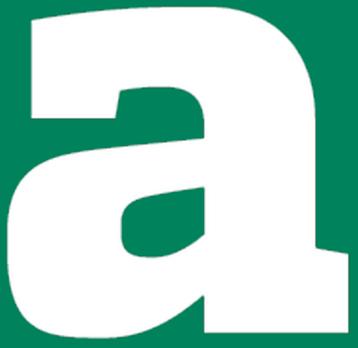
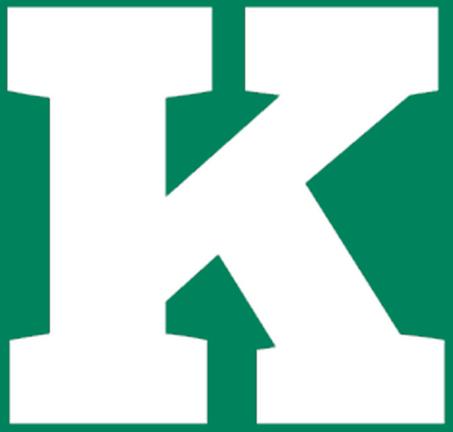


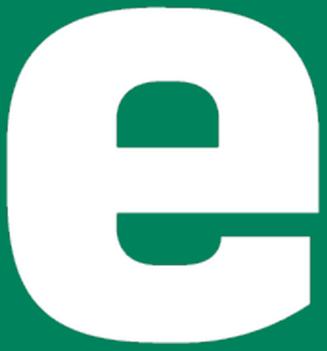





The 2025 NACS Show was my third and it was the best yet. The NACS team is super talented and works hard, but ultimately the NACS Show is a success because of the industry itself.
Every retailer who attends, whether they’re a regular, a first-timer or a company finding a way to send one more team member than the year before, is a part of the success. Every supplier who invests in creating a great booth experience is doing their part, too. Each Education Session depends on people stepping up to share their expertise with their industry colleagues. And the dozens of industry representatives who serve on NACS committees keep NACS—and the NACS Show—humming. At the end of the day, convenience is a team sport.
I was reminded how collaborative the industry is during an Education Session on THC beverages. One message shared from the stage was that advocacy groups, suppliers, distributors and retailers all need to work hand-in-hand right now to support this category so that it can be consistently profitable in the future. No one can do the work by themselves.
Advocacy groups rely on retailers to show up and tell their story. Retailers rely on suppliers to understand and stay up to date on regulation—such as when labeling changes are mandated. Everyone has to work together to educate consumers with a consistent message. Each c-store depends on every other c-store: If there are bad actors when it comes to age verification, that impacts everyone.
That need to work together is a strength, not a weakness. As 2025-26 NACS Chairman of the Board Annie Gauthier said during a NACS Show General Session, “As an
industry, we are there for each other. We share with each other and we lift each other up so that we can lift up the communities we serve.”
Interested in more ways to stay connected with the convenience community? Check out convenience.org/events for a full list of upcoming NACS events.
The NACS Show is the place to be for all kinds of nerds: data nerds, fuels nerds, foodservice nerds, technology nerds and Nerds nerds.
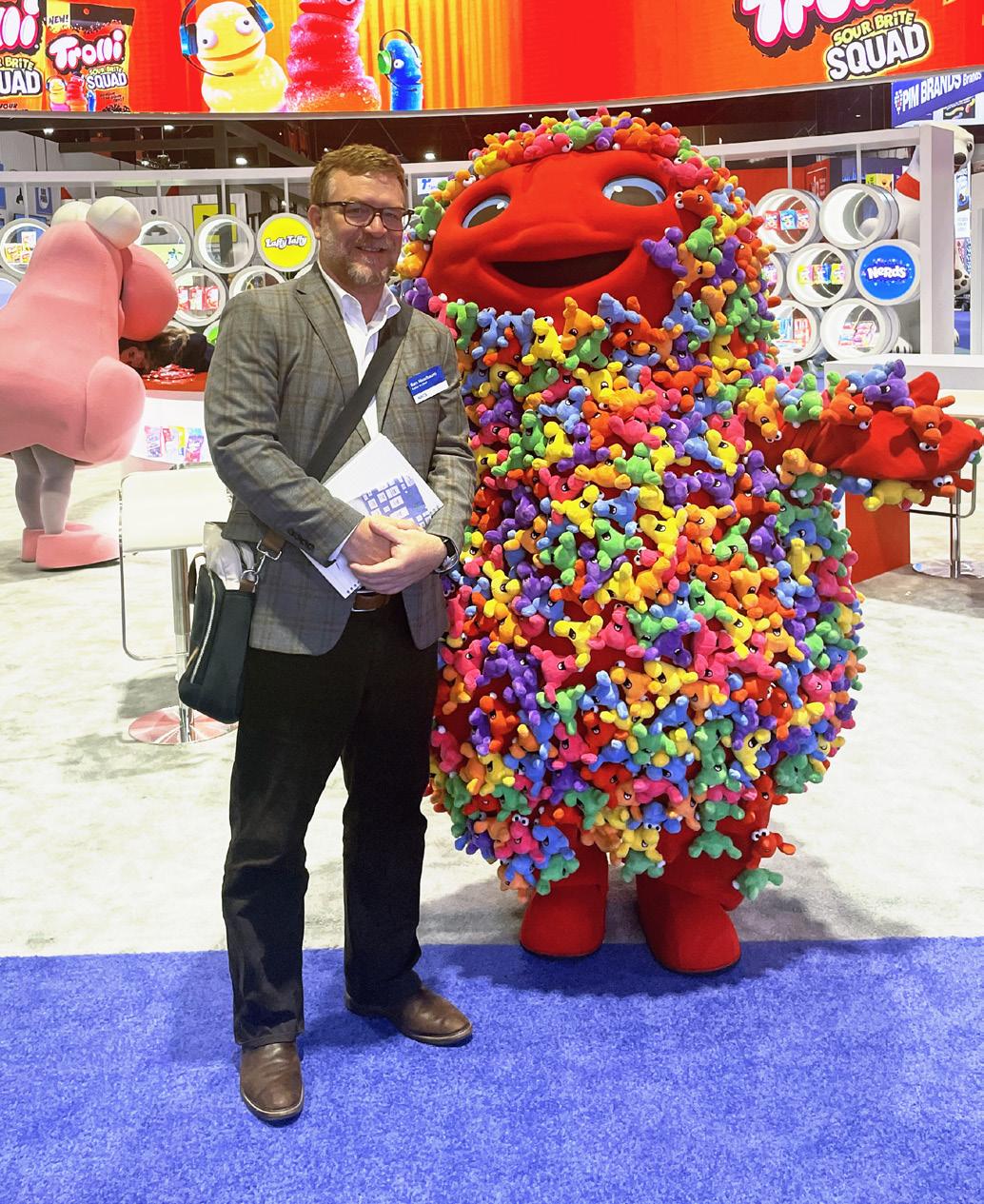

WARNING: This product contains nicotine. Nicotine is an addictive chemical.
Working in a convenience store is “the ultimate people person job,” said
Patty Peterson, manager at Farmer’s Grandson Eatery, a foodservice concept and convenience store with locations in Lakeville and Eagan, Minnesota. She has worked at Farmer’s Grandson since 2018 and spent years managing other c-stores prior to that. “In a c-store, you really get to know people, your regulars and other customers, and develop a relationship with them. If you’re a people person who truly loves to connect with people, you won’t get this kind of job satisfaction many other places. It’s one of the reasons why I love coming to work everyday,” she said.


WHY SHE LOVES WORKING IN THE CONVENIENCE INDUSTRY
It wasn’t until Covid that I really discovered how important we as convenience stores are to people. We were the only businesses open. We could be the only place for a parent who needs a fever reducer for their young child at night, a diabetic person who needs orange juice or just someone that needs a clean restroom. There are so many things that we provide to the community, even if it’s just the basics, that makes us so much more than just somewhere to grab a pop or a snack.
“Working in a c-store, I really feel like we are heroes.”
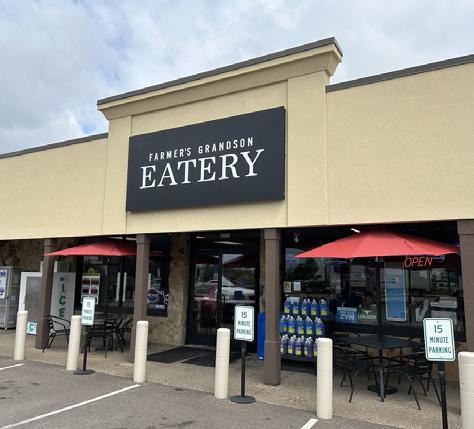

It’s one thing to tell people how to do something, but I like to lead by example, that way the people I work with can feel relaxed, be themselves and really let their personalities come out. There’s not a whole lot of businesses where you can do that because you have to be really professional. But in our store, we are friendly, greet customers by name and really get to know them. And regular customers really appreciate that too, because you are part of the community for them and they connect with you that way.
HER MOST MEMORABLE MOMENT AT WORK
Last year a young gentleman came into the store, he smiled at me and said ‘you don’t remember me, but I sure remember you.’ He shared with me that when he’d come into the store years ago, he’d been in a very bad place in his life. I had asked him how his day was going and talked to him for a little bit, and whatever I said to him made such an impact on him that that was the day he started making decisions to turn his life around and get back on track…and now he’s doing really well.
He came back to the store to tell me that—that it all started with me. I tear up when I think about this story. We all know that kind words make a difference to people, but mine really changed his life. That means so much to me.
















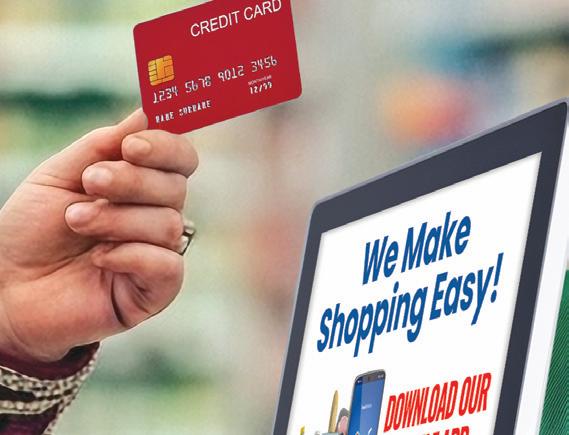
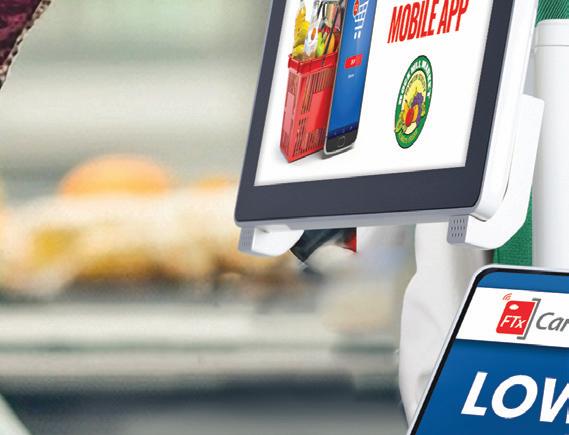














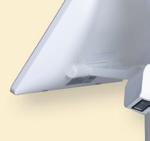







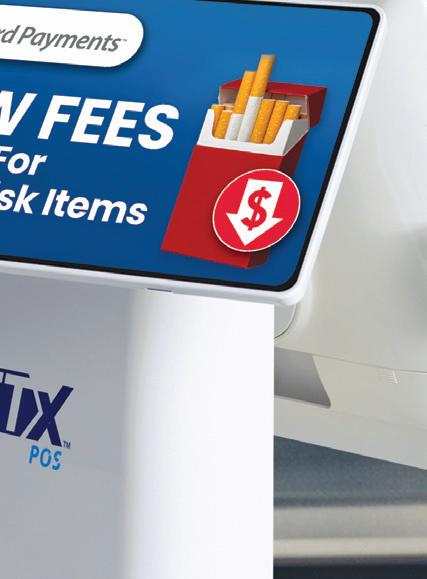









































































Annie Gauthier, CFO/Co-CEO of St. Romain Oil Company (Y-Not Stop), is the 2025-2026 NACS Chairman of the Board. Gauthier will also lead the NACS Political Engagement Committee.
In 2005, Gauthier joined her family company, which now owns and operates 15 Y-Not Stop convenience stores in Louisiana. She created the company’s first human resources role and moved into accounting and finance before succeeding her mother as CFO in 2014. Gauthier and her two brothers have
continued to grow the business since they bought it in 2016.
Gauthier spoke with NACS Magazine about her personal journey into the industry, Y-Not Stop, and her role with NACS for the upcoming year.
WHAT BROUGHT YOU INTO CONVENIENCE, AND WHY HAS IT BEEN A CAREER THAT YOU’VE LOVED EVER SINCE?
I grew up in this business but never wanted it for my career. I fell in love
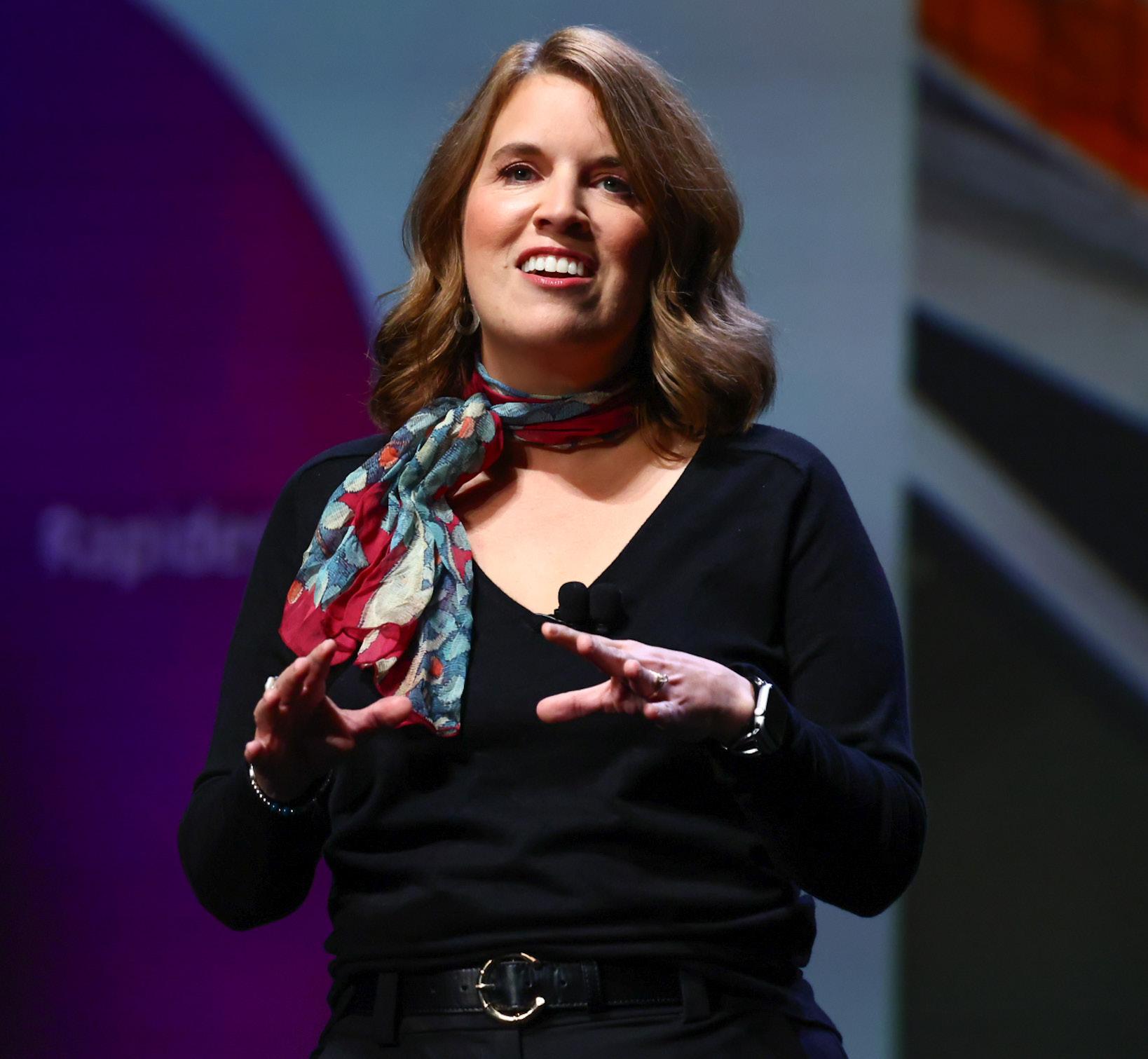
with our industry while I was in college working for the Louisiana Oil Marketers & Convenience Store Association in Baton Rouge. When Hurricane Katrina devastated New Orleans and other areas of the Gulf South 20 years ago, I was wowed by how the industry showed up. In the middle of such uncertain times, suppliers and retailers, like my family, just kept plugging away and working crazy hours to find ways to take care of their communities. Courage, sacrifice and selflessness were everywhere. I love how the convenience industry offers a tangible benefit to every community across the world, making a real difference for our customers and our team members. And it’s a fun business, too! It’s never boring!
WHAT ARE YOU LOOKING FORWARD TO ABOUT SERVING AS CHAIRMAN THIS UPCOMING YEAR? WHAT ARE SOME TOP PRIORITIES ON YOUR MIND FOR THE YEAR AHEAD?
I’m excited to serve as chair in this transitional year for NACS. With the legendary Henry Armour transitioning from CEO to his new international role and past chair Frank Gleeson bringing his unique perspective as the fourth NACS CEO in 65 years, NACS is poised to move boldly into its next chapter. I’m excited to work with the board and staff to continue to build on past successes, to fully realize existing initiatives and to map the future. A successful CEO transition is a priority, and I am confident that it will be smooth
because Henry and Frank both share incredible professionalism, pragmatism and passion for the industry.
WHAT’S ONE OF THE MOST IMPORTANT THINGS YOU’RE FOCUSED ON RIGHT NOW IN YOUR BUSINESS?
I am focused on strengthening our store managers’ leadership and coaching skills so we can build the best workplace and create customer superfans. We’ve made strides the past few years, and we continue to learn and level up.
ON THAT NOTE, TELL US ABOUT THE TEAMFEST YOUR COMPANY HOSTS EVERY YEAR. WHY IS THIS A CRITICAL PART OF YOUR COMPANY CULTURE AND EMPLOYEE DEVELOPMENT?
TeamFest is an annual employee celebration event and training session we host every year. Every team member is invited to join a half-day session and we give them full pay.
The event evolved from all-team meetings my parents started decades ago. Our first TeamFest was in 2017, where we brought in our key supplier partners to share samples and product knowledge with our team. We have expanded it since then to include over 30 partners, as well as games run by our ops team, company updates and team recognition.
At TeamFest, I really want the new team members to learn what we stand for, to connect to what we do and to commit to stay and grow with us. With the right training and support, these new team members are our future. TeamFest is one way we show our love of our industry and connect them to something bigger than themselves and their store.
WHAT’S A MOTTO OR MISSION STATEMENT YOU HAVE FOR RUNNING YOUR BUSINESS?
I believe in moving forward intentionally and optimistically. I frequently quote St. Francis of Assisi: “Start with doing what’s necessary, then do what’s possible, then suddenly you’re doing the impossible.” I also remind myself and others of the competing ideas of “better done than perfect” and “better right than fast.” We are free to choose; we are not free from the consequences of our choices. So choose wisely.
HOW DID YOU FIRST GET INVOLVED WITH NACS, AND WHAT BENEFITS HAVE YOU GOTTEN FROM BEING ENGAGED? WHAT’S YOUR ADVICE TO THOSE WHO AREN’T INVOLVED WITH NACS YET?
I started attending HR Forum and the State of the Industry Summit early in
DECEMBER
NACS Loss Prevention and Safety Symposium
December 03-04 | Hyatt Regency
DFW International Airport Dallas, Texas
2026
FEBRUARY
NACS Leadership Forum
February 10-12 | Fontainebleau, Miami Miami, Florida
MARCH
NACS Convenience Summit Asia March 10-12 | Shanghai, China
NACS Human Resources Forum March 16-18 | Galt House Hotel Louisville, Kentucky
NACS Day on the Hill March 17-18 | Four Seasons Washington D.C.
my career, and then went to my first NACS Show in 2012. I then attended executive education courses in 2015 and 2016. I joined the convention content committee in 2017, the NACS board of directors in 2018, and chaired the retail engagement committee in 2023. Most recently, I served as NACS vice chairman and treasurer.
I’ve benefited from NACS in three key ways: building community among retailers, suppliers and NACS staff; learning about our industry’s challenges and opportunities; and growing as a leader.
My advice to anyone who is not involved yet is simple: if you want to grow yourself and your business, get involved. NACS has something to offer anyone who wants to learn and grow, from events to education to advocacy and more. Attend an event that catches your attention. Meet new people during the networking breaks. Go deeper with acquaintances you’ve met before. Sign up for an executive education course—the three I’ve done were all transformational, and I still keep in touch with people I met there 10 years ago. Interested in serving on a committee? Talk to a board member or staff member to learn more.
APRIL
NACS State of the Industry Summit April 14-16 | Renaissance
Schaumburg Convention Center Hotel Schaumburg, Illinois
OCTOBER NACS Show
October 06-09 | Las Vegas Convention Center Las Vegas, Nevada
For a full listing of events and information, visit www.convenience.org/events.


Registration is now open for 2026 Convenience Summit Asia (CSA), taking place March 10-12 in Shanghai, China.
“Shanghai is the commercial capital of China and one of the most innovative and dynamic markets in Asia,” said George Zheng, NACS director of Asia-Pacific, based in China. The city is home to 25 million people, has a GDP of over $700 billion USD and houses the world’s biggest port, as well as global financial institutions and stock exchanges. “Its character is profoundly shaped by its open, inclusive and innovative nature, and its pioneering spirit makes Shanghai the preferred launch city for global brands and innovation concepts across retail, technology and consumer goods. It’s a gateway to the future of retail, where trends are not just predicted, but created.”
At the summit, attendees will learn about current and emerging trends shaping the future through panel presentations and thought-leadership discussions, hear retailer case studies and share best practices, visit a number of stores in person on the Ideas 2 Go store tours, and network with industry peers and convenience industry leaders.
Store tours will take attendees to the city’s first gas station and convenience store (pictured above), and
they’ll see Shanghai’s unique innovations and their retail applications firsthand—such as food delivery platform Meituan’s commercial drone delivery services; the Neolix Robovan, an automatic robotic van that retailers are using for logistics and supply delivery; cutting edge e-payment systems in retail stores; and automated technologies such as the unmanned CloudPick Store, MiniStore24’s remote store operation system, and Convenience Bee’s store inspection robot. They’ll also experience Shanghai’s booming coffee scene, with over 9,000 coffee shops in the city, making it a global leader in café culture.
“These innovations exemplify how Shanghai is not only adopting global technologies but also redefining them through groundbreaking applications—making it a living laboratory for the future of retail, automation and AI-driven services,” said Zheng.
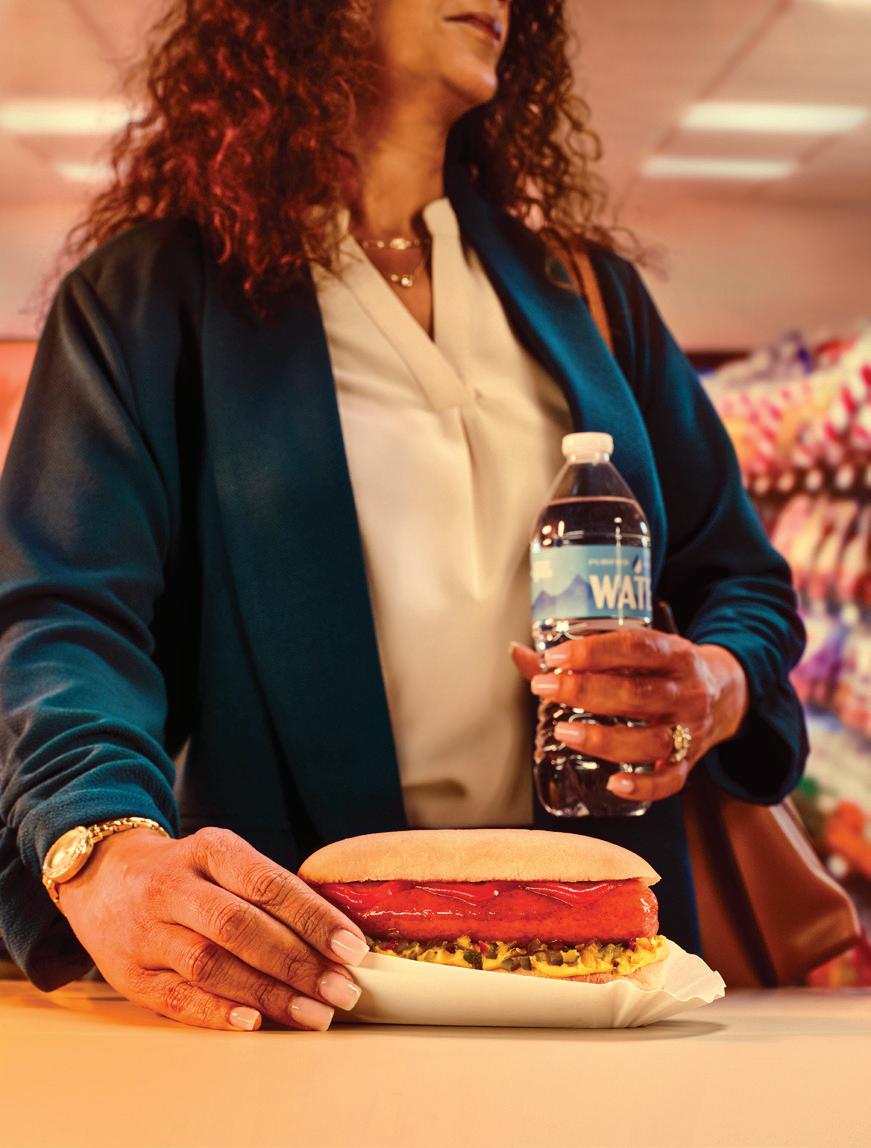








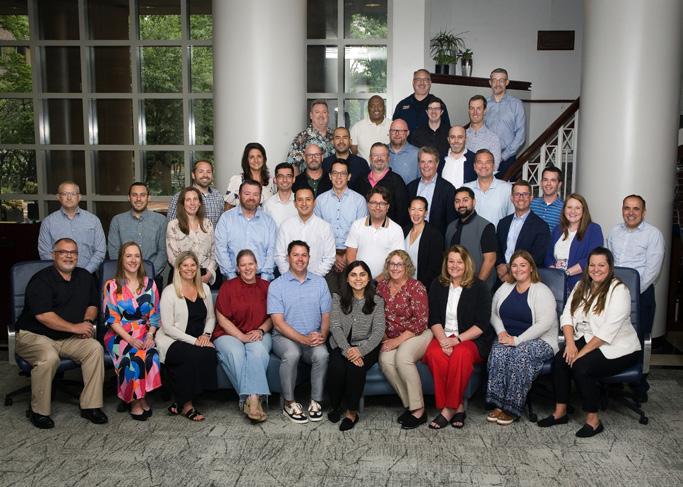
BY BRANDI MAURO, NACS PROGRAM MANAGER, EXECUTIVE EDUCATION
This summer, I had the privilege of attending our Executive Education programs at Wharton, Cornell and Kellogg.
Each program offered a unique experience. At Wharton, leaders sharpened their financial acumen and explored frameworks that can transform how they approach their business. At Cornell, strategy and leadership took center stage, enriched by inspiring stories from Henry Armour and Frank Gleeson. Kellogg brought us together around marketing strategy and innovation, with a powerful reminder that growth takes work—and that even small, intentional steps can drive lasting change.
While the professors’ insights were invaluable, what struck me most were the conversations I had with our members and the ones they had with each other. I learned not only about the challenges they face, but also the creative solutions they are putting into action—like the innovative ways retailers are minimizing the impact of swipe fees by encouraging customers to use debit cards and passing the
savings directly along to them; how retailers are working more closely with vendors and suppliers to use data strategically and strengthen loyalty programs; and the big question every retailer faces—how to win over customers. Location still matters, but today’s game-changers are personalization and differentiation, and technology and AI can help retailers tailor offers.
Beyond the classroom, I was impressed by the energy and openness of these leaders. They came curious, ready to challenge themselves and eager to exchange ideas. They weren’t just learning for themselves—they were investing in the future of their teams and the entire industry.
One story in particular really stuck with me. A member attending his first Executive Education program shared how he was preparing to take over his family business. He admitted feeling intimidated sitting among more experienced leaders, but also energized. He could see what success looks like in this industry, and that vision gave him confidence about his own future.
Hearing members’ stories reminded me why I love what I do. Exec Ed is not just about growing skills and developing professionally; it is about inspiring growth in people and in our industry, and helping our members create a vision for the future of their stores. That’s what makes these programs so special. They give retailers the tools, insights and network to envision what’s next—and the confidence to go after it.
It’s also about personal connections. One of the things I loved most about this summer was the relationships formed during these courses. Hearing stories of members sending kids to college, growing their families, preparing for new roles or stepping into family businesses reminded me that growth happens on multiple levels.
This summer proved something I deeply believe: Executive Education is about more than knowledge—it’s about creating lasting connections, inspiring change and growing both individually as a leader and together as an industry.
To learn more about NACS’ Executive Education programs, reach out to me at Bmauro@convenience.org.





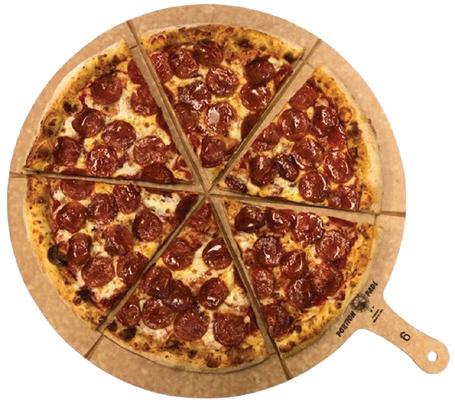



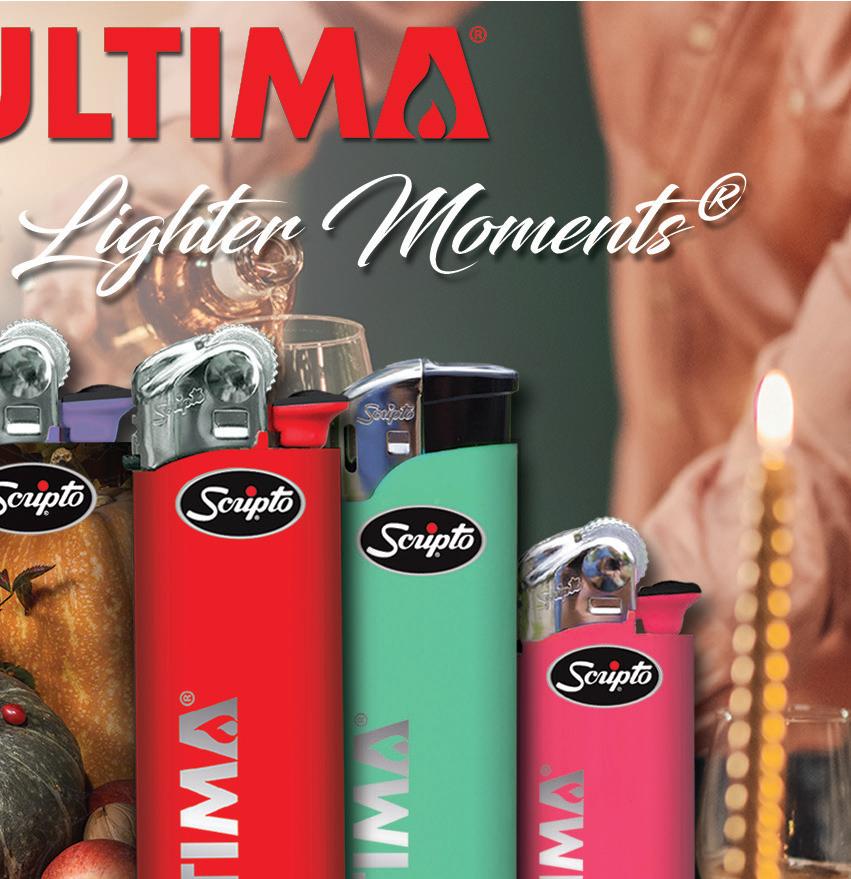



Yesway announced the appointment of Ray Harrison as its new chief marketing and merchandising officer. Most recently the chief marketing officer at Cal's Convenience, Harrison led marketing, merchandising, category management, loyalty programs and communications for more than 500 retail locations. He spearheaded the design and launch of a highly successful digital loyalty program, drove private brand share penetration and implemented innovative omnichannel marketing initiatives across loyalty, social media, delivery and in-store media networks.
Doug Martin was named chief marketing officer at Wawa. Prior to joining Wawa, Martin worked at General Mills for nearly 20 years, spanning multiple roles—most recently serving as its CMO.
Pilot appointed Julius Cox as executive vice president, chief people and administrative officer for Pilot. He leads all aspects of human resources, including attracting, retaining and developing more than 30,000 team members across North America. He also oversees the company’s safety, communications, compliance and procurement practices,
furthering Pilot’s purpose-driven strategy and advancing its people-first culture.
Eva Rigamonti has been named chief legal officer for Pilot. She is responsible for leading all legal functions across several disciplines, including corporate governance, regulatory compliance, government affairs, privacy and artificial intelligence, commercial transactions, and mergers and acquisitions. Rigamonti and her team help Pilot navigate the evolving legal and policy environment and foster strong relationships that shape Pilot’s growth, policy advocacy and compliance strategies.
7-Eleven named Dan Gordan as its senior vice president of fuel supply and trading. In this role, he will be responsible for providing executive leadership over end-to-end supply chain operations, including strategic sourcing, commodity trading, fuel procurement and risk management.

The Hershey Company appointed Natalie Rothman as chief human resources officer. Rothman will lead Hershey's global human resources function and report to President and Chief Executive Officer Kirk Tanner.
Rothman brings leadership credentials as a two-time CHRO and public/private company board member with over 25 years of human resources experience. Prior to joining Hershey, Rothman served as CHRO at Inspire Brands, where she modernized the company's HR operations through business process automation and AI tools.

OPW, a Dover Company, named David Malinas as the company’s new president. He succeeds Kevin Long, who spent 11 years with Dover, including serving as president of OPW since 2017. Malinas most recently served as chief operating officer of Duravant, a global automation equipment company headquartered in Chicago. Prior to Duravant, Malinas served as president of the Industrial Process segment at ITT and held senior executive roles at Thermo Fisher Scientific and Danaher Corporation. NACS in the know—send your updates to news@convenience.org
Keep NACS in the know— send your updates to news@convenience.org

NACS welcomes the following companies that joined the Association in August 2025. NACS membership is company-wide, so we encourage employees of member companies to create a username by visiting convenience.org/create-login. All members receive access to the NACS Online Membership directory and the latest industry news, information and resources. For more information about NACS membership, visit convenience.org/membership.
MAJOR OIL
Sunoco LP Dallas, TX
RETAILERS
Axis Investments LLC Louisville, KY
Cooperative Energy Company Sibley, IA
Fast Eddy's Meridian, ID www.fasteddys.com
Glen Echo Investments Bellvue, CO www.glenechoresort.com
H-E-B Food Stores San Antonio, TX www.heb.com
Jack Flash Effingham, IL www.jackflashstores.com
Manro Stores LLC Miami, FL www.manroenterprises.com
Medford Oil Company Inc. Jerseyville, IL www.medfordoilco.com
Sisbro Energy Inc. Washington, MO
Tri-State Oil Belle Chasse, LA www.tristateoil.com
SUPPLIERS
A2Z POS El Cajon, CA a2zpos.io
All-In Licensing LLC Atlanta, GA www.allinlicensing.com
Alto-Shaam Inc. Menomonee Falls, WI www.alto-shaam.com
Amazon Web Services Seattle, WA aws.amazon.com/retail
Chubby Checker Snacks Conshohocken, PA www.chubbycheckersnacks.com
CO2 Monitoring LLC Las Vegas, NV www.aerospheremonitoring.com
Curtis Montebello, CA www.wilburcurtis.com
Daily’s Premium Meats Kansas City, MO www.dailysmeats.com
Dawn Food Products Inc. Jackson, MI www.dawnfoods.com
DrinkPak Santa Clarita, CA
GLR Inc. Dayton, OH
Hoist Cincinnati, OH www.drinkhoist.com
Izzio Artisan Bakery Louisville, CO www.izziobakery.com
Mockups 4 You LLC Marco Island, FL www.mockups4you.com
Nexii www.nexii.com
Pacific Floorcare Muskegon, MI www.pacificfloorcare.com
Parts Town LLC Addison, IL www.partstown.com
Portland Pet Food Company Portland, OR www.portlandpetfoodcompany.com
RBC Capital Management Atlanta, GA
Reece Distributing Inc. Fruitland, ID www.reecedistributing.com
Schaerer Montebello, CA www.schaererusa.com
Senneca Holdings West Chester, OH
State of PA (Dept of Revenue) Pennsylvania Lottery Middletown, PA www.palottery.state.pa.us
Valtrust Orlando, FL www.valtrust.com
W.A. DeHart Inc. New Columbia, PA
WD Partners Dublin, OH
WMF Fort Lauderdale, FL www.wmfnorthamerica.com






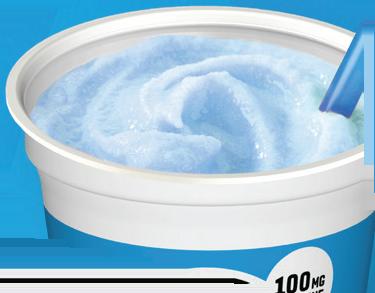

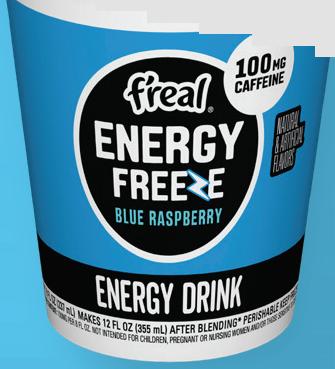








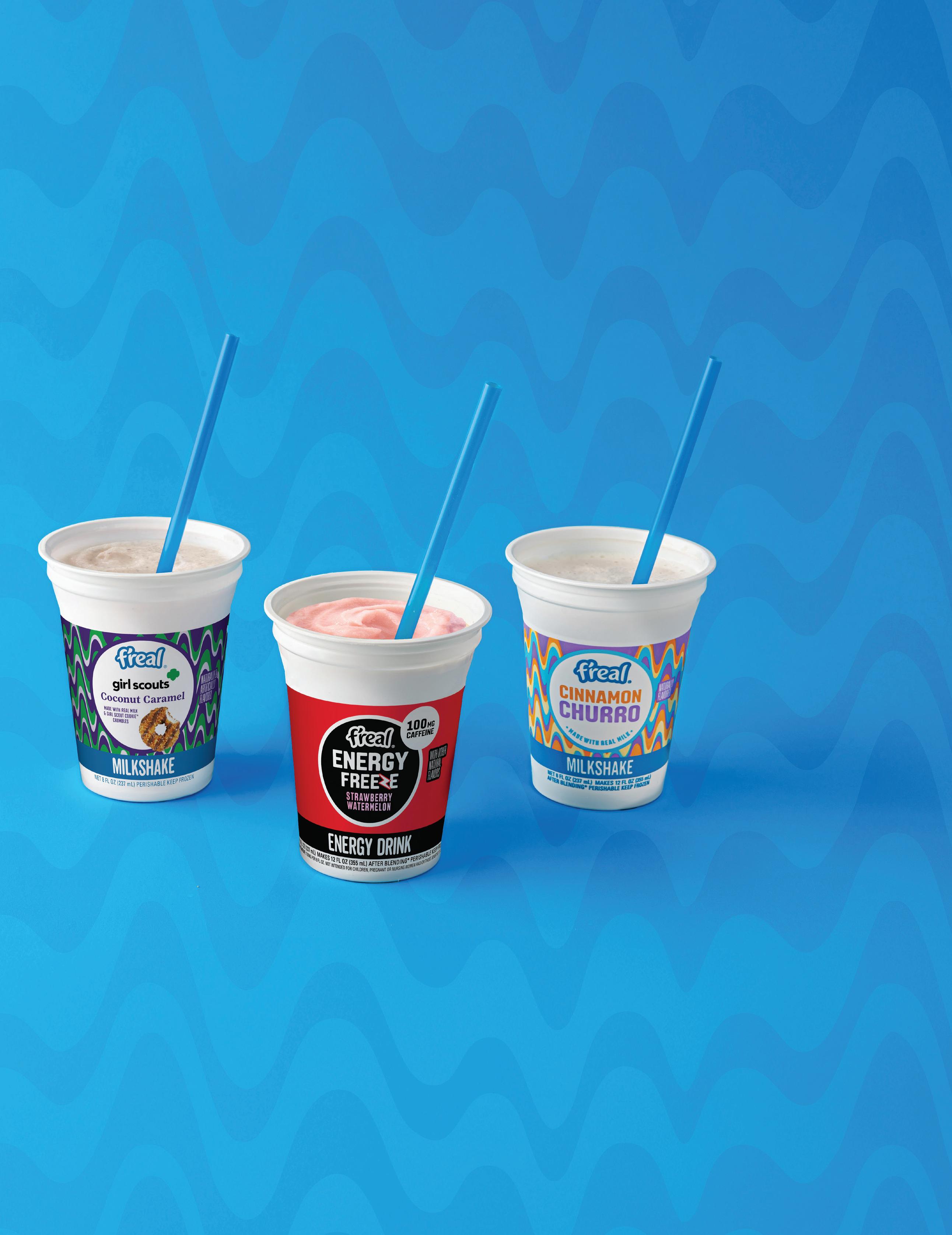


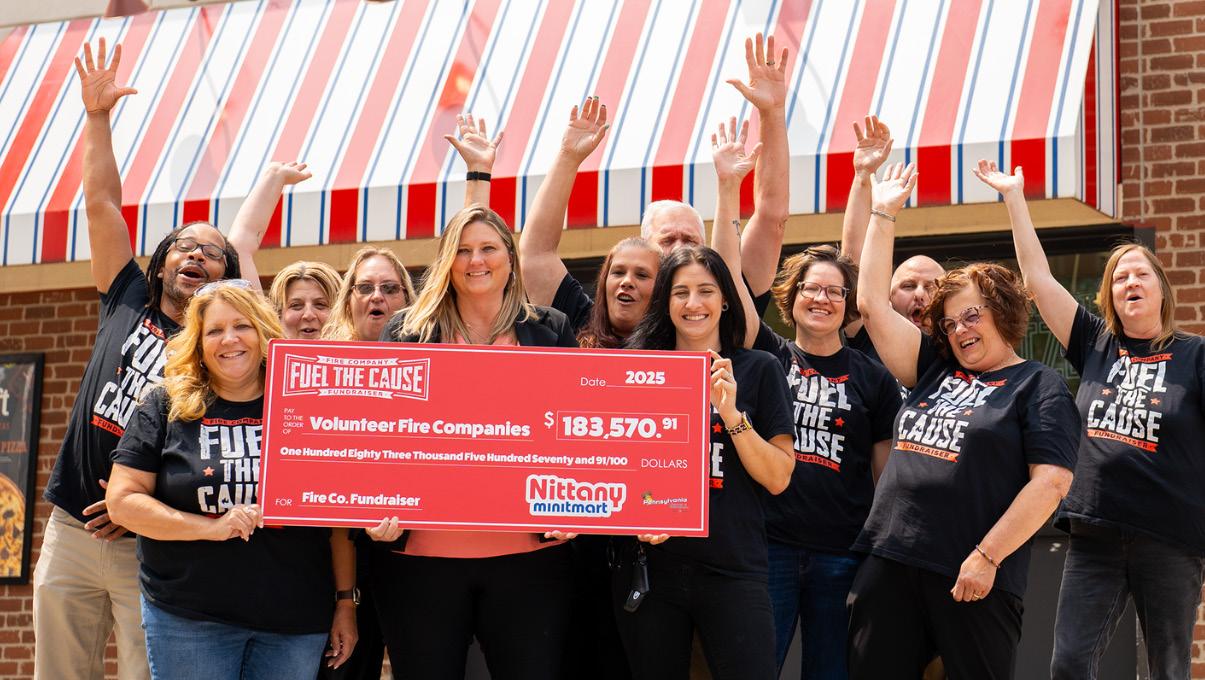
$183,000 to Local
An annual campaign ran from March through June and surpassed last year’s record total by almost $7,000.
Pennsylvania-based Nittany MinitMart’s sixth annual Fuel the Cause campaign raised a record high of $183,570.91 to support volunteer fire companies across central and northern Pennsylvania.
The campaign ran from March through June and surpassed last year’s record total by almost $7,000, bringing the grand total raised since the fundraiser began in 2019 to over $700,000. Nittany MinitMart said this year’s campaign will directly support 40 volunteer fire stations, impacting over 900 firefighters and the 250,000-plus residents they serve.
“We’re thrilled to break another record,” said Nicole Masullo, Nittany MinitMart’s operations division manager. “Every year, we push harder— reaching out to sponsors, promoting the cause
throughout our region and making it easier for customers to get involved. And every year, our community shows up in a bigger way.”
Nittany MinitMart and Pennsylvania Skill Games each donated one cent per gallon of gas sold, along with other partner brands who sponsored the effort. Customers joined in by rounding up their purchases, making donations in-store and ordering from an LTO Firehouse Foods menu, with a portion of all sales from the menu going to the campaign.
This year also marked the second time Nittany MinitMart successfully petitioned the governor’s office to formally recognize the impact of volunteer firefighters. Governor Josh Shapiro declared April 9 through 15 as Volunteer Firefighter Recognition Week in Pennsylvania to raise awareness across the state about the issues volunteer fire companies are facing.




Every year, the convenience retail industry dedicates billions of dollars to advancing the futures of individuals and families in our communities. The NACS Foundation unifies and builds on NACS members’ charitable efforts to amplify their work in communities across America and to share these powerful stories. Learn more at www.conveniencecares.org
$75,000 TO FOLDS OF HONOR
Mirabito Cares, the community engagement arm of Mirabito Convenience Stores, raised $75,000 to benefit Folds of Honor, an organization that provides educational scholarships to the spouses and children of fallen or disabled military service members and first responders.
Texas-based Yesway raised $200,000 to support Texas Hill Country communities impacted by the Independence Day weekend floods—“far surpassing its original fundraising goal” of $100,000. Donations will go to The Community Foundation of the Texas Hill Country's Kerr County Flood Relief Fund.


Parker’s Kitchen presented a check for $360,000 to the Wounded Warrior Project (WWP) to support local injured veterans and their families across Georgia and South Carolina.
Parker’s Kitchen matched 25% of all customer donations during a round-up campaign held earlier this year. WWP CEO Lt. Gen. (Ret.) Walt Piatt accepted the donation at Parker’s Kitchen headquarters in Savannah, Georgia.
The Wills Group, parent company of Dash In stores, donated more than $50,000 to the Folk Memorial Park project in Newark, Delaware.
“[We] will be enhancing a 0.4 mile long walking path, planting a robust garden with herbs, flowers, pollinator beds and fruit trees. All of which are being executed in partnership with the City of Newark Parks and Recreation Department and Ruppert Landscape,” the retailer said.
QuickChek held its Annual QuickChek Golf Outing. “[It] was another unforgettable day on the green—filled with friendly competition, generous hearts and a whole lot of QuickChek spirit! This year, we proudly supported Alternatives Inc. and America's Grow-a-Row, with both organizations joining


us on-site to share how this event directly fuels their missions,” the retailer posted on LinkedIn.
Oklahoma-based OnCue has been named a 2025 Oklahoma Journal Record Beacon Award recipient in the Philanthropic Impact category for its “pivotal role in establishing the OnCue Neonatal Intensive Care Unit (NICU) at Stillwater Medical Center,” according to a press release.
The award recognizes OnCue’s $1 million donation, along with an additional $200,000 raised through OnCue’s specialty cup program and matching event at the Stillwater Medical Foundation gala. The OnCue NICU officially opened in March 2025 and is reportedly the only Level II NICU in north-central Oklahoma.
EG America raised more than $597,000 for the American Cancer Society during its nationwide in-store fundraiser in July. Throughout the month, customers at EG America's Certified Oil, Cumberland Farms, Fastrac, Kwik Shop, Loaf 'N Jug, Minit Mart, Quik Stop, Sprint Food Stores, Tom Thumb and Turkey Hill stores were able to donate $1, $5 or an amount of their choosing to the American Cancer Society at checkout. EG America matched the amounts raised by the top stores.

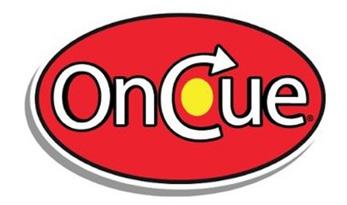


















































































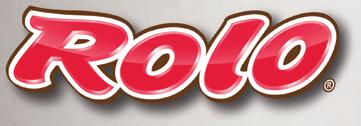










Being about a year out from the next Congressional elections, and with some gubernatorial and state elections happening this month, the NACS government relations team wanted to take a look at where things stand in the efforts to claim the majorities in the U.S. House and Senate next November. A lot can change between now and then, but Jim Ellis from Ellis Insight LLC gives his take on where things stand at the moment.
BY JIM ELLIS
As we approach the 2026 midterm election year, both parties face a substantial electoral obstacle.
Looking nationally, 31 states register voters with their political party affiliation. The Democrats’ significant problem is their party affiliation totals are down in all 31 states, including the bedrock partisan domains of California, Illinois and New York.
The registration figures compare party affiliation percentages from the 2020 presidential election to the present. The Democrats are failing to keep pace with historical trends particularly among younger (those 18-34 years of age) and new voters.
The Republicans also must surmount a formidable hurdle. Seeing the GOP vote percentages consistently drop in special elections around the country this year again underscores that the casual Trump voter is not necessarily a loyal Republican. If said
voter participates in an election where President Trump is not on the ballot, the individual will likely vote the Republican line, but strong turnout within this electoral segment has proven arbitrary.
Therefore, the midterm GOP candidates’ challenge is to energize the Trump base without the president’s name on the ballot, which is apparently a more difficult task than initially presumed.
The current election cycle features 35 Senate races, including special elections in Florida and Ohio. Sens. Ashley Moody (R-FL) and Jon Husted (R-OH), succeeding Secretary of State Marco Rubio and Vice President J.D. Vance, respectively, must run in the 2026 election to fill the balance of their terms. They both would be eligible to seek a full term in 2028.
Republicans will fight to maintain, or possibly expand, their 53-47 Senate majority margin, but from a more difficult political position because they
must defend 22 of the 35 in-cycle seats. The most competitive GOP defensive races are the North Carolina open seat, a newly open seat in Iowa, and Texas, Maine and Ohio, while the Democrats must fight hard to defend their open seat in Michigan and attempt to re-elect Georgia first-term Senator Jon Ossoff.
The North Carolina contest could become the premier national Senate race. Former Democratic Governor Roy Cooper and ex-Republican National Committee chairman Michael Whatley will battle in what promises to be a toss-up affair. Expect Cooper
to maintain small polling leads, but Republicans typically underpoll in the Tar Heel State.
The open Michigan battle will feature Republican former U.S. Rep. Mike Rogers, while the Democrats are embroiled in a hotly contested primary that won’t be decided until August.
The open Wolverine state Senate confrontation, remembering that Rogers lost the 2024 Senate race by only 19,006 votes, is likely the Republicans’ best national conversion opportunity.
The Texas situation will be highly competitive in the Republican primary
their congressional boundaries before the 2026 election.
and general election. The incumbent, John Cornyn, has been trailing state Attorney General Ken Paxton, but recent polling data suggests a tightening contest. The Texas primary is early, March 3. The GOP winner will then likely face former Democratic Congressman and 2024 Senate nominee Colin Allred.
As we know, the House again features a razor thin 220 Republican-215 Democrat majority once the three remaining special elections are completed later this year.
The redistricting issue has become front and center. A U.S. Justice Department directive urging Texas to redraw its map because the 5th Circuit Court of Appeals made several of the state’s minority districts illegal has ignited the partisan gerrymandering argument.
Now, as many as ten other states could redistrict their congressional boundaries before the 2026 election. Extended to its fullest, redistricting could drastically change the House balance of power. In addition to Texas, a special California voter referendum to nullify the state redistricting commission map will be decided in November.
The Ohio legislature must redraw its congressional map due to a state law that allows a map to stand for only two elections if 3/5 of the legislature does not approve. Such was the case in 2021 when the current plan passed with only majority support.
Redistricting may occur in Florida at the beginning of the year, while a Utah judge disqualified the Beehive State congressional map in late
August. Missouri Gov. Mike Kehoe (R) has called upon his legislature to begin redistricting. The process has been discussed in Colorado, Indiana and New York.
The Louisiana racial gerrymandering case before the Supreme Court could result in a landmark decision. Upholding the lower court ruling would mean Louisiana would be redrawn and the decision would also probably lead to Alabama redistricting, as well as validating the new Texas map.
At this point, both parties can win the House majority, and it is likely the new Congress beginning in 2027 will again feature a House of Representatives with a very close majority margin.
A plethora of midterm governors races will be on the ballot this year and next. We start with the 2025 elections in New Jersey and Virginia. Polling suggests that the Democratic nominees, U.S. Rep. Mikie Sherrill and former U.S.
Rep. Abigail Spanberger, respectively, are favorites to win the two open races.
In the regular 2026 election, 36 states will host governor’s races. Of the 38 total campaigns, 19 are open, mostly due to incumbent term limits, and 19 feature incumbents seeking re-election.
On tap are major open races in California and Florida. Vermont Gov. Phil Scott (R) may seek a sixth two-year term, while Texas Gov. Greg Abbott (R) will be on the ballot for a fourth. Declaring for third terms are Govs. Brad Little (R-ID), J.B. Pritzker (D-IL) and possibly Ned Lamont (D-CT) and Tim Walz (D-MN). Eligible to run beyond two terms but declining are Govs. Kim Reynolds (R-IA) and Tony Evers (D-WI).

Jim Ellis is the senior political analyst for the business-industry political action committee (BIPAC) and the creator of the Ellis Insight publication.





































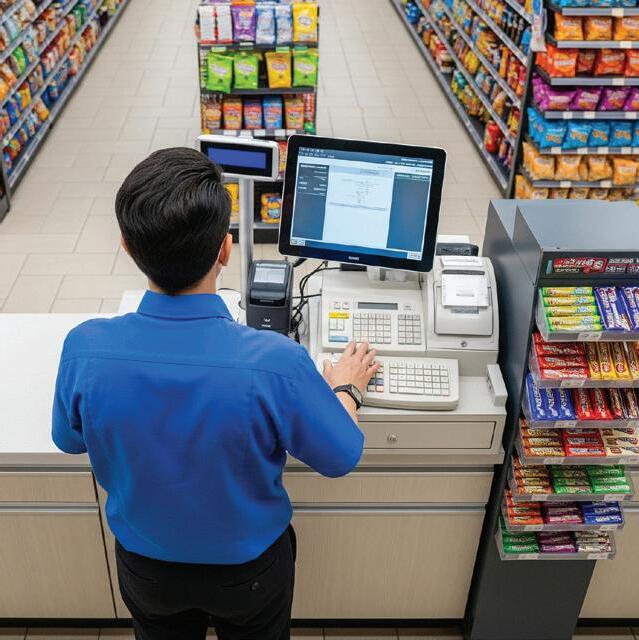















































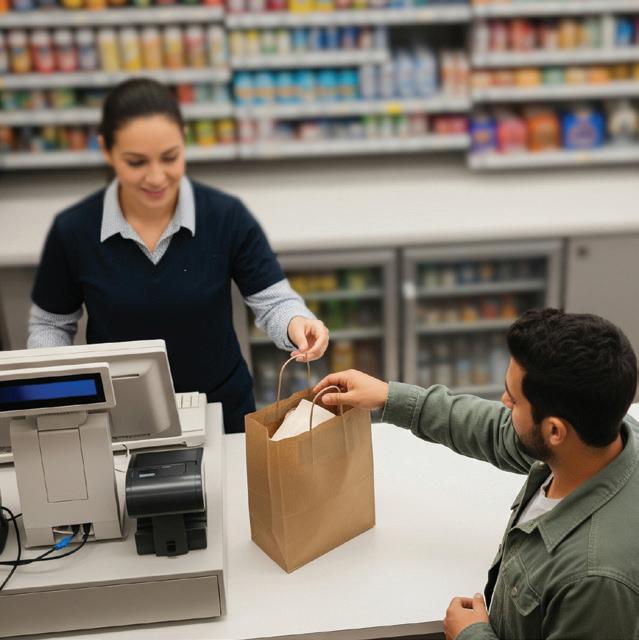




















































































NACSPAC was created in 1979 by NACS as the entity through which the association can legally contribute funds to political candidates supportive of our industry’s issues. For more information about NACSPAC and how political action committees (PACs) work, go to www.convenience.org/nacspac. NACSPAC donors who made contributions in September 2025 are:
Patrick Abernathy Ignite Retail Technology
Karla Ahlert RaceTrac Inc.
Michael Barley Pace-O-Matic
Wynne Barrett Jera Concepts dba Supplyit
Tony Battaglia PMI U.S.
Frank Beard Rovertown
Doug Beech
Casey’s General Stores Inc.
Stace Anne Benu Executive Leadership Solutions Inc.
Matt Bogue Victory Marketing LLC
Ron Brown BF Holdings LLC dba Latitudes
Robert Buhler Open Pantry Food Marts of Wisconsin Inc.
Michael Deal Moyle Petroleum Company
Scott Faber
Casey’s General Stores Inc.
Chad Frazell Casey’s General Stores Inc.
Tony Gaines JOEY
Varish Goyal Loop Neighborhood Markets
Brad Haga
Casey’s General Stores Inc.
Krister Hampton Altria Group Distribution Company
Matthew Hanson Black Buffalo Inc.
John Harris Coulson Oil Company dba Road Runner
Chris Hartman Rutter’s Holdings Inc.
Steph Hoppe
Casey’s General Stores Inc.
Jon Hostasa Casey’s General Stores Inc.
Sam James Casey’s General Stores Inc.
AJ Jha Tustin Arco
Brian Johnson Casey’s General Stores Inc.
Dave Johnson Casey’s General Stores Inc.
David Jordan Jordan Oil Co. Inc.
Paul Kern Invenco by GVR
Leyton Lavigne Lavigne Oil Company
Wolfgang Manz PWM Electronic Price Signs Inc.
Sean McCaffrey GSTV
Steve McKinley Urban Value Corner Store
Phalynn Meeds Haskel Thompson & Associates - Executive Recruiters
Carla Miller Nittany Oil Company dba Minitmart
Scott Minton OnCue Marketing
Nick Paich TriggerPoint Media LLC
Eden Pearson Casey’s General Stores Inc.
Steven Robins Casey’s General Stores Inc.
Kory Ross Casey’s General Stores Inc.
Rick Sales Abierto Networks LLC
Kay Segal Business Accelerator Team
Rajeev Sharma VideoMining LLC
Jessica Starnes Weigel’s Stores Inc. Van Tarver InStore.ai
Nan Thomae
Casey’s General Stores Inc.
Sarah Vilim Keurig Dr Pepper
Joe Vonder Haar iSee Store Innovations
Doug Yawberry Weigel’s Stores Inc
Chuck Young W. Capra Consulting Group












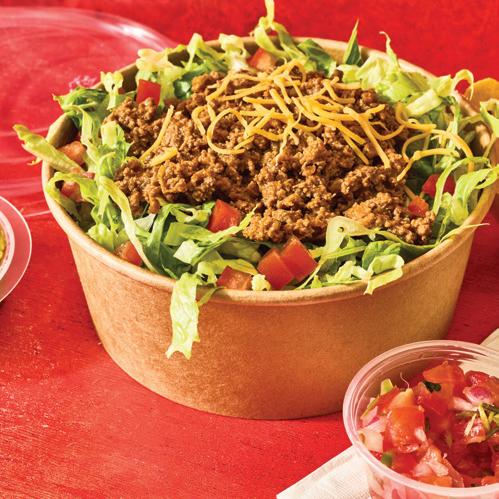


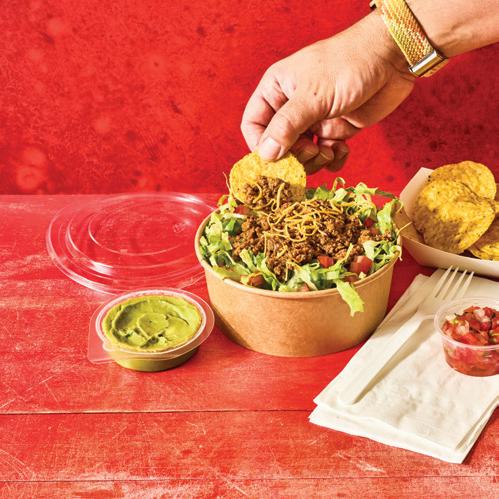



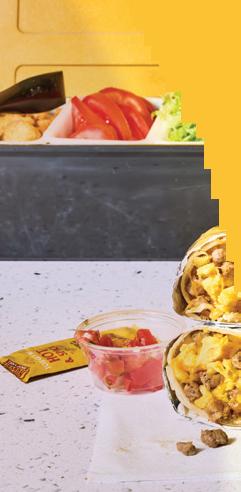


















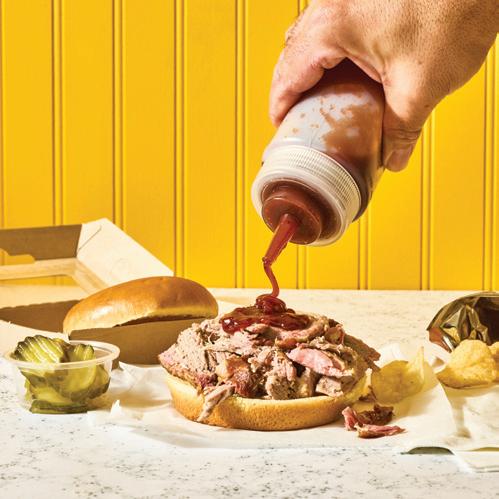




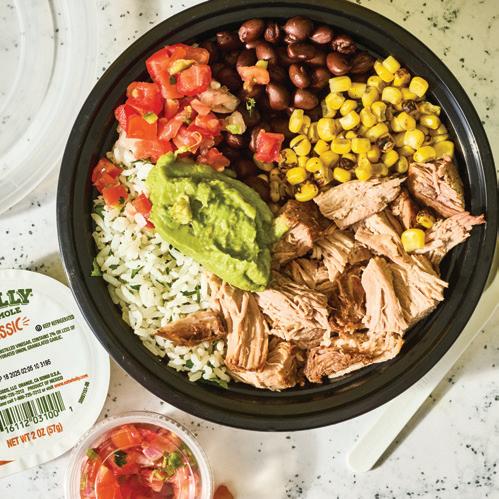


The nine-store Nevada retailer looks for unique ways to build community.
Name of company: Rainbow Market
Date founded: 1982 # of stores: 9 Website: rainbowmarketnv.com
BY SARAH HAMAKER
One of Mark Miller’s proudest moments as a convenience store operator came not from a big sales day, but from a memorable way the store gave back to the community. “My son Nathan wanted to buy shoes for the entire local high school junior varsity basketball team,” said Miller, one of the managing partners of the nine-unit Rainbow Market, which has stores in Las Vegas, Reno and Sparks, Nevada. He and his son wanted to give back in a way that was beyond a typical food or monetary donation. “So we did—[we bought] the nice ones the kids wanted. That’s what I love about this job, the ability to create these community moments. To me, owning a convenience store presents me with opportunities to connect through helping others.”
That’s one of the hallmarks Miller tries to instill at the five stores he runs in Reno and Sparks. Community outreach has been a pillar of Rainbow Market’s culture from the beginning of the family business—Miller’s grandfather-in-law opened the first location in Guam after serving in the military during World War II and the Korean War. Eventually, Miller’s father-in-law moved to Nevada and started the first Nevada
Rainbow Market in 1982, and recently handed over the reins to his daughter, Miller’s wife Lori Miller, who now helms the company as CEO.
While Lori Miller grew up in the convenience store industry, her husband began his career as a teacher. Miller brought his hands-on approach to teaching to running the stores. “I jump in and help no matter what needs doing at the stores, from stocking a cooler to mopping a floor to running a register,” he said. “I will sometimes hear regular customers express surprise when they find me behind the cash register, but because I think it’s a great privilege to run a business that interacts with the community on a daily basis, I’m more than happy to pitch in.”
That mindset has been the foundation of Rainbow Market’s success. “We have competition with larger chains, so we have to try harder to be what our communities need and want,” Miller said. What drives him the most is that “we live here too. There’s no substitute to being part of the community and to invest in the community.” That attention to customers is ingrained in the employees as well. “I’ve been doing this for 30 years and we’ve had
Mark Miller, one of the managing partners for the nine-unit Rainbow Market, listens to customers, staff and family alike when it comes to bringing in new merchandise to the five stores he oversees in Reno and Sparks, Nevada— like when his son Nathan suggested the store start carrying Pokémon cards several years ago. “Some of the general merchandise vendors had gotten out of the game, and it was becoming harder to find suppliers for toys, earrings, sunglasses, etc.
maybe two managers [leave] during that time,” he said. “We pay a good wage and employees know their point of view matters.”
Rainbow Market brings a taste of the islands to landlocked Nevada as a nod to its roots in Guam. Its signature blue branding color creates a “waves” effect on the walls that follows the natural flow of foot traffic through the store. “I came up with the design myself,” Miller said. “We wanted something evocative of waves on the walls to point back to our company’s start on the island of Guam, and we took that idea without getting corny.”

When Nathan came up with the Pokémon idea, I was willing to try it,” Miller said.
The cards became a huge hit, especially when the stores, which are open 5:30 a.m. to 1 a.m., started hosting midnight release parties for exclusive cards. “We would have three to four hundred people show up for these midnight releases,” Miller said. “What I didn’t initially realize was what a community builder carrying these collector cards would be. These trading cards have been a nice way to get to know our neighbors and customers.”
focused on keeping the cooler doors well-stocked. “I didn’t want our staff to think that because we have a beer cave, we don’t have to worry about low [inventory],” he said. “I wanted us to keep on top of the inventory and make sure customers always have the cold drink they want at hand.”
The retailer holds a gambling license that allows it to offer slot machines in addition to lottery. “Because the gaming customers sit there for an hour playing slots, we get to know them,” Miller said. “This allows us to develop relationships with our customers beyond the transaction.”
Since most of the locations weren’t new builds, the owners removed center islands and put the checkout counter against the wall to reconfigure the existing spaces. “We also added a third register to get people in and out more quickly,” Miller said.
Miller eschewed a common c-store staple— the beer cave—and instead
Those relationships are what sets Rainbow Market stores apart. Miller posts his name and number on the wall of the five stores he manages. “I return every phone call I get,” he said. “I want our customers to leave with a feeling of community. You can buy the stuff we sell anywhere, but you can’t buy a sense of community.”

Sarah Hamaker is a freelance writer, NACS Magazine contributor and award-winning romantic suspense author based in Fairfax, Virginia. Visit her online at sarahhamakerfiction.com.
NACS Ideas 2 Go showcases how retailers today are operating the convenience store of tomorrow. To see videos of the c-stores we profiled in 2024 and earlier, go to www.convenience.org/Ideas2Go
Look for more 2025 NACS Show coverage in the December issue of NACS Magazine.

(THAT ISN’T A CIRCUS)

From TikTok (customizing the customer experience) to ‘tick tock’ (giving back time and providing energy), the 2025 NACS Show delivered on its promise.
BY JEFF LENARD
Afew years ago, NACS President and CEO Henry Armour said that the NACS Show could be described as “The Greatest Show on Earth.” It’s a tagline associated with the Ringling Brothers circus, which was on hiatus at the time. While the circus has since returned, the NACS Show demonstrated once again that, at the very least, it’s the greatest four days on the convenience calendar.
More than 25,000 attendees—a record for a Chicago-hosted NACS Show—swarmed a 440,000 net-squarefoot Expo hall, 50 Education Sessions and four days of General Sessions. In addition, the attendees made the most of countless networking opportunities.
Here are few of the big trends from this year.
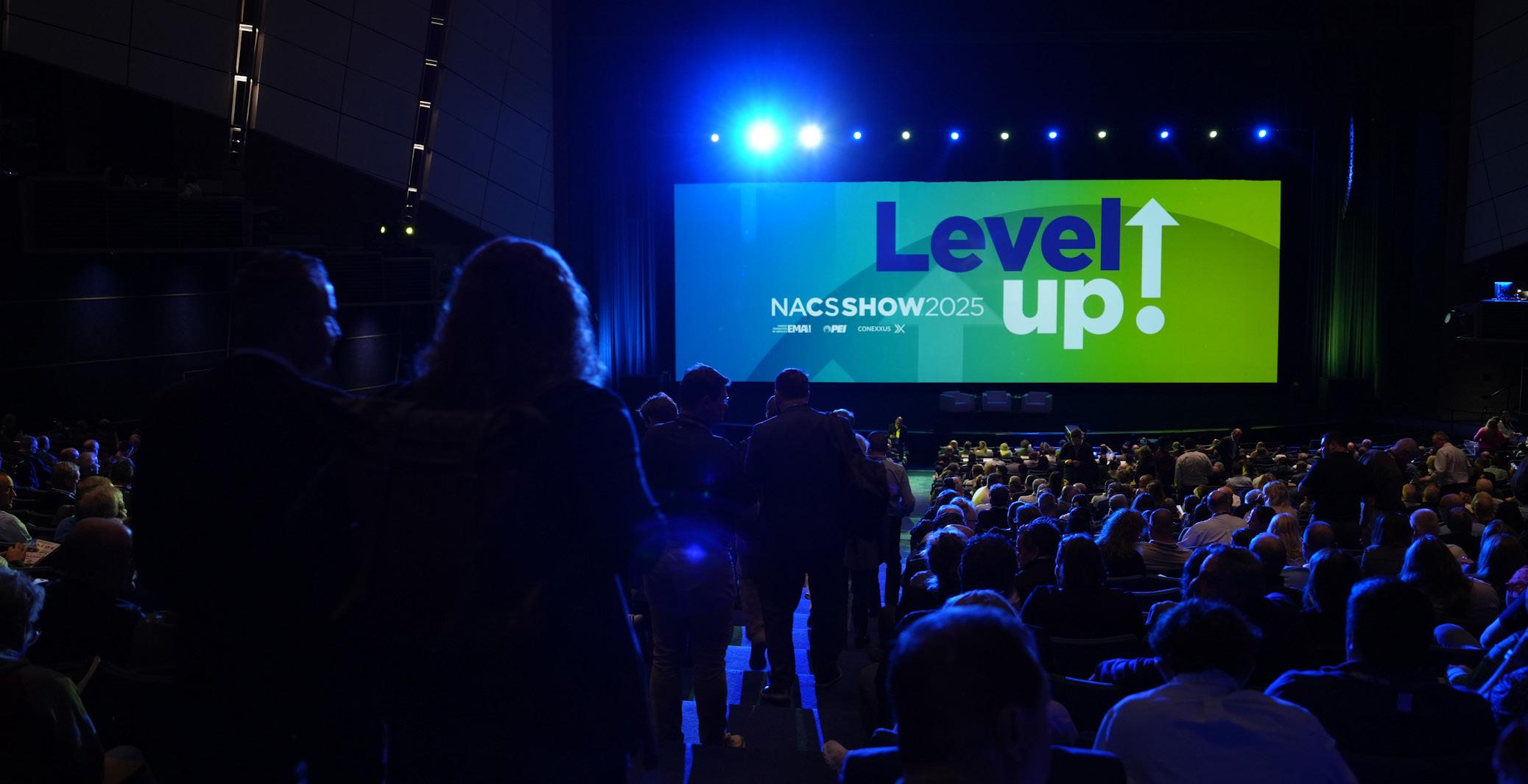
Befitting an industry that conducts well over 100 million face-to-face transactions every single day, customer service was a focus in a half dozen Education Sessions, ranging from enhancing communications skills to leveling up highpotential employees.
The focus on people extended to the General Session stage as well. Incoming NACS President and CEO (beginning in 2026) Frank Gleeson said that he learned how to be a leader attending the NACS Executive Leadership Program at Cornell 20-some years ago. He said that the week-long course transformed how he saw his role as he transformed from a highly competent manager that occasionally had “sharp elbows” to a leader who focused on growing people and teams.
Meanwhile, his fellow panelists, former Alimentation Couche-Tard President and CEO Brian Hannasch and current NACS President and CEO Henry Armour, stressed that culture is what allows companies to accomplish great things, especially when faced with adversity.
NACS Chairman Annie Gauthier (Y-Not Stop stores based on Mansura, LA) said that the company’s TeamFest program, which allows employees to learn more about the company and its values in a fun half-day retreat, is how she seeks to keep and grow newer employees.
“With the right training and support, these team members are our future. TeamFest is one way we show our love of our industry and connect them to something bigger than themselves and their store,” Gauthier said.
And in a NACS Convenience Matters podcast (conveniencematters.com) recorded directly after his General Session presentation, “Clerks” creator Kevin Smith said that customer experience is everything. “You can make a person’s day.… When I was working at the convenience store, I did it with simple acts. … Make sure that they feel better than when they came in.”
When c-stores become that “Cheers” equivalent, where everyone feels like they belong, it creates a fun place to work—and shop.
In the opening General Session, Seb Terry, creator of the 100things Movement, said that when he first defined dreams he wanted to achieve, they were personal—but the focus changed the first time he completed a bucket list dream item that was purely about helping someone else.
“As the cost to culture, morale and performance grows too high to ignore, we must remember: the height of our success isn’t driven only by the strength


At a data conference I attended earlier this year, speakers talked about the looming threat that the TikTok Shop posed to retailers, including c-stores, because items can be ordered directly from videos. Interestingly, it’s not the first time that a Tik Tok shop has been considered a threat to c-stores.
More than 20 years ago a different type of Tik Tok posed a threat when vending machines called the Tiktok Easy Shop popped up in Washington, D.C., selling common convenience items. They were the brainchild of a McDonald’s executive and owned and operated by the QSR.
“It’s the latest achievement in technology’s dubious quest to eliminate the human in human interaction. The machine is robotic, precise, odor-free and utterly without attitude,” wrote The Washington Post in 2002 on the new phenomenon that was drawing local attention.
While the kiosk drew plenty of attention— both good and bad—sales lagged and the concept was modified. Tiktok Easy Shops were made smaller and relocated to the parking lots of local McDonald’s restaurants. In addition, they were given a new name: Redbox. These convenience kiosks featured many of the same items, but were designed to provide fill-in grocery items like bread and milk—plus DVDs. They were featured in the NACS Ideas 2 Go video program at the 2003 NACS Show.
The concept still didn’t last. The kiosks were again reimaged with a singular purpose: to rent videos. This third iteration took off, McDonald’s sold the company, and in a matter of a few years, Redboxes, ironically often at c-stores, were the top distribution channel for DVDs.
How TikTok Shop evolves remains to be seen, but it is certain that this is a trend that NACS will continue to track.


of our actions, but by the depth of our connection to those around us. Put another way, we are strong alone—but we are better together,” Terry said.
The session didn’t just inspire attendees to seek their dreams—it helped two retailers come closer to accomplishing theirs. NACS worked with Terry to solicit goals of attendees and NACS provided the financial support to make two dreams come true: One related to education and one focused on family. (Look for more coverage on their progress in a future issue of NACS Magazine.)
The NACS Foundation also presented its inaugural First Responders of the Year Awards, recognizing the everyday heroes among us. And it helped coordinate food rescue following the NACS Show that delivered over 71,000 pounds of food, beverages and supplies with nine full trucks sent to five local nonprofit organizations. The recovered goods were distributed across these Chicagoarea partners: Greater Chicago Food Depository; Mission of Our Lady of the Angels; Breakthrough; Shepherd’s Hope Food Pantry; and Hands of Hope.
Of course, the Expo focused on products and services that can speed up customer transactions. Artificial intelligence to enhance operational

efficiency, self-checkout and new technologies to help customers order online for in-store pickup were plentiful on the Expo floor. So were beverages and food that delivered energy, including coffee, energy drinks and energy bars. After all, c-stores provide the rocket fuel that propels everyday life forward.
Plenty of products also addressed the reason that people need an energy boast—too little sleep. There were plenty of drinks, tabs and gummies to help people relax and get a great night’s sleep.
Part of the bigger trend to save people time is the continuing growth of functional products. The trend of adding protein to food and beverages has accelerated, with dozens of products packing in additional protein, whether to appeal to timestarved customers or to GLP-1 users looking for a protein-based snack.
And for those who want to adjust their moods, hemp-based products were very noticeable this year, especially in the Cool New Products Preview Room.
TikTok and harvesting customer experiences was a common theme among exhibitors. Many said that they closely monitor social media to see how their products are being used—and whether there is a way to celebrate it and even create new products.

In one example, Van Holten’s had a “TikTok table” where it showcased some of the TikTok-inspired combinations you could try with the pickle—plus one collaboration with Warheads Extreme Sour candy that came to market because of social media posts.
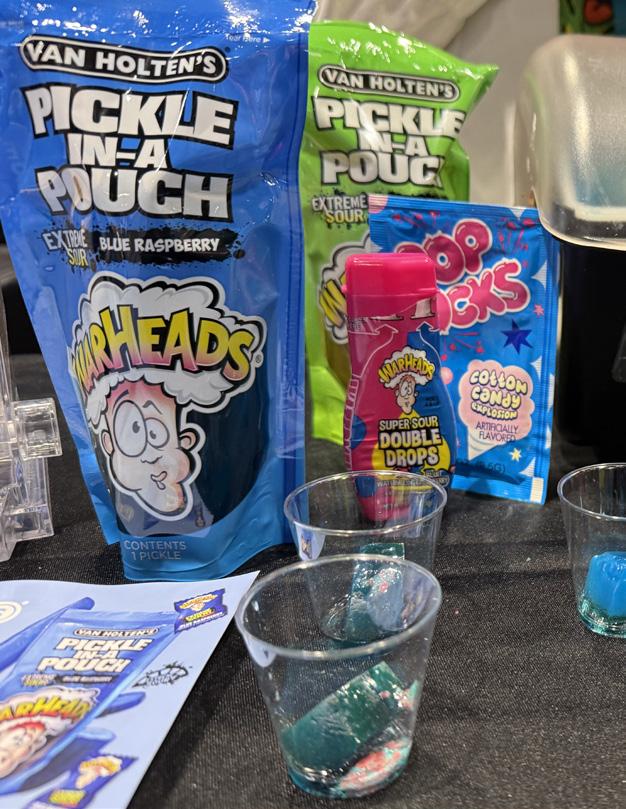
MASH-UPS: 1 + 1 = 3
Van Holten’s and Warheads wasn’t the only collaboration at the Expo. Last year, two of the bigger trends seen on the Expo floor—pickles and freeze-dried items—have gotten together. This year, welcome the freeze-dried pickle.
And mash-ups also extended to companies. Slim Jim and Buffalo Wild Wings combined for a new chicken stick. And Hershey’s and Mondelēz, usually seen as competitors, combined two of their iconic products—Reese’s and Oreos—into new items. NACS has long stressed that the c-store industry is unique because retailers share ideas and help each other. So, it makes perfect sense that suppliers also would work together on the Expo floor.

Given that the previous few paragraphs were about pickles, it’s fair to say that pickles—or more accurately, the pickle flavor—was once again everywhere on the Expo floor, sometimes with a twist. For one, they were joined by olives in some booths, highlighting a “briny snacks” category.
But the pickle is also alive and well as a standalone flavor, including in beer. Pabst Blue Ribbon showcased its new pickle-flavored beer. So instead of calling out for a PBR, will people ask for a PPBR, with the first P for pickle?
The year 1969 featured at least two monumental events: Man landed on the moon and fried chicken was introduced in convenience stores. And while it’s been more than 50 years since man has been on the moon, more than 28% of in-store sales at c-stores today is prepared food, including fried chicken. (See “Foodservice Pioneers” in the August 2011 issue of NACS Magazine for a history of c-store chicken.)
Everyone on the Expo floor had no problem finding ways to sate their appetites with food—or to enhance their operations with new foodservice strategies and programs.

There is only so much space to talk about some of the big trends seen and heard at the NACS Show. Clearly, there is the growing importance of global, something that we will continue to see as Henry Armour transitions to leading the global activities of NACS in 2026. There were also plenty of booths that showcased products for dogs and cats, either in cars or at home. And there was so much fun with new product innovation in snacks.
But most of all, the NACS Show was a clear example of an industry that continues to thrive because it constantly is seeking new ways to delight customers and reinvent convenience.
Jeff Lenard, NACS vice president of strategic communications and media, shared his love for Godzilla in his May 2025 article “Big Ideas From the NACS Convenience Summit Asia.” At that time, he was near a statue. Here he’s next to the real deal at the 2025 NACS Show Expo. (It was real, right?)


The NACS State of the Industry Report® and Talent Insights Dashboard surveys open for participation this winter.
Your data doesn’t just tell a story—it sets the standard for how the convenience and fuel retail industry measures success, identifies trends, and drives growth.
Participants receive valuable benefits:
• State of the Industry Report®:
- 2 complimentary digital licenses
- 1 complimentary State of the Industry Summit registration
• Talent Insights Dashboard: Complimentary enterprise-wide access
Contribute your data and make your mark on the metrics that matter.
Contact research@convenience.org today!





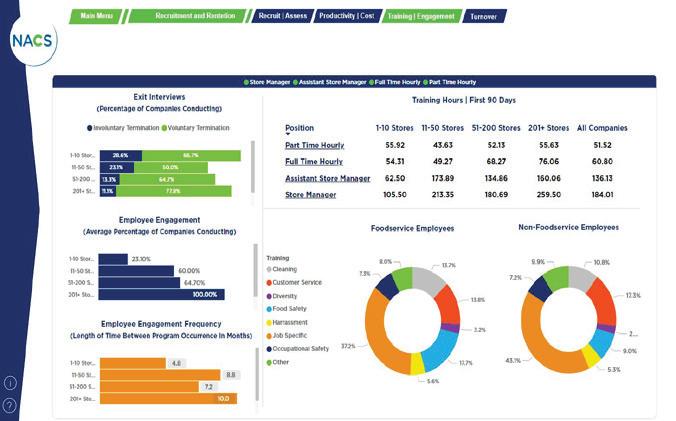









BY PAT PAPE
Chicken of all configurations—tenders, wraps, wings, sandwiches, nuggets—is an increasingly hot category.
According to Datassential, the number of limited-service chicken restaurants expanded by nearly 5% in 2024, and sales jumped almost 10%. A 2025 Technomic chain report found that chicken is the second-fastest-growing restaurant category behind beverage/snack chains.
Among QSRs, McDonald’s recently introduced McCrispy Chicken, its first permanent new menu item in four years, and brought back its crispy chicken Snack Wrap; Taco Bell revived Crispy Chicken Nuggets for a limited time and expanded its chicken offerings overall; and Culver’s said it improved the fillet on its chicken sandwich, which comes crispy, spicy or grilled.
Proving that people love chicken on their table and also in their portfolio, the 300-unit Dave’s Hot Chicken—Nashville-style chicken that popped up in a Los Angeles parking lot eight years ago—recently sold to private equity firm Roark Capital in a deal valued at $1 billion.


The Market stores, owned by Charlottesville, Virginia-based Tiger Fuel, have developed a successful foodservice program, but the retailer didn’t put chicken on the menu until it acquired a location that already offered it.
After tweaking the original program,
The Market now sells bone-in chicken and tenders, along with potato wedges, mac and cheese, green beans, mashed potatoes with gravy and occasional specials. “The big thing is our Tiger Sauce,” said Nico Robinson, culinary program manager at The Market.
“Tiger Sauce has a good amount of tang, but it’s not spicy. People tell us it’s better than [Raising] Cane’s sauce.”
To produce a Southern fried chicken like The Market’s, “you have to have the crispy, you need the flake, and it’s got to have the snap when you break into that skin,” said Robinson. “If everyone follows the system and doesn’t take shortcuts, it comes out amazing. We’re fortunate to have great people who do that every day.”
The Market manages a tremendous catering business. Although most catering orders are for box lunches with sandwiches, the stores also fulfill large orders of chicken. “We package the chicken in foil that has holes to vent the steam so we don’t lose our breading, and we transport the order in our Market-branded carrying cases, which look a little like a pizza bag,” Robinson said. “We
after three hours, and it tastes just as fresh as if it just came out of the fryer.
deliver it to the customer and set it up for them, making sure they are stocked with utensils and everything they need.”
In 2020, 7-Eleven rolled out its Raise the Roost Chicken & Biscuits concept, which features made-from-scratch, hand-breaded, fried chicken tenders; bone-in and boneless wings; and chicken sandwiches, including chicken breakfast sandwiches and burritos, that are made to order or available as graband-go options.
“We developed Raise the Roost to meet the growing demand for high-quality, restaurant-style food in a convenient setting,” said William Armstrong, senior vice president of restaurant operations and innovation at 7-Eleven. “Chicken is one of the fastest-growing menu categories in the U.S. restaurant sector, and customers increasingly expect quick-service options that don’t sacrifice flavor, freshness or quality.”
Currently available in 116 7-Eleven stores across 18 states, the program aims to deliver chicken favorites with a focus on freshness, flavor and speed. “What makes the program work long term is our commitment to continually evolving the menu and introducing craveable, on-trend products and LTOs to surprise and delight our guests,” Armstrong said.
Winning LTOs for Raise the Roost have included a hot honey chicken biscuit and chicken sandwich, cobranded in October 2024 with Mike’s Hot Honey, and spicy versions of the chicken biscuit and chicken sandwichduring the summer.
“Launching a successful chicken program requires more than great food—it takes consistency, speed and a standout guest experience that captures attention and turns first-time trial into long-term loyalty in an already crowded category,” Armstrong said. “We continue to evaluate new formats and flavors as part of our broader food innovation strategy.”
Turnkey programs are solutions for c-store retailers who want to offer hot, ready-to-eat chicken meals without starting a proprietary program from scratch. The programs typically provide chicken, sides, equipment,
marketing, training, supply chain support and menu development.
Chester’s Chicken began serving c-stores in the late ’80s and is now available in 1,100 locations. The operation was created with limited space in mind.
“Retailers need a merchandiser to hold chicken, the fryer, a prep table, the proper amount of refrigeration, storage, freezer space, a small Cadco oven, about 400 square feet of kitchen space and 60 square feet of counter space,” said William Culpepper, vice president of marketing for Chester’s International. “Some operators put the fryer in the back of the house and bring the fried chicken out to the merchandiser. Some put it behind the merchandiser, which lets customers see the process. It does require some dedicated staffing, especially during busy times and preparing for the lunch rush.”
The program is especially attractive to small and midsize operators. “They understand that foodservice will drive their business,” said Culpepper. “We come in and become an extension of their team.”
At the NACS Show in October, Chester’s unveiled a new merchandiser dubbed the Krispy Station, which can hold hot chicken and prepackaged sides for up to three hours—two hours longer than the hold of the company’s previous hot box.
“Take a tender out of there after three hours, and it tastes just as fresh as if it just came out of the fryer,” Culpepper said. “It improves product quality, provides a better experience for the customer and is less expensive than the unit we sold previously. We’re also excited about our new fryer, which has two baskets. It lets stores fry two items at one time and cook in small batches.”
The new technology was tested in two Break Time stores, the convenience brand owned by Columbia, Missouri-based MFA Oil, and received two thumbs-up from store management. “When a customer ordered a meal in the past, you had to stop the process and cup up small side items, lid them and box it,” said Roger Hudson, senior foodservice manager at Break Time. “With the new equipment, the sides are already in the case,
Turnkey programs are a great solution for c-store retailers who want to offer hot, ready-to-eat chicken meals.
and it takes about half the time to pack the customer’s meal than it did before. We hope to roll this out to our other stores soon.”
The Krispy Krunchy Chicken program features hand-breaded, Cajun-spiced fried chicken; all-white-meat tenders and nuggets; and honey-butter shrimp and biscuits, plus sides. No specific store footprint is required, but each store needs room for a hood, an 85-pound fryer and a hot food case. Krispy Krunchy provides comprehensive training for store staffers and marketing and point-of-sale materials. “It’s the easy button for operators,” said Joe Gordon, chief supply chain and technology officer at Krispy Krunchy. “It’s a turnkey program and we come in with everything from equipment to product to

Be sure to get the right equipment. … Not investing in the right equipment will cost you down the road.
lift from retailers [to start their own foodservice program]. We design our products to be simple to execute in a c-store, while also being top of the line, gold-standard products that can compete with any restaurant out there.”
Krispy Krunchy Chicken introduced chicken nuggets earlier this year after determining they were a high-demand item. Locations that have added nuggets are selling an average of 7.8% more poultry than stores without nuggets, according to Krispy Krunchy’s data. The company said it has done extensive research and user testing to develop its menu and focuses on designing a program that’s specific to c-stores. According to company data, operators that add Krispy Krunchy Chicken see foot traffic increase 10-12% and merchandise sales increase 15-20%.

Broaster Co. offers two branded, trademarked programs, Genuine Broaster Chicken and Broaster Express. Like most turnkey programs, Genuine Broaster Chicken uses fresh chicken, but Broaster Express relies on frozen products, which are simple and more convenient for c-stores, said Katie Klaus, senior marketing manager at Broaster. The programs are in 5,000 locations today, with about 20% being Broaster Express and 80% Genuine Broaster Chicken.
“With a fresh chicken program, operators run the risk of ordering too much chicken that expires before it’s used,” said Klaus. “Plus, fresh chicken requires stringent food safety practices due to the increased risks of foodborne illness, which some smaller stores may not be prepared to execute.”
Broaster Express requires four square feet on a back counter for the program’s ventless fryer. No hood is necessary in most municipalities, a key benefit of the program. C-stores can operate the program as a madeto-order concept or put a merchandising case on a front counter, allowing customers to grab precooked products.
“C-store operators can add Broaster Express for as little as $14 per day, with as few as four menu items,” Klaus said. “With Broaster Express, the operator chooses which items to offer, ensuring the flavors and product mix are what their customers crave.”
The McLane Company recently launched its first branded chicken offer,
HiBird. The program is designed for graband-go offerings and includes fully cooked chicken filets and strips, as well as sides of white cheddar mac and cheese and potato wedges. The chicken can be cooked either in an oven or fried, said Farley Kaiser, senior director, culinary and innovation, The McLane Company.
Each day, Love’s Travel Stops feeds thousands of road warriors with a combination of proprietary foodservice offerings, turnkey programs and a range of QSRs.
“Customers want fast, fresh food offerings on the road that are also affordable,” said Wade Arthur, senior manager of food operations at Oklahoma City-based Love’s. “It’s important for those items to be portable and easy to eat on the go. Love’s offers Chester’s, Bojangles, Hardee’s and Carl’s Jr., depending on the location. Love’s Fresh Kitchen offerings include chicken tacos, chicken salad wraps and spicy chicken drumsticks.”
For a retailer that wants to add chicken items to its menu board, Arthur stressed the importance of food safety and training team members to follow proper procedures, especially when working with hot oil and fryers.
“We also understand the importance of prep work,” he said. “Breading, seasoning and frying food, frequent restocking and cross-training team members to handle both prep and service is essential for standardizing processes that reduce points of friction and improve consistency for customers.”
No matter which program a retailer chooses, it’s important not to cut corners, Robinson said. “Be sure to get the right equipment,” he said. “Not investing in the right equipment will cost you down the road. Make your process as simple as it can be. The [finished product] may not be right the first time, but continue to try it. As successful as our chicken program is, we still go back frequently to review it. Chicken is amazing.”

Freshchickenrequiresstringentfood safetypracticesduetotheincreased risksoffoodborneillness.

Pat Pape worked in the convenience store industry for more than 20 years before becoming a full-time writer. See more of her articles at patpape.wordpress.com.
BY LAUREN SHANESY

Demand from consumers for more sustainable foodservice packaging has increased in recent years as many begin to consider their carbon footprint and environmental impact.
“More and more, consumers are seeking sustainable packaging options that align with the values of the foodservice businesses they choose,” said Mark Medovitch, content manager at Inline Plastics.
According to the Food Packaging Institute’s (FPI) latest Consumer Perceptions Survey & Report, the top environmental concern consumers have about packaging is that single-use items will end up as litter on land and in waterways.
“This is something we have grappled with for a long time because of the tangible, emotional relationship people have with foodservice packaging. They see the coffee cup they get every morning on their way to work as litter on the side of the road and start to correlate it with waste,” said Natha Dempsey, president of FPI, while speaking at IDDBA 2025. But in actuality, she said, foodservice packaging is a very small portion of the waste stream—less than 2%. “About 98.5% of the waste stream is other stuff [such as plastics, food scraps, paper, metals, textiles, yard trimmings, etc.]. But people don’t have that tangible feeling for those items the way they do with things they put in their own trashcan.”
Charlotte McMullen, chief operating officer at Ronpak, said BPI compostable status is being sought and requested by
consumers, who value environmental claims and view them as a positive message. “There is also still an emphasis on recyclability and lighter content substrates, and natural substrates are largely replacing bleached white alternatives due to environmental impact and cost,” she said.
However, having food packaging that is recyclable or compostable isn’t as straightforward as it seems. Many products are multi-material, so while they may have sustainable or eco-friendly elements, they often don’t make it through the entire material recovery process.
There has been a move toward using more molded fiber and paperbased products that are marketed as compostable, particularly for hot food applications, said Medovitch. “However, most of these items include a thin plastic liner to provide moisture resistance and barrier protection. That liner means they are not truly compostable and instead end up in landfills where they generate methane emissions.”
He said that there has been increasing demand for post-consumer recycled (PCR) materials, which when used in PET packaging “not only maintains recyclability but also preserves key benefits like barrier protection, extended shelf life and food safety when paired with proper sealing. This makes PCR a far more practical and impactful path toward sustainability.”
Proper packaging, even if not made with eco-friendly materials, can impact sustainability in other ways

and help reduce in-store waste, said Kurt Richars, director of market development and sustainability at Anchor Packaging. “High-performance packaging keeps food fresh longer, which reduces shrink and lets staff stock displays ahead of peak hours. It also supports hot-to-cold case flexibility, so unsold meals can safely move to the cold case instead of being thrown away.” He also noted that new innovations in design—like new singlepiece containers that use the same part for the base and lid—can simplify handling, eliminate base-lid miscounts, cut storage needs and limit the number of products retailers must inventory.
“Cutting waste isn’t just about throwing less away—it’s about saving labor, protecting food quality and increasing efficiency to boost profit. The right packaging makes it happen,” he said.
Looking ahead, Medovitch said he expects to see stronger demand for solutions that are “truly sustainable. … Packaging that can actually be recycled and that fits seamlessly into existing waste streams will be critical.”
FPI’s Dempsey added that having sustainable packaging options will continue to be key as states introduce policy or regulations regarding single-use plastics. As of May 2025, there were around 180 proposed pieces of legislation relating to foodservice packaging in 30 states, she said.
And while eco-friendly materials are an important feature because of consumer perception and demand,
what’s more critical is the performance of the packaging product.
“Performance that protects food quality must come first: preventing leaks, preserving presentation and maintaining temperature. The good news is operators don’t have to choose between performance and sustainability. Materials like PET, PP and paperboard deliver both the performance that protects the food and the recyclability that consumers prefer,” said Richars.
Medovitch also said that food safety is a top priority for many consumers and retailers. “Tamper-evident and tamper-resistant packaging has become an expectation, giving customers confidence that their meals are protected and safe to eat.”
Retailers should remember that foodservice packaging “isn’t just something that holds a meal—it’s a powerful tool to unlock profitable foodservice growth. It protects the investment you’ve made to win a customer, shapes their perception of value and can streamline your operations,” said Richars. “Retailers should view packaging as a tool for customer retention and operational efficiency. High-performance packaging creates consistent quality, operational savings and a path to profitable, scalable foodservice growth.”
Customers eat with their eyes, said Kurt Richars, director of market development and sustainability at Anchor Packaging. “When customers see, you sell more,” he said. Clear packaging that showcases the freshness and quality of food and enhances presentation can impact a sale, manufacturers agreed.
“Creating a highly visible, appealing display converts more visitors into foodservice customers. Also, because many customers only have minutes to spend in the store, enough food must be ready-to-go. Retailers win when packaging delivers both presentation and performance—capturing impulse sales today while creating repeat business that fuels foodservice growth,” said Richars.
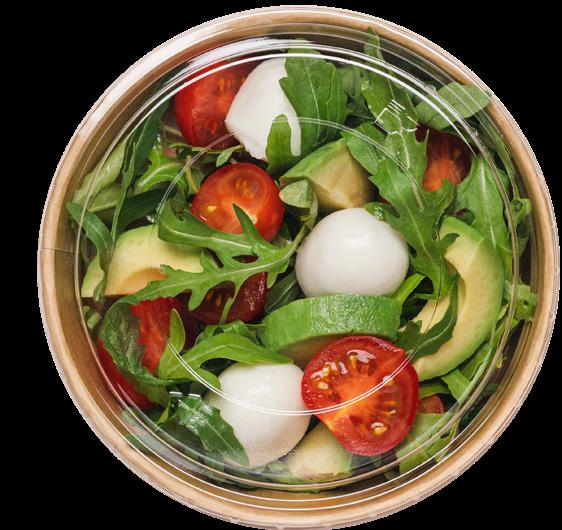
To learn more about NACS Global, including upcoming events, visit convenience.org/global.


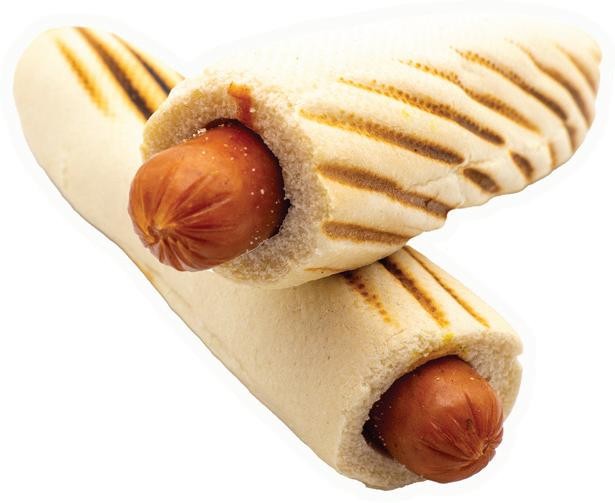

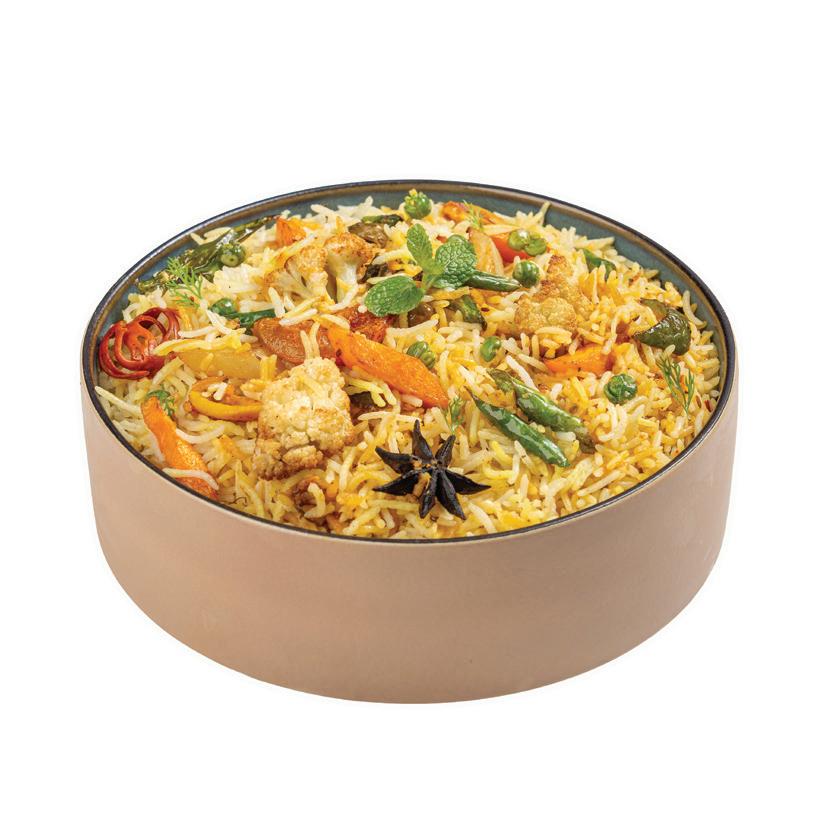


BY LAUREN SHANESY AND LEAH ASH
Convenience foodservice continues to undergo an evolution worldwide. According to experts, the same trends that are so visible in the United States are impacting foodservice globally. That includes c-stores becoming more of a destination for fresh offerings across all dayparts; a marriage of grab-and-go and prepared on-site meals; an emphasis on technology; and global borrowing, as c-store operators look outside their own national borders for best-inclass ideas.
There’s great opportunity in foodservice for convenience retailers, said Dan Munford, CEO of Insight Research and a NACS relationship partner based in the United Kingdom, as “c-stores hold a price advantage over quick-service restaurants, making them attractive for budget-conscious consumers. They also really value the efficiency of c-stores being a one-stop shop.”

Boundaries are blurring, and some consumer trends cover the market no matter what country.
“Consumers increasingly favor bold, global flavors—think spicy offerings like sriracha, sambal and harissa—as well as fresh, better-for-you options such as customizable, plant-led items. Innovation is key: Items that are social-media-friendly, affordable, and health-conscious are steadily rising in popularity,” said Munford.
But while the global convenience industry gets better at foodservice as a whole and begins to cross intercontinental lines,

In Scandinavia and Denmark, train stations make up about half of the convenience store market, said Magnar Møkkelgård, a NACS relationship partner based in Norway. “There is a lot of competition from small-format and discount grocery stores, so convenience stores in this region are primarily traditional gas stations and quick, grab-and-go stores in transit hubs.” This has positioned convenience stores as a destination for the “one-second customer,” he said. “The train doesn’t wait for the commuter, so graband-go, speed of service and easy packaging are all really important. We have what we call the ‘single-handed customer’ so you have to have products for that traveler on the go.”
Convenience stores in this region don’t have large kitchens, which impacts their foodservice models. “Some things such as hot dogs, bakery products and sandwiches are made in store by the staff, especially at gas stations, while take-home products such as salads come from a commissary and get distributed to the stores,” he said.
“The train doesn’t wait for the commuter, so grab-and-go, speed of service and easy packaging are all really important.”
regional trends, culture and staple foods still define individual foodservice markets around the world.
From historical German foods that everyone knows and loves that now have snack versions in c-stores to the success of South American coffee programs to the prevalence of QSR partnerships in Asia and the Middle East, here’s what’s trending, what’s working, and where opportunities await for retailers across the world to be on the forefront of convenience foodservice.
Another trend in this region—healthy foods and demand for “trending items,” said Møkkelgård. “7-Eleven Denmark has partnered with small, trendy restaurants and startups. They’ve actually gone so far that they have become mentors of sorts, where if they think the startup has commercial potential, they help them along by giving them distribution in 7-Eleven. This has been huge for 7-Eleven’s differentiation in the market.”
In Scandinavia, healthier items are “taking up much more space in convenience stores compared to the U.S. Salad bars have become a huge thing in Sweden in particular,” he added.


Bakeries are extremely popular, and c-stores have capitalized on the trend, often bringing in items half or fully baked that are frozen and then baked fresh on site. “Each country has a favorite—in Denmark it’s the croissant, in Sweden it’s the cinnamon bun, while in Norway it’s the raisin bun,” said Møkkelgård.
He also noted that consumer concerns over sustainability have impacted food packaging in particular. “Everyone is trying to move away from the use of plastics and is
offering wood or cardboard wherever they can. There’s a huge tax on plastic shopping bags, so everyone brings their own. The whole convenience business now looks at the use of resources as a whole—there’s been some interesting discussion around red meat. Reitan Convenience in Sweden started using alternative meat in hot dogs and had a lot of success selling chicken hot dogs. Their angle was primarily sustainability and health, and the customer liked it,” he said.
There’s significant potential for foodservice growth in Germany, said Christian Warning, owner of The Retail Marketeers and a NACS relationship partner based in Germany. There are 14,000 convenience stores and gas stations in the country, but the industry only captures about 1% of the away-from-home food market, or about $1 billion. “This is because of the high-density city centers and prevalence of supermarkets and bakeries. But gas stations have two big competitive advantages: our locations and our people. We have the consumers coming to sites and we have a ‘one-stop shopping’ model, so we have a lot of room to grow the foodservice market.”
One of the most popular c-store food items in Germany is bockwurst, a steamed sausage that’s a staple in the northern and eastern regions of the country. “The convenience channel owns more than half of the bockwurst market, and they’re very easy to make because you just put them in a steamer.”
Fransk hotdogs from the Nordics, which are hotdogs that are inside a roll (usually a French baguette or a pretzel roll) and therefore are easy to eat one-handed, are “one of the most successful and best on-themove convenience store and gas station foodservice products,” he said. “Every third driver in Norway is buying this hotdog. You can put sauces inside the roll and they’re much easier to drive with. They’re extremely common in Norway, Denmark, Sweden, and also in Switzerland.”
Leberkassemmel, a version of traditional German leberkäse, a meatloaf of sorts made from finely ground corned beef, pork and bacon, has emerged as a popular c-store snack. “Imagine a thick, warm slice of this baked meatloaf wedged into a fresh, crusty bread roll. It’s often served with a dollop of mustard. It’s the ultimate German street food and is perfect for a quick, filling meal on the go. It’s a staple of Bavarian fast-food culture and a popular ‘second breakfast’ for many,” Warning said.
Pretzels are another top-selling item in German c-stores. “We invented the pretzel. It’s everywhere.”
Additionally, some c-stores along the autobahn and truck stops in particular have added seating or partnered with

popular QSRs for foodservice. “That’s typical for those highway exit stops, while traditional convenience stores are more focused on coffee and grab-and-go type items.”
“I’d encourage convenience retailers to focus on the fundamentals that consumers

Argentina, like many countries in Latin America, has a legacy of c-stores that were owned by large oil companies, where the customer was the car and its engine, and not so much the passenger, said Claudio Reboredo, partner at FGC Fuels Marketing and a NACS relationship partner based in Argentina. That said, he also noted that the country is part of the global shift toward offering enhanced foodservice.
are looking for at c-stores—have the best coffee in the away-from-home market. Have the best snacks. Have a good grab-and-go food selection. Offer some alternatives. Have a good offering for your dayparts,” Warning said.
“It’s less about the beverage and more about sitting and enjoying a cup of coffee in that place, especially with others.”
“At the moment, there are two different avenues companies are taking when it comes to foodservice,” Reboredo explained. Some create their own concept and develop their own food, like YPF (which was recognized as one of the 2024 NACS Convenience Retailers of the Year Latin America), which has its own proprietary programs, including coffee, sandwiches and more.
Other brands decided to try something different and go with a branded offer in addition to building a proprietary concept. Lion Place introduced Havanna’s coffee, a brand that Argentinians know and love— causing coffee sales to jump more than four times. It also developed our own fast-casual concept, called Tangrill—“which is actually growing significantly because people don’t expect the c-store to have such high quality food,” Reboredo said.
The menu at Tangrill focuses on grilled items, as “grilling is a large part of Argentinian culture,” he said. The fast-casual concept offers ribeye steaks, salmon, pork and chicken. Other options include premium burgers and grilled chicken sandwiches.
Coffee is a significant category of foodservice in Argentina, but “it’s less about the beverage and more about sitting and enjoying a cup of coffee in that place, especially with others. So big tables with comfortable chairs are crucial to the success of the site,” Reboredo explained.
In Latin America overall, foodservice has focused on partnering with QSRs. In Chile, the company Copec has “significantly boosted its foodservice offerings by acquiring 100% ownership of the Chilean burger chain Streat Burger,” Reboredo said. It also became the Chilean master franchise for Sbarro, including both in-station and standalone locations.
Reboredo noted that in Colombia and Panama, Terpel has strategically aligned with the Sbarro pizza franchise, “leveraging a recognized brand to attract customers,” while in Brazil Ipiranga’s ampm launched “an exclusive joint venture with Krispy


In the convenience channel across Asia Pacific, food is not just an add-on—it’s an integral part of brand identity, said George Zheng, NACS director APAC. “Walk into 7-Eleven Japan, and you’ll see crowds grabbing their tamago sando (egg salad sandwiches) or oden stew, which is similar to hot pot with ingredients like fish cakes, tofu and more. At FamilyMart it’s all about famichiki crispy chicken. Over at Lawson, Uchi Café sweets turn pastry lovers into loyal regulars—one popular product is its mochi,” Zheng said.
He noted that it’s the same in Hong Kong: DFI’s Taste of Hong Kong line in its 7-Eleven licensee stores offers local classics like ham-and-egg instant noodles, paired with Hong Kong-style milk tea.
In Malaysia, the government has subsidized uniform fuel prices, so all the retailers play on the same ground. That means “volume is key—if retailers get more volume, they can get more subsidized from the government,” Zheng explained. So far, he said the strategy for Malaysia operators has been to partner with well-known QSR brands, like Starbucks, McDonald’s or Tealive, and give the recognizable brands “a lot of visibility and advertisement outside of
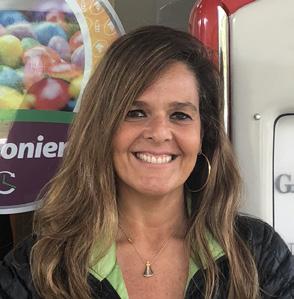
The basic foodservice offering in almost every c-store in Brazil includes coffee and other hot beverages, pão de queijo (a traditional Brazilian cheese bread), and typical Brazilian hot savory snacks like coxinha, pastel and empada, said Giselle Valdevez, owner of VALSA and a NACS relationship partner based in Brazil. Coxinha is made of shredded, seasoned chicken that’s wrapped in smooth dough, breaded and fried. A pastel is a deep-fried pastry with a thin crust, similar to a fried empanada, and can be filled with savory or sweet fillings. An empada (not an empanada) is a savory hand
the store and on the forecourt because the food is driving fuel volume.”
Retailers that have remote or low-traffic sites have also needed to develop their own concept for foodservice for these locations, Zheng said. For example, he noted that Shell launched Shell Café, BP rolled out Wild Bean, Sinopec has its Tiki Easy Coffee, and PetroChina brews uSmile Coffee. Sinopec’s menu stands out with “options such as its egg mayonnaise sandwich, crab sandwich and ready-to-eat rice options, including Yangzhou fried rice with grilled chicken, Gong Bao chicken with brown rice and curry

pie that is stuffed with either meat (often chicken), vegetables or cheese. Generally, bakery items are to-go items— bread rolls, baguettes, croissants and other kinds of breads including sweets, she noted. Breakfast is a rapidly growing foodservice daypart in Brazil. “Historically, breakfast used to be something people almost always had at home,” Valdevez said. “But this is changing. As people’s daily routines get busier, it’s becoming more popular to have breakfast outside—especially at a padaria (a traditional Brazilian bakery) or at a c-store.” Extensive breakfast choices, which are
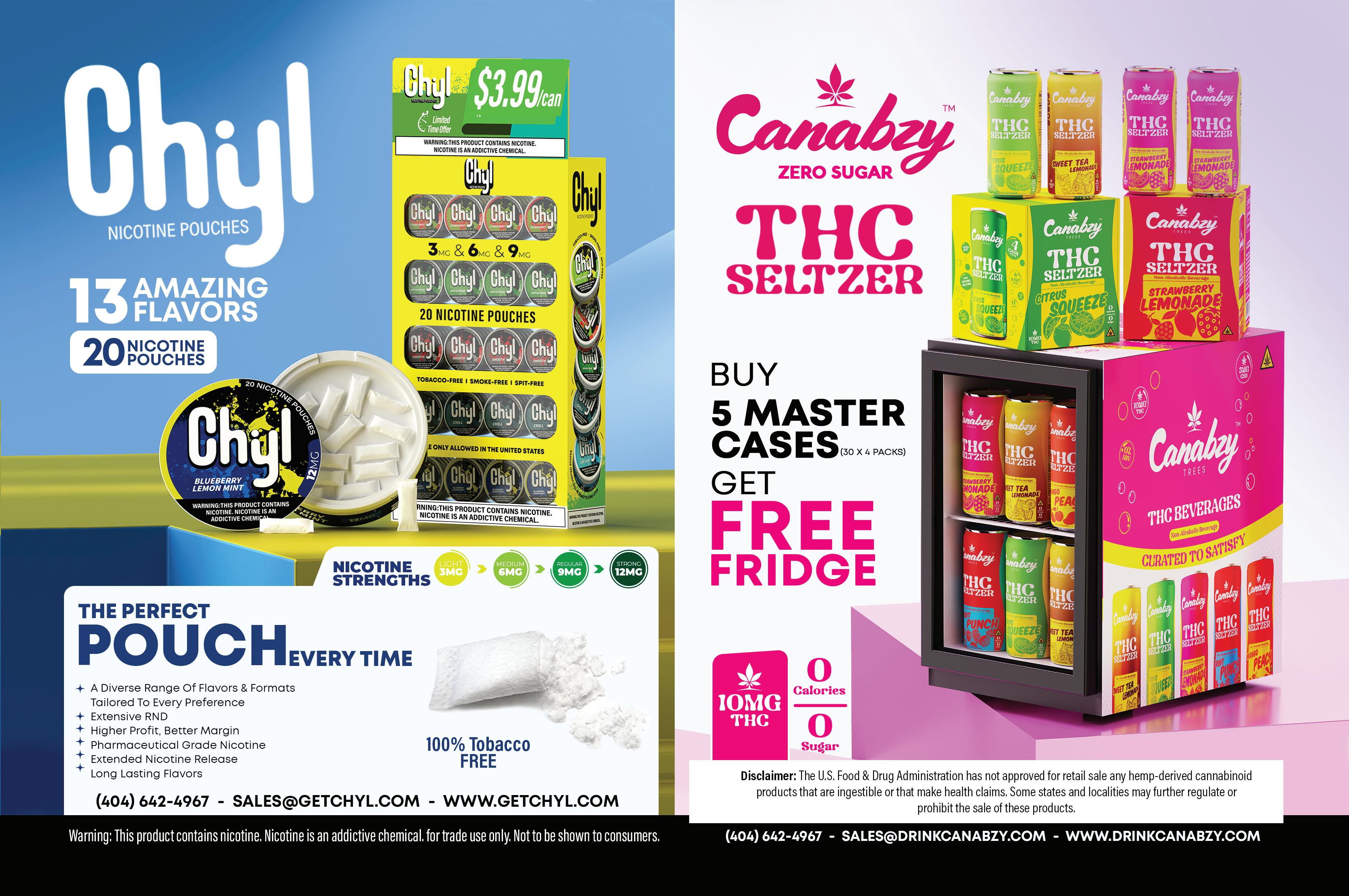


prepared on-site, are increasingly available in c-stores. These include sandwiches, eggs and bakery items. Tapiocas, which are crepes made from yuca flour, with sweet or savory fillings, are also popular, she noted.
A lot of customers choose to eat their food in-store, so a comfortable seating area, which sometimes includes outdoor seating, is an important part of a c-store’s layout in Brazil.

Nikolay Vylegzhanin is the NACS relationship partner for the MENA (Middle East and North Africa) region and the CEO of ProStore Consulting.
According to Vylegzhanin, coffee sales are rapidly growing in Middle Eastern c-stores. Many people drink six to eight cups of coffee a day, and c-stores have been upping their share. In the UAE, the retailer Adnoc’s coffee sales have seen steady growth at 20-30% a year. “At one point you would drive around the country, and banners and information about Adnoc coffee would be everywhere,” Vylegzhanin said. In fact, Adnoc’s heavy investment in coffee lifted coffee sales at its two primary c-store competitors in the country. Some of the most popular drinks in the region are Spanish lattes, which feature espresso, steamed milk and sweetened condensed milk, and karak chai, which is a strong milky tea.

Traditional meals that are successful here are biryani and mandi, which are rice dishes with meat, he said, while noting that when people are looking for a meal on the go they are more likely to pick up shawarma, which is similar to a wrap. Also popular is hummus.
“Some overall popular flavors from the MENA region include cardamon,

tahini, cumin, coriander, saffron and often a spices blend called za’atar,” Vylegzhanin said. “On the sweet side, the most trendy flavor is for sure the pistachio and kunafa mix,” which is found in the Dubai chocolate that has been so popular in the United States.
Drive-thrus and delivery are critical parts of retail in the Middle East. “Almost all petrol stations have a QSR attached that has a drivethru. In the United Arab Emirates (UAE), around 60% of Burger King locations are in petrol stations,” he said. “Depending on the city and region, some QSRs report anywhere from 40-80% of sales coming from delivery,” Vylegzhanin said.
The trending QSRs in the region have “shifted from Western brands to local brands,” he noted. For example, Albaik is a chicken-based fast-food outlet. It’s extremely popular in Saudi Arabia, and has started traveling outside of Saudi Arabia to UAE, Qatar and Kuwait.


Lauren Shanesy is a writer and editor at NACS and has worked in business journalism for a decade. She can be reached at lshanesy@ convenience.org.
Leah Ash is a writer and editor at NACS. She can be reached at lash@ convenience.org.
As the largest convenience store operator in the world with stores all over the globe, from the United States to Europe to Asia, tailoring foodservice and offerings to regional preferences and local markets is a critical part of 7-Eleven’s strategy.
“Catering to local tastes is key to delivering a great customer experience,” said Brandon Brown, senior vice president, fresh foods at 7-Eleven Inc. “Offering local and regional specialties is a meaningful way to connect with customers by reflecting the unique tastes, traditions and preferences of communities. By incorporating local flavors and regional favorites into our foodservice offerings, we not only meet specific customer demands but also demonstrate that we understand and value the communities we serve.”
7-Eleven empowers its franchisees and store owners to merchandise on an item-by-item basis. Its Retailer Initiative program combines consumer and sales data with the local knowledge of store owners who have relationships with their customers, enabling them to customize merchandise and optimize the product

“The introduction of these items stems from the high demand for convenient, ready-to-eat versions of beloved local dishes,” Brown said.

The retailer also draws inspiration from international destinations for new or LTO food items—last year it introduced mangonada donuts with Tajín, and has also offered barbecue pork sliders, chicken curry bowls and everything breakfast sandwiches. Taking note from the success of its Japanese stores, 7-Eleven has added popular Asian staples to its U.S. locations, including chicken teriyaki rice balls, miso ramen and
7-Eleven partners with Warabeya commissary to have fresh food items in stores daily, which Brown said helps the company offer both national staples across the U.S. and tailor additional foodservice items to regional preferences and flavors. “Through our nationwide network of commissaries and bakeries, we develop a wide range of high-quality, craveable and convenient food items, both for our national menu and regional specialties,” said Brown.
“Staples such as pizza, wings and Big Bite hot dogs remain customer favorites everywhere, while regional hits such as the Nashville Hot Chicken Slider or the Cuban Grilled Press Sandwich reflect local culinary preferences,” said Brown. “This dynamic combination of staples and localized options ensures we can delight customers while making every 7-Eleven store feel connected to its community.”

Lower Foods shares insights into the evolution of proteins in foodservice.
WHAT TRENDS ARE YOU SEEING IN PROTEINS RIGHT NOW?
Michael Mortensen: We have seen a very, very large increase in orders for our presliced deli meats, which we see are used in traditional sandwiches as well as wraps or in breakfast options. We’ve also experienced huge growth within the barbecued smoked meat category.
Customers are looking for a premium product that doesn’t have many ingredients, which is exactly what Lower Foods offers. And it’s flexible—you could make a brisket sandwich or offer mac and cheese topped with smoked brisket, or even switch dayparts and include barbecue in a breakfast burrito or sandwich.
Casey Boren: Birria is a huge trend. A lot of c-store trends follow what QSR is doing, and there are a lot of menus out there that have birria on them. You see different varieties, from birria tacos to birria ramen. Al pastor is on a lot of menus too, and we offer both products to retailers.


CAN YOU TELL US A BIT ABOUT LOWER FOODS?
Mortensen: Lower Foods is a fourthgeneration family-owned company based in northern Utah. When it was founded, Lower Foods began by doing slaughter for the sausage industry. Over the years the company has evolved more as it shifted into the cooked product business.
In the ’80s, Lower Foods started out with just deli meats—offering roast beef, corned beef and pastrami. Now, we have a full selection of deli meats, a full selection of barbecue items, and a full selection of items inspired by Hispanic cuisine.
IS THERE A PRODUCT IN YOUR PORTFOLIO THAT YOU’RE MOST PROUD OF, OR THAT MOST EXEMPLIFIES WHAT LOWER FOODS IS ALL ABOUT?
Mortensen: On the deli side, one of our favorites right now that we’re very proud of is smoked pit beef, which is smoked roast beef. On the barbecue side of things, it has to be our smoked brisket. We’ve gone from being just a deli company to shipping smoked briskets from Utah into Texas and into all of the other traditional barbecue states.
Boren: As Michael mentioned before, a strength of our products is the various applications each product has. Space is a huge issue, so if you have one protein, how do you make multiple things, whether that’s an LTO or a regular menu item. Our chopped brisket, to me, fits that bill the best.
Customers are looking for a premium product that doesn’t have many ingredients.
HOW DO YOUR PRODUCTS ADDRESS THE LABOR AND OPERATIONAL CHALLENGES AROUND FOODSERVICE?
Boren: Around 95% of everything that we make is fully cooked ready to eat, which is a huge labor savings for a retailer. For some products, like our deli meats, we offer them presliced, which also reduces labor.
We also offer what we call dual purpose packaging, where an item can be reheated in the package in a steamer or in a hot water bath. Or, if the end user wants to actually just take it from a thawed state, put it in the oven and reheat it in that package, they can do that as well, and that heating method enhances the product quality in addition to the convenience.
Mortensen: In a lot of cases, like our chopped or sliced smoked briskets, we’re providing items that can be heated in 30 to 45 minutes that would normally take anywhere from eight to 16 hours to cook if retailers were trying to cook it themselves, saving time.
Boren: Additionally, our products help with food safety. It helps eliminate any cross contamination with any raw products to not have raw chicken or raw beef in the back of the house.
YOUR FACILITY IS ALLERGENFREE. HOW DOES THAT HELP YOUR RETAILER PARTNERS?
Mortensen: It eliminates liability through the entire supply chain. It takes away the worry of “Do I need to post something up here saying there might be allergens included in this?” You don’t have to inform your consumers of one more allergen.
Boren: When you go through the nine common allergens and rule them out, when you talk to people about it they almost immediately understand that if you’re an allergen-free facility, you have a cleaner ingredient label than they might be used to.







consumers of all backgrounds
BY PAT PAPE H
ispanics make up about 20% of the United States population today. This culturally diverse, fast-growing segment is a valuable shopper base for convenience stores looking to expand fresh food and snack offerings.
Data from the Hispanic Marketing Council shows U.S. Latinos, with a GDP north of $4 trillion, represent the fifth-largest economy in the world.
Recognizing the purchasing power of Hispanic consumers, retailers of all types are developing strategies for winning and retaining these shoppers, and one of those strategies focuses on food. The same strategies help bring in shoppers of all backgrounds.
“We’re seeing some of the bigger convenience players dedicating part of their menu to what would be considered traditional Mexican food,” said Jeff Keune, who worked in restaurants and convenience retail before launching 4910 Consulting, based in Boston. He cites two leading regional retailers who have “leaned into Mexican foods in multiple dayparts and platforms, and they have variety: tacos, burritos and quesadillas.”
According to Grubhub’s “2024 Delivered Report,” Mexican food was the most popular “international” cuisine among U.S. Grubhub customers last year. The top-selling Hispanic item for delivery (1.3 million orders) was birria, a slow-cooked Mexican stew traditionally made with goat, beef or lamb. DoorDash reports that its most popular delivery item is anything fried, followed by chicken quesadillas.
Just as the Spanish language has regional differences, regional heritage influences food. According to LEK Consulting, individuals who grew up eating Mexican/Central American cuisine prefer dishes with spices and chiles, and those with Caribbean and Cuban heritage prefer citrus and root vegetable flavors.
Meanwhile, non-Hispanic diners increasingly are embracing authentic Hispanic cuisine with spicy, bold flavors, along with trendier fusion formats, such as birria ramen (Mexican birria stew with ramen noodles) and taco mashups (Korean BBQ taco).

Should you find yourself in Dallas late on a Friday or Saturday night, drop by Fuel City on the edge of downtown and get in line to order elote, or Mexican street corn. A traditional Mexican dish, it combines corn on the cob with mayonnaise or sour cream, which is then topped with chili powder, lime juice or crumbly Mexican cheese cotija. Fuel City sells 10-ounce cups for $5, 12-ounce tubs for $7 and a large 20-ounce serving for $9, which customers purchase for dinners and get-togethers.
“We’ve been selling it for 25 years,” said Christina Gomez, vice president of the seven-unit retailer. “People get out of the clubs, and they’re hungry. They want to eat tacos and the corn. We stay open till 4 a.m. to serve them.”
“Originally, we had mayo in our corn, but our patrons prefer sour cream,” she continued. “Our recipe comes with sour cream, but you can have mayo if you request it. People from everywhere come to buy street corn.”
Irving, Texas-based 7-Eleven Inc. acquired the Laredo Taco Company when it purchased the Houston-based Stripes convenience stores. The 600 or so in-store eateries, located mostly in Texas, Oklahoma and New Mexico, serve burritos, barbacoa, tacos and chorizo. The program is known for flour tortillas made fresh daily and a salsa bar featuring a selection of salsas and pico de gallo.
This past summer, multibrand c-store retailer EG America introduced the Cheesy Chicken Fajita Tornado, a new grab-and-go limited time offer (LTO) that combined charbroiled chicken strips, a blend of cheddar and Monterey Jack cheeses, green and red bell peppers and onions. The company called it a “fusion of Tex-Mex flavors and crispy satisfaction.”
“Summer travel is all about convenience, value and, of course, great flavors,” said Mendy Meriwether,
If your competition does this well, you better have something like it or something better.
vice president of food, dispensed beverage and QSR for EG America. “We’re thrilled to serve up fast, flavorful and budget-friendly bites that keep our guests energized and smiling.”
“If you’re a brand that wants to be stronger in foodservice and you’re looking for an option to expand your menu beyond bacon, egg and cheese on a bagel or roll, I would definitely start with [Hispanic] breakfast foods,” Keune of 4910 Consulting said. “Breakfast burritos are prominent throughout the country, and they hold well in the hot hold. They’re portable food on the go that consumers like. These are flavor profiles that continue to grow, and it’s a big opportunity.”
Keune advises retailers to build innovation around the foodservice items they already offer and the ingredients they currently use.
“If you have a bake table, you can probably convert some of that space into an area for making tacos or quesadillas,” he said. “It’s a matter of having ingredients laid out in the right order, keeping the hot with the hot and the cold with the cold, and having the space to assemble the offering. You can make to order easily if you have the right equipment and process.”
If the effort seems challenging, turn to product distributors for help. “There are plug-and-play concepts, and you can modify a turnkey program, if you like,” Keune said. “Do you want to satisfy a consumer need or build something based on your brand and what your consumer vision is? Determine how you want to differentiate yourself from the competition. If your competition does this well, you better have something like it or something better.”
At McLane, “we conduct extensive research to see what’s next in c-store food and which trends are moving from the proliferation to ubiquity menu adoption phase,” said Farley Kaiser, senior director of culinary innovation. “Research confirms the momentum behind Mexican cuisine, which now appears on 78% of U.S. menus. With 85% of consumers expressing love for the category, its appeal spans all foodservice formats, from fine dining to convenience stores.”
That’s one reason McLane developed Central Eats, a line of hot and cold food offerings that includes a Fiesta Toss Salad with chicken; a chorizo, egg and cheese Square Wrap; and chicken or beef street tacos. “The salad appeals to health-conscious consumers,” said Kaiser. “Chicken and beef street tacos can be sold cold to consumers to heat in a microwave or prepped back of house in a microwave or rapid-cook oven, and then displayed in a hot case. Tacos are beloved by 65% of consumers and predicted to grow nearly 30% over the next four years.”
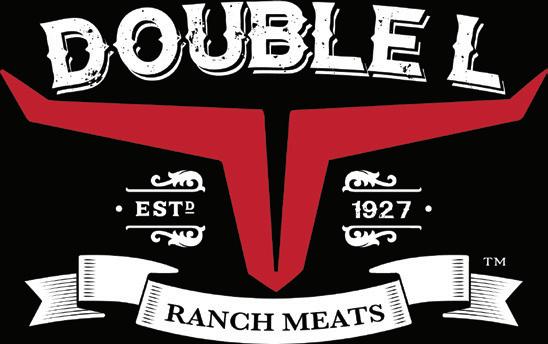
oven roasted & hardwood smoked
•Allergen, Gluten, and MSG Free
•no artificial ingredients
•Reduced or Low Sodium
•naturally hardwood smoked (no artificial or liquid smoke)




From Deli to BBQ to Hispanic favorites, our extensive Convenience offerings are designed to do more than just save time—they deliver unbeatable value, reduce labor, and raise the bar on quality and consistency for every foodservice operation.




We’re seeing some of the bigger convenience players dedicating part of their menu to what would be considered traditional Mexican food.
McLane also offers fruit cups, such as watermelon or mango with Tajin, both grab-and-go items with no prep required. Tajin is a tangy chili-lime seasoning that originated in Jalisco, Mexico, in the ’80s. “It’s a standout flavor with projected growth exceeding 200% over the next four years. It’s appearing in everything from guacamole to beverages,” Kaiser said.
Once the product and the platform for Hispanicinspired foods are created, let the world know. “You must have the signage to draw people in,” Keune said, “and you must integrate your products into your loyalty app.”
Two consistent promoters are 7-Eleven’s Laredo Taco Company and Yesway stores. The companies execute promotions that celebrate occasions such as Cinco de Mayo, National Burrito Day and National Taco Day, with special foodservice offers and pricing designed to drive traffic and attract new shoppers.
If timing is not yet right to launch Hispanic-inspired foodservice, there are still many food options that will help attract shoppers.
7-Eleven stores have offered traditional Mexican sweet bread products under the company’s 7-Select brand, including panquecitos (soft, sweet vanilla mini loaves), roles de canela (cinnamon rolls with raisins) and panqué con nuez (pound cake with pecans). In 2019, 7-Eleven and Stripes stores brought Mandarin—a flavor of Jarritos soda, which was founded in Mexico City—to the Big Gulp fountain. It was the first time the citrusy soft drink had been sold outside a bottle.
Rich Products Corp., based in Buffalo, New York, has a bakery near Mexico City that produces Tres Leches Cake Cups for the U.S. market.
“While tres leches traditionally features a simple sponge cake soaked in a rich milk blend and topped with light whipped icing, we’ve seen strong consumer interest in approachable flavor variations that still honor the original,” said Elizabeth Sommer, customer marketing manager for Rich’s. “Demand continues to
grow nationally as more consumers discover and adopt global desserts and flavors.”
Rich’s also has added a Hispanic-inspired flavor to its self-serve assortment of F’real milkshakes. The 12-ounce Cinnamon Churro Milkshake has the flavors of a churro, a fried pastry that’s typically ridged and coated in cinnamon sugar. The F’real version is made with real milk and packed with sweet cinnamon spice. Consumers can prepare it in the store’s blender in about a minute.
“This product was a limited-time offering in the fall of 2024, and since it was so successful, it’s been added to the core portfolio,” Sommer said. “Fans demanded that we bring it back, and now it’s here to stay. It’s extremely popular in regions of the West and Southwest United States.”
The F’real target market is 13- to 24-year-old consumers. “But recent data shows a lift in consumption for the 55-plus crowd, too,” Sommer said.
Many Mexican manufacturers are gaining momentum internationally. Brands include Gamesa, a PepsiCo subsidiary and Mexico’s largest manufacturer of cookies, and Marinela, a producer of cookies, pies and snack cakes.
Even without a full foodservice program, c-stores can engage shoppers and boost incremental sales through thoughtful retail curation of Hispanicinspired offerings.
“At the end of the day, if it’s good food and you’re able to market it well, it will grow,” Keune said. “Especially with today’s trends in Hispanic foods.”

Pat Pape worked in the convenience store industry for more than 20 years before becoming a full-time writer. See more of her articles at patpape.wordpress.com.


December 3-4, 2025 Hyatt

Join us at the NACS Loss Prevention and Safety Symposium, the only industry event dedicated exclusively to the latest strategies, insights, and tools that help convenience retailers, wholesalers, and suppliers protect their businesses.



BY LAUREN FRITSKY
There are over 150,000 convenience stores in the United States, generating a collective $837 billion in sales—an amount similar to that of other categories perceived to be significantly larger, such as supermarkets and restaurants, which each generate about $1.1 trillion.
This rapid growth has outpaced the capabilities and infrastructure of many c-store loss prevention teams, which tend to be less robust than their retail counterparts. Even among larger retailers, fragmentation in ownership and inconsistent technology adoption make it hard to scale loss prevention effectively.
“It’s a challenge we’re seeing more and more: stores growing faster than their ability to protect what they’ve built,” said Brian D. Gray, managing director, global head of fuels and convenience retail, at Accenture.
Register to attend the NACS Loss Prevention and Safety Symposium, Dec. 3 and 4 in Dallas, at convenience.org/ lossprevention.
To understand the loss prevention opportunities as c-stores continue to grow, we spoke with a few experts who will participate in a panel at the NACS Loss Prevention and Safety Symposium on Dec. 3 and 4 in Dallas. They shared the trends they are seeing in the space and how operators can prepare to capitalize on them heading into 2026.
In Gray’s experience, c-store loss prevention is often driven by a mix of internal fraud, operational challenges and external theft—just like it is at all retailers. What’s unique to c-stores is the vulnerability of specific categories.
“Lottery tickets, fuel, tobacco and alcohol are all high-theft items because they’re easy to resell and can be hard to track,” he said. “Pair this with the fact that most convenience stores have limited staff, which makes them more vulnerable.”
Employee theft—especially around the POS and fuel pumps—remains a significant issue. Operational errors, such as pricing mismatches and poor inventory tracking, also play a role. In the realm of external theft, shoplifting and organized retail crime are also on the rise, with smash-and-grabs and coordinated crew thefts that not only impact inventory but also force some c-stores to make tough decisions, similar to those made by their retail counterparts in recent years.
“In high-risk areas, the frequency and severity of these incidents have reached a point where store closures are becoming a potential response,” he said. “C-stores are especially vulnerable,” Gray said, due to their 24/7 operations, smaller team sizes and easy access points.
Often, c-stores face a scenario where it’s more local shoppers who are stealing products like alcohol, energy drinks and cigarettes and selling them in the underground market, said Byron Coleman, managing director at Security Consulting Services and formerly the manager of asset protection and security at Wawa.
“The majority of people are morally good,” he said. “They’re just a small, prolific group of individuals that taint the waters.”
There’s another crime where c-stores play a positive role: human trafficking. Due to their always-open nature and locations in both urban and rural areas, they serve as stops for people on the move—including victims of trafficking and their traffickers, said Cheryl Csiky, executive director of In Our Backyard, an organization dedicated to combating human trafficking that partners with NACS.
“Human trafficking often intersects with other criminal activities such as drug trafficking, weapons offenses and theft,” she said. “Traffickers may coerce their victims into participating in these crimes, creating a cycle of debt, fear and criminalization that makes it even more difficult for victims to seek help or escape. This overlap highlights how trafficking is not only a human rights issue but also a broader public safety concern.”
Unlike many retail environments where purchases are purely transactional, c-store employees frequently engage in conversation at the counter, creating opportunities to spot red flags. C-stores also play a uniquely valuable role due to their accessibility, hours of operation and frequent community presence. That’s why In Our Backyard launched the Convenience Stores Against
Lottery tickets, fuel, tobacco and alcohol are all high-theft items because they’re easy to resell and can be hard to track.











• All your foodservice operations intel in one place








When you’re in a food-forward business, you have to look beyond the traditional pain points or you’re going to be a step behind.
Trafficking (CSAT) program in 2017. Within about a year, over 5,000 convenience stores had joined the program by posting the Human Trafficking Resource Center hotline in their restrooms. Now, over 50,000 convenience stores have posted Freedom Stickers containing the hotline nationwide.
Convenience stores are ideal places to raise awareness because they serve as standard community hubs where people frequently stop, Csiky said. Additionally, the presence of public restrooms can serve as one of the only private spaces available to a trafficking victim.
“Customers often view stores that participate in this program as committed to community safety, which actually strengthens customer loyalty,” Csiky said. “Victims or those being trafficked often see convenience stores as safe pit stops during their journeys.”
The Total Loss framework, an overarching and fit-for-purpose definition and typology of the full range of losses that retailers experience, has been around for almost 10 years. C-stores have generally been slower to adopt it, said Mark Stinde, vice president, asset protection at Casey’s.
“If you think about convenience store retailers, there has been a more modest investment in the asset protection, loss prevention function as compared to other retail formats,” he said. “With limited resources, you tend to focus on the pressing issues right in front of you.”
However, he has seen more companies interested and engaged in adopting the philosophy.
When he first arrived at Casey’s, “We were really only focused on about 35 or 40% of the total loss in the organization,” he said. Many c-stores and retailers focus intently on malicious loss because it is most apparent.
Casey’s is a food-forward chain known for its pizza and other offerings. Therefore, its total loss must include how it manages perishable items—inventory on hand, product rotation, and code dates, as well as minimizing excessive waste.
“When you’re in a food-forward business, you have to look beyond the traditional pain points or you’re going to be a step behind,” Stinde said. “With excess waste comes excessive cost, which erodes margin, and that, of course, erodes profitability for the organization. So, the importance of looking at areas outside of the traditional loss areas in the business is critical, and that’s why we look at the total loss in the business holistically.”
The industry is experiencing a shift towards more intelligent and proactive loss prevention, with AI playing a key role, particularly in video surveillance.
“The tech landscape for LP has changed substantially,” said Gray of Accenture. “We’ve moved from basic CCTV to AI-enhanced video analytics that can detect a wide range of issues across the stores in real-time. Cloudbased platforms now enable centralized monitoring across multiple stores, and mobile dashboards provide managers with real-time visibility into incidents. Fuel pump monitoring has also become more sophisticated, helping prevent drive-offs and fraud. It’s a much more connected and intelligent LP ecosystem than it was even a few years ago.”
AI-powered systems can flag suspicious behavior before it escalates. When paired with integrated platforms that link video, POS and inventory data, they provide LP teams with a much clearer picture of what’s happening in real-time. Gray has also seen significant momentum around proactive inventory management, particularly for highrisk categories such as tobacco and lottery.

“The goal now is to prevent loss before it happens, not just respond after the fact,” he said.
manage total loss in the business,” Stinde said. “We’ve really reduced our use of traditional spreadsheets and other tools to more efficiently manage the business. Our more dynamic business intelligence tools give us insight all the way down to the unit level, and that helps our operators better manage their businesses.”
These systems can also help boost employee productivity by enabling c-stores to tie storelevel metrics to employee performance.
“Utilizing tools that are out there, and the advance of technology and AI specifically, I think will be a critical thing that we look at as LP practitioners for the coming years,” Stinde added.
AI-powered systems can flag suspicious behavior before it escalates.
AI has also evolved in the realm of voiceto-text for virtual guarding, according to Coleman of Security Consulting Services. Some solutions can virtually place a guard in a store scenario, and mobile surveillance unit solutions can also trigger based on behavioral patterns generated by AI. Predictive analytics, particularly in the context of exception-based reporting for POS, has also been more heavily adopted by c-stores.
Coleman believes that “any of the technology associated with AI that allows people to focus on those value-driven opportunities, as opposed to all the minutia that sometimes can get in the way,” will be huge. The win is that the proliferation of AI technology is driving the price down for these systems, making them more accessible to smaller or mid-sized c-stores.
“As a c-store LP professional, I spent a lot of hours looking at unproductive video and unproductive leads,” he said. “AI can help speed up that time.”
Stinde points to computer vision tools as an emerging area that c-store LP professionals should consider and test where possible. These solutions can help with malicious loss, safety aspects and operational challenges. AI-backed business intelligence tools are also transforming the c-store LP landscape by enabling more data-driven decision-making.
“We’ve developed some effective business insight and intelligence tools that help us
Despite the promise technology holds to enhance the capabilities c-store LP teams have at their disposal, having a human touch is still critical. This means continuing to train employees from both a systems aspect and from a behavioral perspective.
“With so much changing across the markets and with technology, there’s definitely a need to upskill employees,” Gray said. “Ultimately, team members need to know what to look for, how to leverage new LP tools and how to respond to alerts being raised. LP teams are being asked to understand and interpret insights from data analytics, which is a big shift from traditional security roles.”
However, he has also noted an increase in investment in behavioral training.
“Scenario-based learning—like roleplaying theft situations—is helping staff build confidence and capability,” he said. “Compliance training is also key, making sure everyone understands the legal boundaries across a variety of scenarios.”
Not unlike the evolution of retail employee training, providing different options for how team members engage with educational material can go a long way towards adoption. At Casey’s, Stinde’s team uses some written
You have to train how to interact with customers positively.

materials, but also utilizes animation, video and gamification to help educate team members. Microlearning also seems to be very effective.
“We’re not overloading the content, so the user gets the information they need, but it’s not onerous in terms of the time commitment,” he explained.
Coleman cautions against c-stores heavily relying on technological advancements to the detriment of simple people skills when it comes to what front-end employees should prioritize in their roles. In the name of increased consumer demand for speed and convenience, the POS experience has become more transactional. Consequently, some of the human touch associated with traditional customer service has been set aside.
“Most people know what they want when they come in, because they’ve done Google searches and informational searches,” he said. “So you end up with a much more transactional, impersonal sales process, and to overcome that, you have to train how to interact with customers positively. Being able to teach people how to interact and de-escalate is a key factor, but positively impacting a customer can prevent theft in the first place,” he said.
Other types of c-store crime require a slightly different approach.
In partnership with the c-store industry, In Our Backyard has developed easy-toimplement training for store staff on how to recognize and report suspected trafficking. The presence of the hotline sticker inside restrooms provides a private and safe way for anyone—whether a child or an adult—to reach out for support in a public setting.
“We focus on safety—no one should intervene,” Csiky said. “It can increase harm to the victim and those intervening. It’s best to wait until the situation is clear and make the call. It could be a tip that saves lives.”
Csiky shared that a short video training is available if you reach out to www.
InOurBackyard.org or info@inourbackyard. org. The organization can also coordinate a recorded Zoom meeting or webinar with management, if preferred, as an update for employees. It also offers an HT101 Training Series, a three-part program designed explicitly for frontline employees, providing practical tools and knowledge on identifying trafficking, responding appropriately and connecting victims to support. Posting Freedom Stickers in public restrooms, displaying awareness signage and keeping this issue visible in stores are small actions that can lead to life-saving outcomes, she said.
The compassionate, cooperative spirit of In Our Backyard is something all c-stores can keep in mind as they look to enhance their strategies for addressing a range of LP and safety issues in 2026 and beyond.
“We got into the business because we’re human behaviorists, but now you must have a data analysis mindset, and then you have to have collaborative problem-solving,” Coleman said. “The bottom line is that it’s taking everybody to help try to solve this problem.”

Lauren Fritsky is a seasoned journalist whose work has appeared on CNN, USA Today, Travel+Leisure, Fast Company and many other websites. Contact her at lauren.fritsky@gmail.com.
March 16-18, 2026 Louisville, KY






























































SURVEY SERIES PART 3 OF 3
Read parts 1 and 2 in the September and October issues of NACS Magazine.
A NACS survey reveals how consumers view c-stores, what they care most about and how to capture more of their business.
Convenience retailing seems to be in a good place. Convenience and ease of service are prized more than ever by consumers, and c-stores provide convenience better than any other channel. However, the industry does not operate in a vacuum, and it faces many competitors fighting for the hearts and wallets of consumers. A major element of this never-ending battle is how well our industry can satisfy the current and future needs of consumers. After all, it stands to reason that if they like us, why would they go anywhere else?
So let’s dig into that critical question: Do they like us?
BY JEFF LENARD AND ADAM ROSENBLATT
The old axiom about retail was that if you could delight someone in your store, you would win a customer for life. Today, that customer loyalty time frame may be as short as until the next transaction.
If convenience customers aren’t delighted, they have no shortage of other options. Some are other brick-and-mortar establishments; others are online only. Loyalty must be earned every time—and that presents enormous challenges for retailers to keep their current customers. However, it also presents new opportunities. If a competitor—from any channel seeking to provide convenience—disappoints a customer, then you have a real chance to convert that customer.
Let’s take a close look at what consumers say about convenience stores, what they want and which segments are most likely to sing the stores’ praises, whether in neighborhood get-togethers, on social media or even at zoning hearings.
Great news: More than four in five consumers (82%) say their experience last time they were in a convenience store was either excellent or good, up from 81% last year. Thankfully, just 1% said their experience was poor. While it’s good to see such high satisfaction, the small percentage who rated their experience as poor is a reminder that consumers have many choices and might choose not to return to that c-store in the future. HOW WOULD YOU RATE YOUR EXPERIENCE
Charts and insights are based on a national survey of 1,203 consumers conducted May 19-21, 2025, for NACS by national public opinion research firm Bold Decision (bold-decision.com). This article refers to data subsets that may not be included in the accompanying charts. Year-to-year comparisons are based on results from the 2024 NACS consumer survey, conducted March 8-12, 2024. Numbers may not add up to 100% due to rounding.
Unsurprisingly, frequent customers (those who say they shop inside c-stores multiple times per week) are most likely to say their experience was excellent or good (90%), compared to only 64% of rare customers (those who shop once or twice a month or less). Only 8% of these rare customers say they had excellent service, far lower than the overall average of 22%. There are two ways to look at this finding: Are some consumers too hardened in their perceptions to be converted, or is it an opportunity to create and promote some sort of customer service pledge to get them to at least try your store? It’s up to you to decide.
American consumers have been battered after several years of inflation and higher prices on many goods and services. There is no debate that prices are more top of mind than they have been in the past. In fact, consumers say that prices at the pump and prices inside the store are more important today than in the past when determining whether they shop at a particular convenience store. Consumers ages 18-34 were most likely to cite gas prices as more important to them today (73%, compared to 63% overall), while frequent customers were the most likely to say that in-store prices are more important than in the past (58% vs. 49% overall).
WHICH FACTOR IS MORE OR LESS IMPORTANT THAN IT WAS IN THE PAST AS A REASON TO SHOP AT A PARTICULAR C-STORE?
82% of consumers say that they had excellent or good customer service the last time they visited a c-store, up 1% from last year.
Price is clearly an important factor in the overall value consumers are seeking, but there are other elements critical to attracting and retaining repeat customers. The next few considerations reflect how stores make them feel: Is the location safe, clean and friendly?
Safety is a top priority, and it is more important to women than men (52% vs. 41%). Cleanliness is a major factor for younger consumers—51% of consumers ages 18-34 said it was increasing in importance compared to 43% of consumers overall. Those who work from home say friendliness of employees has become more important to them (45% vs. 37% overall). For people who work from home, the in-store experience could be as important as whatever item they are buying— considering that they might have spent the bulk of their workday at home alone without any in-person interactions.
Looking further down the list, the quality of food/meals carries more weight with frequent shoppers (47%) and consumers ages 18-34 (48%). These same groups were also most likely to say that a convenience store caring about the community (35%) is more important to them than before.
Understanding which things have become more important than in the past, the question then becomes: What can retailers do to get consumers’ business? As one would expect, lower prices top the list.
WHAT ONE THING COULD A C-STORE DO TO GET MORE OF YOUR BUSINESS?
53% Lower the gas price
25% Lower the price of in-store items
14% High-quality prepared food options
4% Improved customer service/employees
The data shows that customers would reward you if you were to lower your prices. But if you’re not intelligently targeting those most interested in that offer, you could be giving away valuable margin. Interestingly, frequent customers are less interested in lower gas prices than rare customers (47% vs. 61%). And those who buy gas from big-box retailers are more likely to seek low gas prices than c-store customers (65% vs. 55%). Can you get these infrequent customers and big-box shoppers to become more frequent customers? Maybe. But it probably is easier to satisfy more of your existing customers first; frequent c-store shoppers are most likely to want quality food and meals (18% vs. 9% of rare customers).
There are certainly opportunities to enhance your offers for existing customers or build out offers to attract new ones, and that’s something each company or store can individually address.
The great news for all is that an overwhelming majority of consumers say the local store nearest to them is an important part of their community and that they would be sad if that store closed.
THE C-STORE CLOSEST TO MY HOME IS AN IMPORTANT PART OF MY COMMUNITY.
Strongly agree
agree
How to get rewarded with more business?
78% of customers say either lower gas price (53%) or lower price of in-store items (25%) is the most important consideration.
There is no question that c-stores offer the most convenient brick-and-mortar shopping experience. But delivery has become more common in recent years, and for some people it could be even more convenient not to leave the comfort of their home or workplace. The data shows several potential warning signs that should be monitored. The customers most likely to use delivery are frequent c-store customers—daily commuters and younger consumers.
HAVE YOU ORDERED FOOD, BEVERAGES OR GROCERIES FOR HOME DELIVERY IN THE PAST YEAR?
Naturally, frequent customers are much more likely to feel that c-stores are an important part of their community (93% vs. 82% overall) than rare customers (63%), of whom only 12% “strongly agree” with this sentiment. We also explored how they would feel if the store were to close. More than three in four consumers (77%) said they would be sad or disappointed.
I WOULD BE SAD OR DISAPPOINTED IF THE C-STORE CLOSEST TO MY HOME WERE TO CLOSE OR GO OUT OF BUSINESS.
40%: Strongly agree
38%: Somewhat agree
14%: Somewhat disagree
77% Total Agree
9%: Strongly disagree
Care and concern about their local store is solid across all demographics. However, as one might expect, rare customers feel less of a connection, with only 60% saying they’d be disappointed if that store were to close (compared to 77% of consumers overall).
Consumers unquestionably care about prices, though that’s not the sole driver influencing the mindset and the actions of customers. They also like the concept of convenience and the convenience retailing industry overall—though not everyone shares that love equally.
There is no one-size-fits-all approach to keeping your customers and adding new ones, especially as new competitors emerge to fight for that convenience customer.


Jeff Lenard is the vice president of NACS media and strategic communications. He can be reached at jlenard@convenience.org.
Adam Rosenblatt is the founding partner of Bold Decision and has been leading NACS consumer surveys since 2009. He can be reached at adam@bold-decision.com.
82%
of consumers
say that the c-store closest to their home is an important part of the community.




BY TERRI ALLAN
With inflation and economic concerns top of mind for many consumers, 7-Eleven is leaning into a solution.
“Given the challenging economic climate and inflationary pressures customers are facing in the U.S., value has never been more important, and our private label brands are delivering exactly that,” said Nikki Boyers, vice president, private brands, at the Irving, Texas-based retailer. “We’ve seen growing demand for our private brands as shoppers look for quality products at prices that make sense.”
This year alone, 7-Eleven will launch 200 new private label products. “We’ve seen strong performance [with private label] across the board, reaffirming that our approach to innovation, quality and pricing is resonating,” Boyers said.
Smaller c-store operators are also seeing strong performance from some of their own branded products.
At Powell, Tennessee-based Weigel’s, which has almost 90 locations in the state, its private brand water has emerged as the second-largest-selling brand across all stores. Launched four years ago, the packaged Smoky Mountains water, spread across about 20 SKUs, “continues to grow and receive more and more space” as national water brands feel the effects of inflation, said Nick Triantafellou, director of marketing and merchandising at Weigel’s.
Across all channels in 2024, private label products had a banner year. According to the Private Label Manufacturers Association (PLMA), sales of store brands increased 4% last year to a record $271 billion, easily outpacing national brand sales, which rose just 1%. The trend continued for the first half of 2025, with PLMA reporting a 4.4% increase in private label sales and a 1.1% gain for national brands. Private label products now hold an overall dollar market share of 21.2% and a unit share of 23.2%, according to the trade association. PLMA projects the category will reach sales of $277 billion by the end of the year and 24% market share by 2030.

7-Eleven launched its 7-Select private label brand in 2008. The seven gummi products pictured here are just a fraction of the 900 products 7-Select includes.
The success of operators such as 7-Eleven and Weigel’s aside, trends for private label products in c-stores lag behind the overall market, indicating that there’s likely vast opportunity ahead. According to Circana, private label brands made up about 23% of the food and beverage sales in multiunit channels, or $244 billion, in 2024. In c-stores, however, private labels accounted for just 6% of food and beverage sales, or a total of $4.2 billion.
Through the first half of 2025, private label food and beverages in c-stores saw further erosion. Sally Lyons Wyatt, global executive vice president and chief advisor, consumer goods and foodservice insights at Circana, reported that store brands’ share had slipped to about 5% on a unit basis and 4% on a dollar basis. Slower traffic in c-stores in recent months was the likely reason, Wyatt said. “When consumers do come in, they’re probably grabbing the brands they know and love,” she said.
While recent sales figures point to soft trends for private label products in c-stores, several retailers remain bullish and have put an enhanced focus on the offerings. Houston-based BP launched its proprietary Epic Goods line in 2024 and, according to Lisa Blalock, president, U.S. convenience and mobility, and a NACS Board of Directors member, “early consumer response has been encouraging.” The initiative—which includes more than 80 different products available at about 1,500 ampm, Thorntons and TravelCenters of America locations, with more on the way—is “another way for us to
differentiate our brands and earn our guests’ loyalty while providing huge growth potential for our business,” Blalock said.
Although 7-Eleven has been involved in the exclusive brand space for years—the 7-Select label was introduced in 2008—the company has ramped up its commitment in recent years. “We’ve expanded our private brand assortment across nearly every category in the store: snacks, beverages, fresh foods, household essentials and more,” Boyers said. Today, 7-Eleven has 900 private label products in 50 categories, “and that number continues to grow,” she said. Earlier this year, the company reported that it launched 215 new private label items in 2024 alone, which delivered more than $70 million in incremental sales.
La Crosse, Wisconsin-based Kwik Trip, meanwhile, has long offered exclusive brands, and its commitment to the products remains steadfast. “We’re entrenched in private label products,” said Greg Scriver, senior vice president, procurement and marketing. Pointing to banners such as the Nature’s Touch line of dairy products and Urge snacks, he said, “these products have been part of



A smart shelf-edge rail that delivers pricing accuracy, real-time inventory visibility, planogram compliance, and personalized promotions - all using seamless Bluetooth connectivity
Deliver targeted campaigns at the point of decision, measure real-time shopper impact, and unlock new revenue streams from every aisle.
VusionGroup is the global leader in digitalizing the shelf edge, helping retailers transform physical stores into modernized, connected, data-driven profit centers and delivering smart shelves that elevate the customer experience.















Some c-store food and beverage categories have better-developed private label adoption than others. According to Circana, private labels account for 22% of unit sales in the refrigerated department, which comprises dairy, fresh juice and ready-to-drink coffee and tea. Frozen foods rank right behind refrigerated, with 18% of unit sales being proprietary brands.
“Store brands are well-represented in some of the largest snack categories in U.S. convenience stores,” said Peggy Davies, president of PLMA. Those catego ries include pretzels (35% share of all units sold), pork rinds (16%), potato chips (6%) and nuts (5%).
With Weigel’s roots in dairy farming, it’s not surprising that the 85-unit retailer prides itself on its own-label milk offerings. Faced with an overall decline in milk consumption in recent decades, Weigel’s launched a series of limited-time-only (LTO) milk products about five years ago. According to Triantafellou, the products have emerged as “a reason to bring foot traffic to our stores.” With varieties such as horchata, brownie batter and an “Autumn Reserve,” among others, the LTO milks “bring excitement back to what was once just a frozen white tundra,” he said.
Weigel’s reputation for its own dairy products has spilled over in recent years to its packaged beverages. “We’re fortunate in that people have trusted us with dairy for 94 years, so with our new products like pH water and flavored waters, people immediately assume it’s high-quality,” Triantafellou said. Overall, Weigel’s own bottled water accounts for 28% of the company’s packaged water sales.
In addition to salty snacks and candy, popular private brands at 7-Eleven include its 7-Select waters and isotonics such as the 7-Select Replenish sports drink, plus juices and teas. “Items like our 7-Select Fusion energy shots and 7-Select Rehydrate have quickly become customer favorites, offering functional benefits and bold flavors that stand out on the shelf,” said Boyers. Earlier this year, Southland Reserve, a new private label drink featuring four cold-brew tea flavors, created in a partnership with AriZona Beverages, was unveiled at 7-Eleven, Speedway and Stripes stores. “The opportunity for private brands at 7-Eleven has never been stronger,” said Boyers.
The
Private Label Manufacturers Association
(PLMA) projects total

longtime customer favorite. The brand was created in 1987; today, Kwik Trip offers about 32 Urge salty snack SKUs in both single-serve and take-home sizes, Scriver said. The small bags are priced at $1.49, compared to branded products priced at $2.49 to $2.69. Take-home bags, meanwhile, retail for $2.79 or an everyday two for $4.88 offer, versus branded items priced at $4.75 to $5.99 each. Kwik Trip customers appreciate Urge’s value proposition, Scriver noted: Take-home bags account for 25% of the category’s SKUs but 42% of the units sold.

market private label product sales will reach $277 billion by the end of 2025 and 24% market share by 2030.
Private label offerings from c-stores aren’t limited to food and beverage items. With a big focus on serving the needs of travelers, Love’s Travel Stops launched its Mobile to Go line of mobile accessories and electronics in 2021. The following year, the retailer unveiled Amarillo Supply Co., which offers truck parts and accessories for professional drivers. And last year, it introduced Traverse Travel Gear, which features items such as blankets, neck pillows and seat cushions.
And additional items may be on the way: “There are lots of opportunities for exclusive brands to grow in this space,” said Casey Creegan, senior manager of private brands at Oklahoma City-based Love’s. “We haven’t found the ceiling yet.”


























For c-stores that are able to offer private label products, the benefits are numerous. “It increases profitability for our stores, particularly for our franchise operators,” Blalock of BP said. “And it’s a great way to bring more guests to our locations.” In a presentation to investors earlier this year,






















slower turns and shelf-life concerns,” Hoffmeyer said. “Additionally, launching and maintaining a private label brand requires taking on the full responsibility for marketing, which can be resourceintensive.” He also pointed to packaging-related costs and compliance with food-safety regulations that can create barriers to entry for small operators.

7-Eleven said its private brands carry a 51% margin, compared to an average margin of 33% for national brands.


















At TXB stores—which have been offering their own branded products for more than five years— benefits of private label include “providing more control over the supply chain and allowing for better management of quality, pricing and availability,” said Ben Hoffmeyer, vice president, marketing and merchandising, at the Spicewood, Texas-based retailer. “As private label products gain market share, they can also create leverage to negotiate more competitive pricing on national brand products, further enhancing overall profitability.”

But c-store operators also need to be aware of the challenges that come with a private label program. “For smaller chains, one of the primary challenges is meeting minimum production run requirements, which can lead to inventory management issues,

Private label brands “give us a platform to innovate quickly, respond to trends faster and keep our assortment fresh and relevant,” Boyers said. She and Triantafellou also point to the shopper loyalty that the products help build. “If done right, private label brands can create a customer journey,” bringing greater value to retailers, he said.







Kwik Trip’s Scriver emphasized that consumers still want branded items, so c-stores should carry the right mix of branded and private label products. This enables retailers to leverage both the good margins of own-label brands and the gross dollars from branded products.












Wyatt of Circana believes c-stores should take a targeted approach to private labels. “Invest deeply in fewer and high-potential areas,” she said. And focus on merchandising. “Stand out on the shelf. Prioritize packaging, thoughtful shelf location and space allocation to break through shopper routines.”









Triantafellou believes private label products can even be transformative for the industry. “There’s fantastic opportunity to build margin, dollars, trust and brand equity,” he said, “and also change the narrative behind c-stores.”














































For c-stores that are able to offer private label products, the benefits are numerous. “It increases profitability for our stores, particularly for our franchise operators,” Blalock of BP said. “And it’s a great way to bring more guests to our locations.” In a presentation to investors earlier this year, 7-Eleven said its private brands carry a 51% margin, compared to an average margin of 33% for national brands.
At TXB stores—which have been offering their own branded products for more than five years— benefits of private label include “providing more control over the supply chain and allowing for better management of quality, pricing and availability,” said Ben Hoffmeyer, vice president, marketing and merchandising, at the Spicewood, Texas-based retailer. “As private label products gain market share, they can also create leverage to negotiate more competitive pricing on national brand products, further enhancing overall profitability.”
Private label brands “give us a platform to innovate quickly, respond to trends faster and keep our assortment fresh and relevant,” Boyers said. She and Triantafellou also point to the shopper loyalty that the products help build. “If done right, private label brands can create a customer journey,” bringing greater value to retailers, he said.
challenges that come with a private label program. “For smaller chains, one of the primary challenges is meeting minimum production run requirements, which can lead to inventory management issues, slower turns and shelf-life concerns,” Hoffmeyer said. “Additionally, launching and maintaining a private label brand requires taking on the full responsibility for marketing, which can be

resource-intensive.” He also pointed to packagingrelated costs and compliance with food-safety regulations that can create barriers to entry for small operators.
Kwik Trip’s Scriver emphasized that consumers still want branded items, so c-stores should carry the right mix of branded and private label products. This enables retailers to leverage both the good margins of own-label brands and the gross dollars from branded products.
Wyatt of Circana believes c-stores should take a targeted approach to private labels. “Invest deeply in fewer and high-potential areas,” she said. And focus on merchandising. “Stand out on the shelf. Prioritize packaging, thoughtful shelf location and space allocation to break through shopper routines.”
Triantafellou believes private label products can even be transformative for the industry. “There’s fantastic opportunity to build margin, dollars, trust and brand equity,” he said, “and also change the narrative behind c-stores.”

Terri Allan is a New Jersey-based freelance writer, specializing in consumer products and retail channels. She can be reached at terri4beer@aol.com.


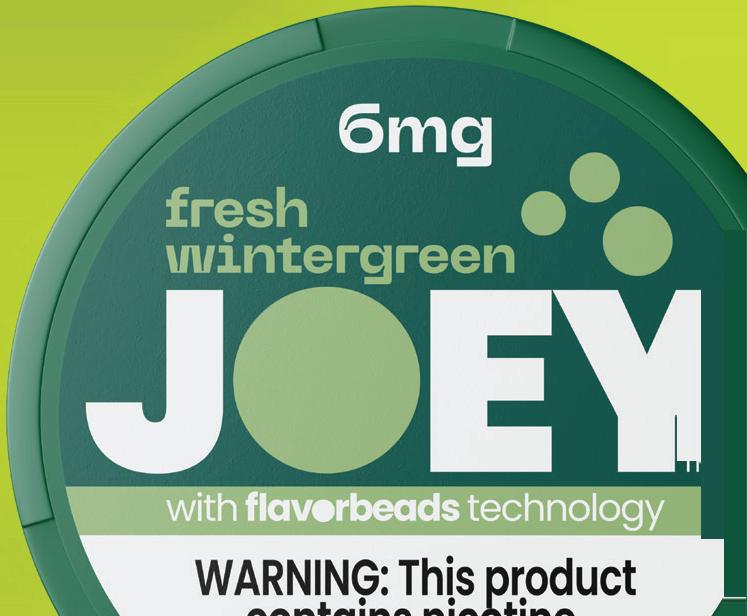






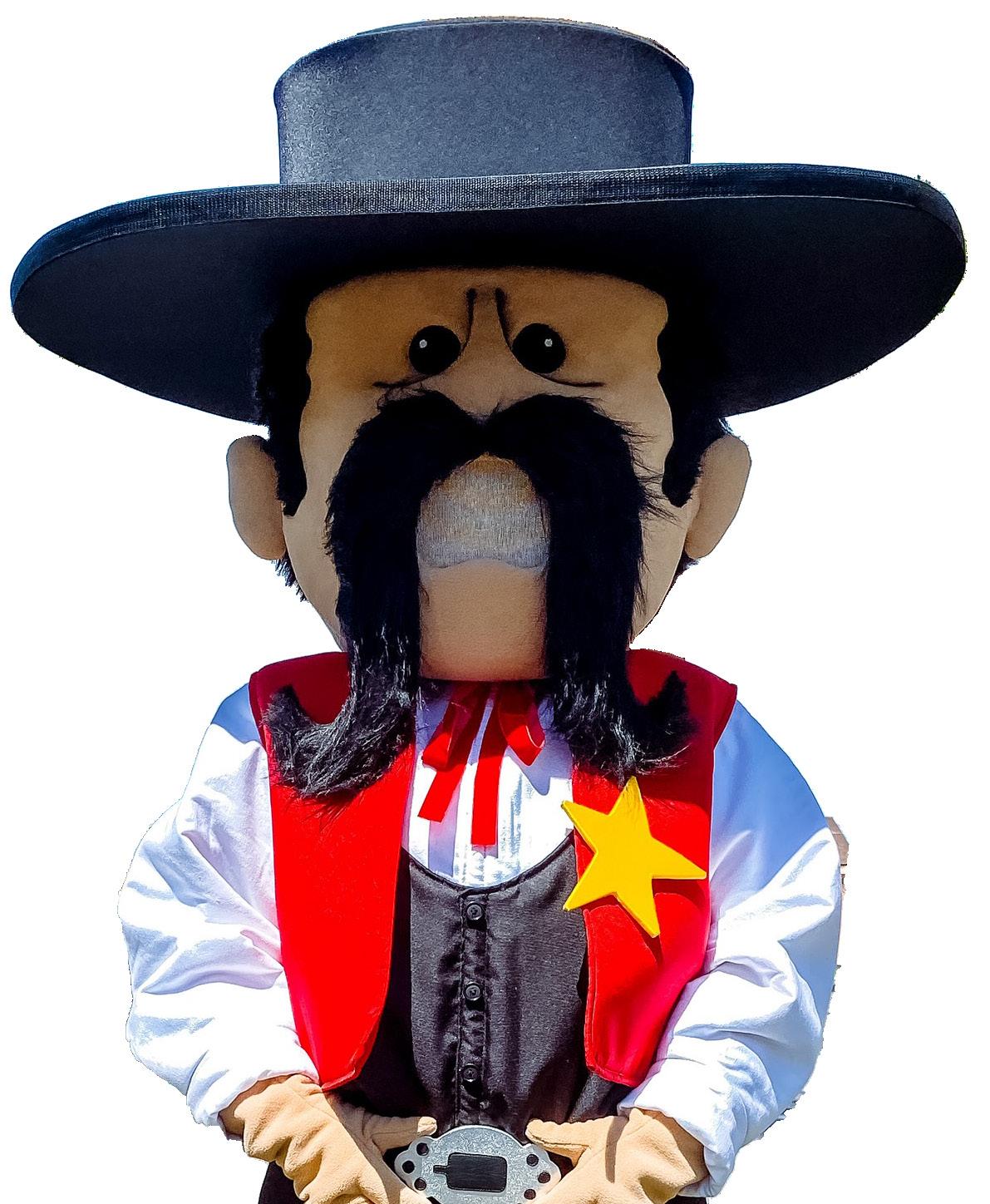


An effective mascot can dress up a company’s brand and create connection with customers.
BY STEVE HOLTZ
When Weigel’s stores debuted two new mascots in September 2024, Director of Marketing and Merchandising Nick Triantafellou said in a statement that he wanted the characters to “represent more than just a fun face for our customers.” Instead, he viewed the larger-than-life chicken Dippy (at six-foot-three and 250 pounds) and spunky cow Ellie as aiding in the Powell, Tennessee-based retailer’s mission to build community connections and create memorable customer experiences that go beyond the traditional convenience store visit.
One year later, the characters have appeared in TV commercials, on store signage, and at grand openings and community events, and they’ve interacted with the company’s name, image and likeness (NIL) athlete influencers.
“By integrating them into our social media and advertising, and including our NIL athletes in the fun, they become ambassadors of the Weigel’s experience, reminding people that there’s always something fresh, fun and uniquely local happening at Weigel’s,” Triantafellou said in a press release.
Creating an effective character can result in marketing magic for a retailer that reaches beyond the otherwise dull-sounding “corporate mascot.”






“They are not just fanciful characters but psychological tools that connect with audiences on a deeper level,” described the team at Street Characters, a mascot designer and creator based in Alberta, Canada, that is responsible for many of the mascots on the sidelines of professional hockey, football and baseball games, as well as mascots for corporations and retailers. “Mascots [act] as memory anchors. They become symbolic of the brand, making it more memorable and recognizable.”
“[Mascots] become a part of your branding ... a walking business card,” said Glenn Street, founder of Street Characters. “They stand out in the crowd, and it’s an opportunity ... to tell your organization’s story.”
That’s one of the goals for Weigel’s, which began
2024, it aligned the character with the brand’s values. “We believe that a mascot like Chewbie helps to personify the Hi-Chew brand, therefore making it more relatable to consumers,” said Teruhiro (Terry) Kawabe, chief representative for the USA and president and CEO of Morinaga America. “Our growing fan base of Gen Z and Millennials was a significant driving force behind this decision, as we aim to create unique brand experiences for them both in-person and digitally.”
Ensuring the character “folded seamlessly into Hi-Chew’s existing brand marketing materials, social media strategies and in-person activations” was also important to the process, Kawabe said.
Street is a serious believer in the power of a mascot. He recalled a character he created for a local restaurant years ago: “They told us when they had the character out in front of their restaurant, their sales went up because it just captured people’s attention. Motorists would say,

Here’s a snapshot of some of the retailer and supplier mascots in the convenience industry that have captured consumers’


Reese’s mascot, Cuppy, has a history that stretches back to the 1920s, but the modern, athletic version debuted in 2022 as part of a Reese’s University campaign. You can find Cuppy at pep rallies at Hershey’s Chocolate World or Reese’s Final Four Friday (pictured here in a dance-off with team mascots) during March Madness.




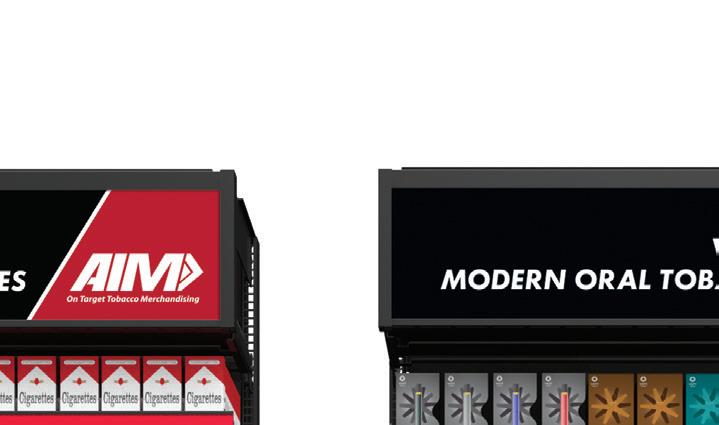





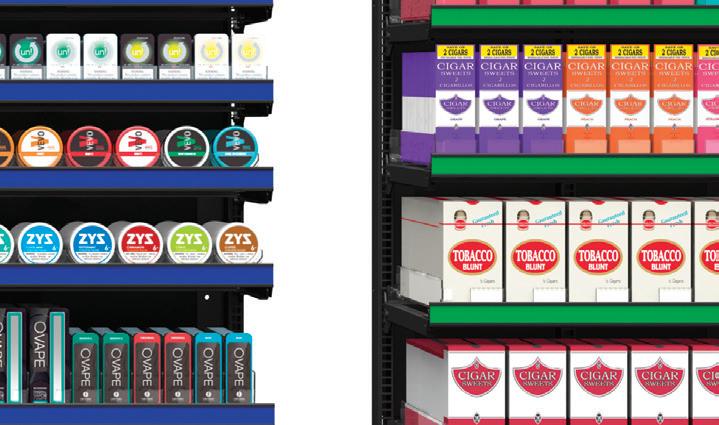


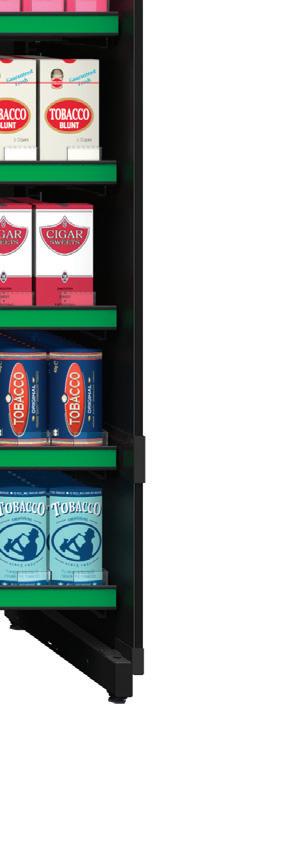





Hi-Chew debuted its Chewbie character on Instagram in September 2024. A month later, Chewbie found its way onto “Jimmy Kimmel Live” and digital billboards in New York’s Times Square. Here, Chewbie greets children outside Wrigley Field in Chicago, home of the Chicago Cubs baseball team.



It was just last year that Weigel’s introduced two mascots: Ellie the Cow and Dippy the Chicken. Since then, the mascots have appeared at store openings, starred in commercials and acted as influencers for the brand.




Verify age instantly. Sell with confidence.
TruAge is a smarter way to verify age, improve compliance, protect privacy and keep lines moving at the register. To enhance your responsible retailing experience, activate your free account today at mytruage.org/get-started.
Scan code to learn








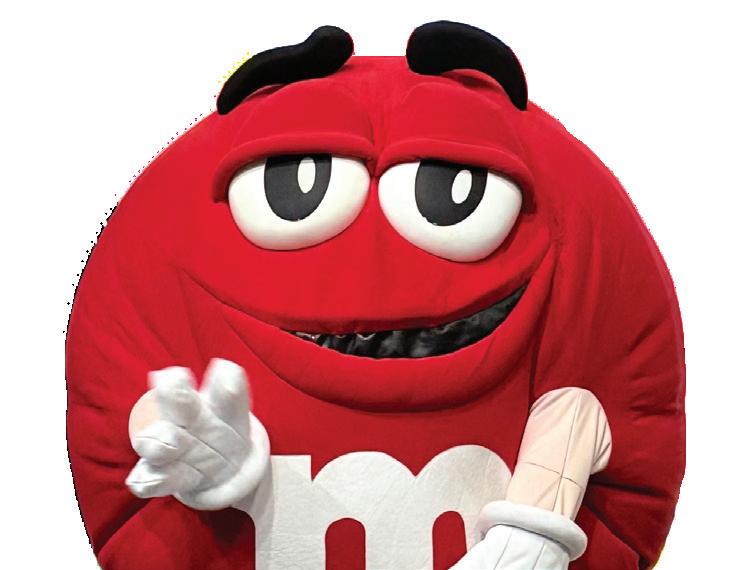

The M&M’S “spokescandies” characters began with Red and Yellow in 1954, and were later joined by Blue and Orange in 1995 and Ms. Green in 1997, according to Mars. Other variations—Ms. Brown, Purple, The Minis, Pretzel Guy and so on—joined the team over time, evolving from simple candy mascots to complex personalities with distinct traits and storylines.
Glenn Street, founder of mascot designer Street Characters in Canada, offered his insights on creating and maintaining a strong corporate mascot.
• Make the mascot relevant to your business:
“We find that mammals make a great character. Humanizing them makes them fun and people can relate to them. But we’ve done inanimate objects. ... If you’re a gas station or convenience store, a caricature of your pump is a great way to tie into who you are. You can give them a human component—eyes, a face, a name—so that people get to know the branding.”
• Choose your performer carefully: “The person who makes the best mascot is an introvert. ... The anonymity of being inside the costume allows the introvert to become that extrovert and do the things that they would never do outside of the costume.” The going rate for a performer is about $30 per hour, and they should have 20 minute breaks scheduled every few hours to get out of the costume for a bit.
• Evolve your mascot: “Update them or change them over time. ... We won’t do a wholesale change all at once. It’ll be a gradual transition” to keep them modern.
• Keep it clean: “Make sure that you clean the costume regularly. ... This is a representation of your brand, so if it starts to look old and tired, I'm not sure that’s the image anybody ever wants to put out.”
• Give your mascot a human buddy: “Have somebody with the character who’s able to tell the character’s story and your organization’s story.” The person can hand out cards or coupons. “Maybe you say, ‘We’re so-and-so car wash. We’re doing a fundraiser for a local school this weekend. Come on down and get your car washed, and we’re going to donate $1 to the school for each car wash we do.’”
• Embrace a rivalry: “People remember Harvey the Hound of the Calgary Flames [NHL team] because the Edmonton coach yanked his tongue out during a CalgaryEdmonton game. It made all the sports reels across North America.”


Terrible’s Mr. Terrible is “the gas-slinging Wayne of the Nevada Desert, with a black hat sitting squarely on his head, charcoal mustache drooping below his chin and daunting eyes glaring straight ahead.” He symbolizes the retailer’s desire for a never-ending movement westward, “itching for adventure, resolute on making an impact wherever he appears,” according to the company.
Krispy Krunchy Chicken debuted mascot Doug the Nugg this year in conjunction with the introduction of its new chicken nuggets. Here, Doug wraps up his cross-country promotional tour with a stop at the Boardwalk in Wildwood, New Jersey.







Billy Prim, founder of propane supplier Blue Rhino, came up with the company’s name after going on a photo safari in Africa, according to the company website—he thought rhinoceroses looked similar to large home propane fuel tanks. He added “blue” to the name to reflect the color of a propane flame. The company’s mascots are Reggie the Rhino, a costumed character that makes appearances at store openings and special events, and Ruby the Rhino, an inflatable that can be anchored in front of stores.
Boise, Idaho-based Stinker Stores got its brand name when someone called founder Ferris Lind a “stinker” for the low prices he charged at the pump. The mascot that followed: a skunk who goes by the name Polecat Pete.
Promising to keep his or her identity anonymous, NACS Magazine talked to the person in the Polecat Pete suit.
“I personally have attended several events in the suit as Polecat Pete. There is something truly special about representing our company as Pete. Community members get excited to see and take pictures with him. Kids especially have a real love for the skunk. It’s pretty
heartwarming to have little arms hugging our playful Polecat Pete.
It can be difficult to see at times [while in the suit], so we do have to work with a handler at all events. I can say from experience that no matter the temperature outside, whoever is in the suit will always be operating at high temps.
My first time being the mascot was a Fourth of July event at a local speedway race. Even with an ice vest, that 104-degree day melted me like butter, but the fans and friends of Pete and Stinker made it easy to endure.”
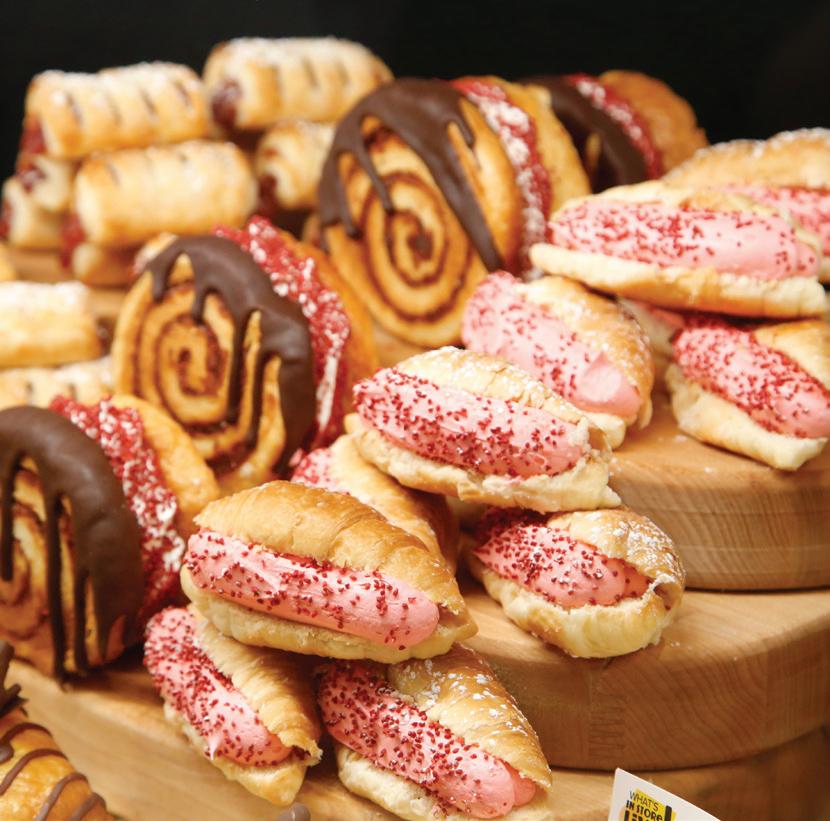


3 DAYS OF OPPORTUNITY:
• Innovative dairy, deli, bakery products
• New trends in fresh prepared, ready-to-eat, packaged, and more
• 10,000+ decision-makers doing business
• International flavors representing 40+ countries

Connect with buyers, brokers, and suppliers for top retail, wholesale, and c-store chains and major independents across North America.

JUNE 7–9 | Orlando, Florida




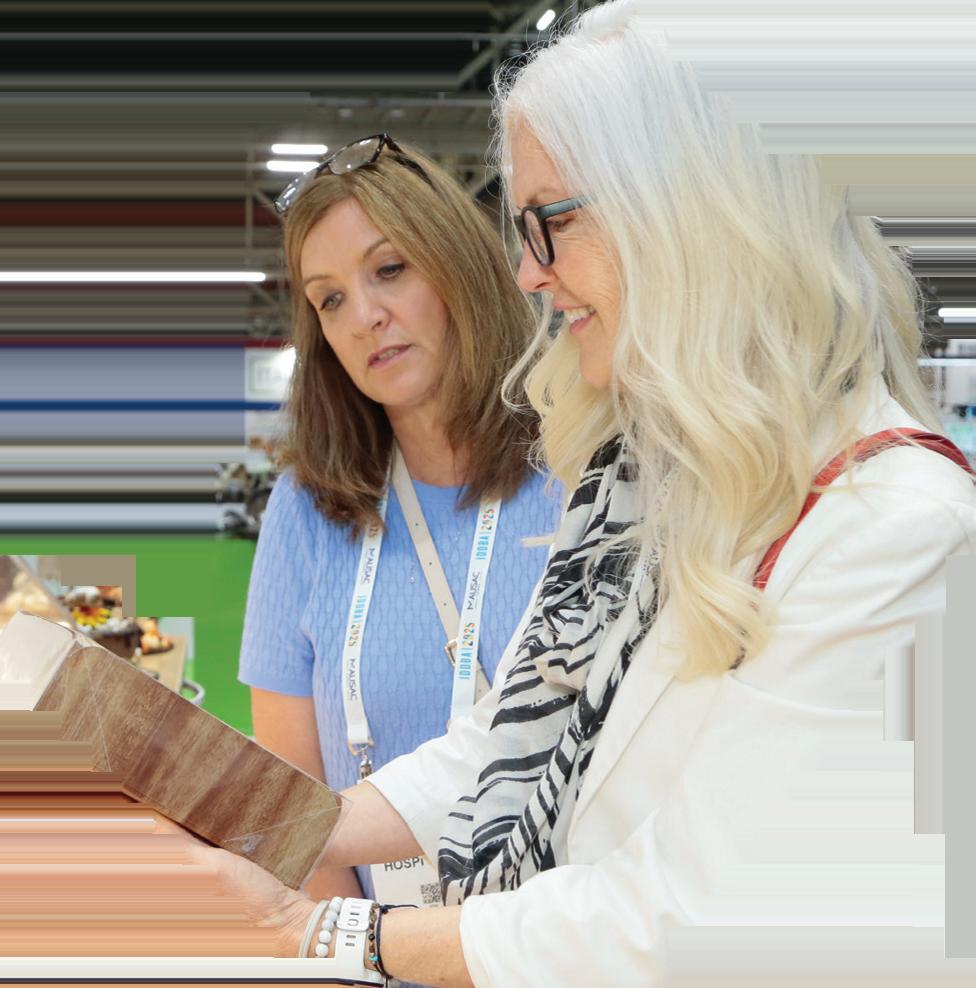

Cretors and Company
This advertorial-style guide of services and packaging appears monthly and is an information-packed tour of ideas and approaches that can change how consumers view your store or choose your brand. It spotlights the newest thinking in convenience and fuel retailing and gives you an advance look at ways of staying in front of industry trends. Products are categorized the same way we organize the Cool New Products Preview Room at the NACS Show each year in October— New Design, New to the Industry, New Flavors, Health & Wellness, Green (EcoFriendly), New Services and New Technology Products are considered “new” this year if they’ve been introduced since October 2024. The products featured here also can be seen in the Cool New Products Discovery Center at www.convenience.org/coolnewproducts The revolutionary High Roller Hot Dog Grill’s patented tip-up roller rack offers unobstructed access to the entire stainless-steel cooking surface, making cleanup quick and easy. The roller grill rack features removable roller sleeves that are dishwasher and sink safe for thorough cleaning, providing a cleaner and more appetizing product presentation. Accommodating a wide variety of products, including hot dogs, corn dogs, taquitos, grilled wraps, sausages, and more, it provides fresh and diverse options for customers. Save time and boost sales! Contact Shelly Olesen at 847.616.6901 or visit www.cretors.com.
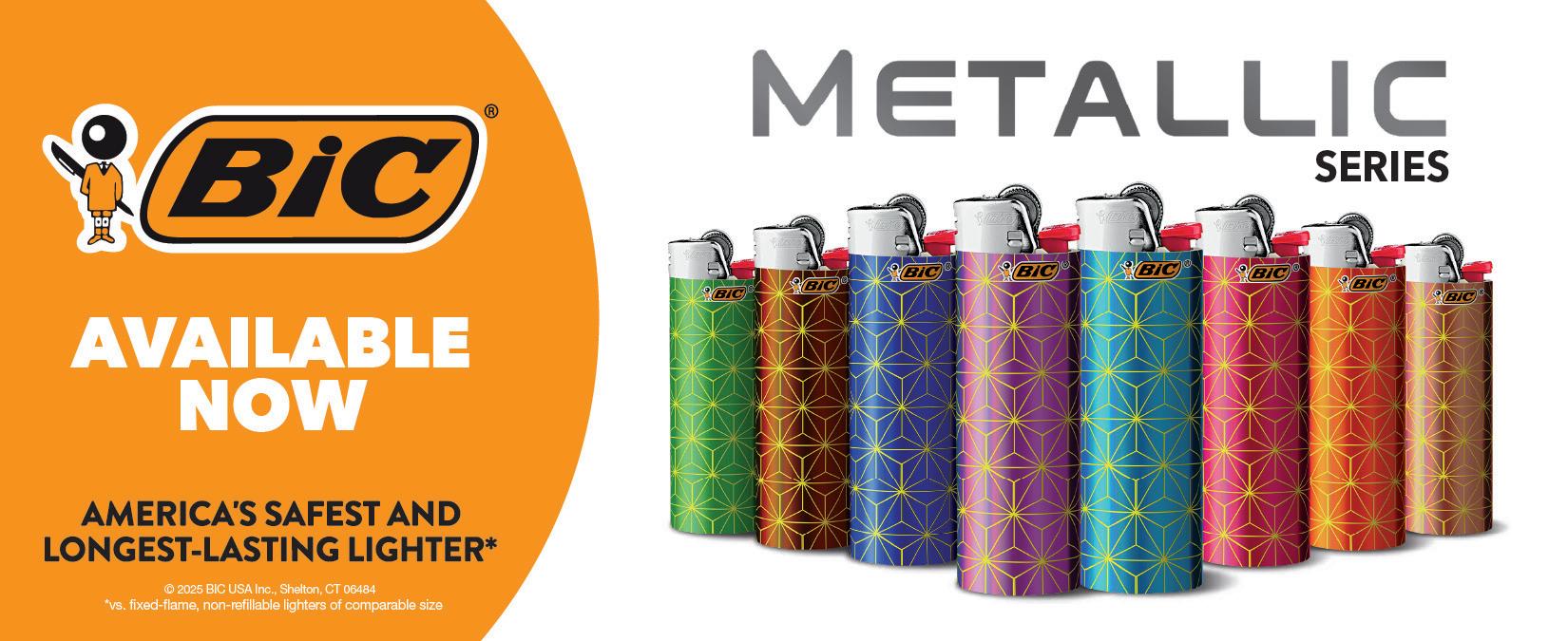
America’s Safest and Longest-Lasting Lighter* *vs. Fixed flame, non-refillable lighters of comparable size.
Visit for more information: https://us.bic.com/en_us/lighters-new-inquiry

Available NACS Show Education On-Demand Sessions
Nearly 40 education sessions from this year’s NACS Show, offering information, insight and insider knowledge retailers need to compete and thrive. The 2025 suite of education sessions is available for purchase in a streaming audio-video format.
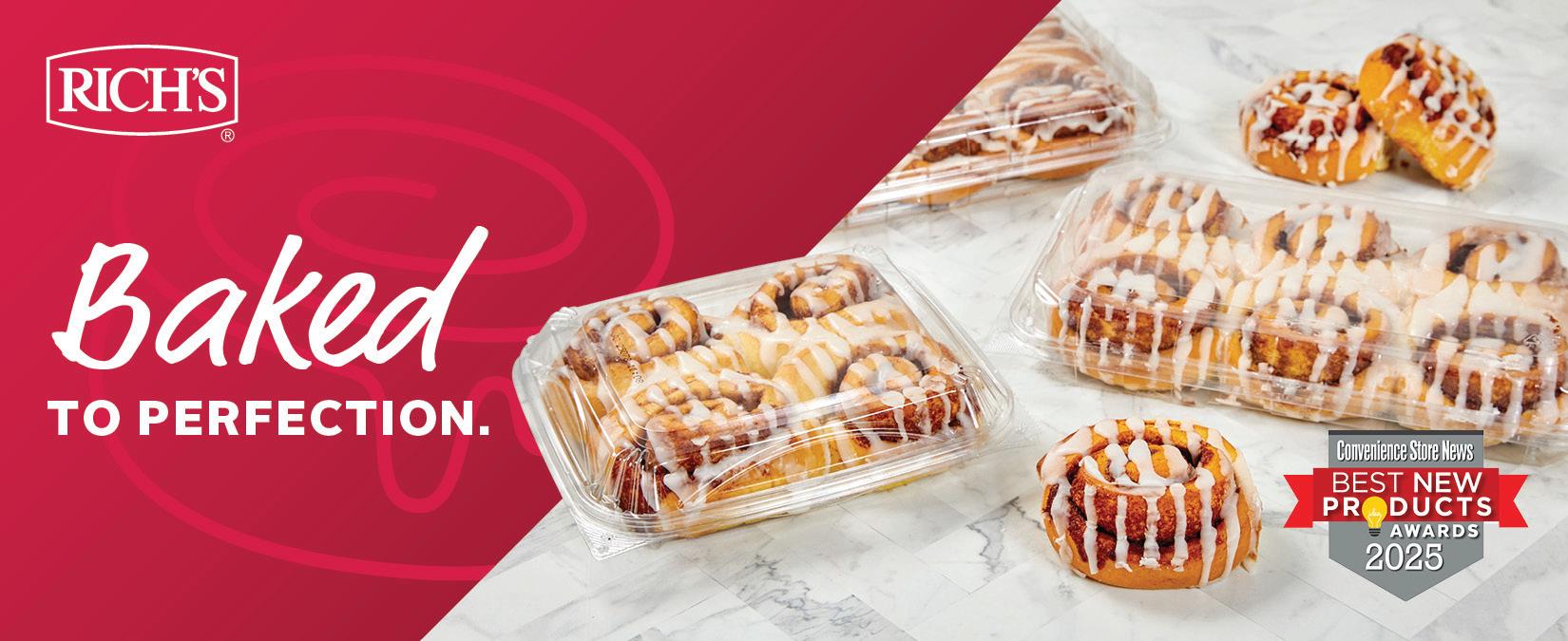
Finished Cinnamon Rolls
Nothing is quite so irresistible as a warm, fresh-baked cinnamon roll. Super moist and wonderfully sweet, Rich’s Fully Finished Cinnamon Rolls are spiced and spiraled to perfection—an ideal choice for the breakfast rush or impulse snacking throughout the day.
And, thanks to their fully finished format, you can offer all the indulgent flavor of a fresh cinnamon roll all day without the extra labor. Simply thaw to serve up this classic treat on demand or shelve for your shoppers to take home for later.

NACS Global
NACS Convenience Summit Asia
Join us in Shanghai, Asia’s most dynamic retail hub for an immersive experience at the forefront of global convenience innovation. As the industry navigates disruption and transformation, Convenience Summit Asia (March 10-12, 2026 in Shanghai, China) offers a rare opportunity to connect with industry pioneers, explore cutting-edge technologies, and gain insights into the fast-evolving Chinese market. Don’t miss your chance to be part of the conversation, on the ground, in the market, and ahead of the curve.

Stateside Brands
Surfside 19.2oz Iced Teas & Lemonades
Surfside expands with 19.2oz cans of its vodka-based Iced Teas & Lemonades. These new offerings provide consumers with a right-sized, value-driven format for c-stores. Surfside is the #1 dollar growth driver across beer and RTD spirits in 2025*, fueling category growth nationwide. (*Source: NIQ Retail Measurement B/W/A |TUS All Off-Premise Outlets| YTD 2025 W/E 08/02/2025)

Living with passion and chasing dreams is all we’ve ever known. Making it happen all day gets exhausting though. To help us charge-on comes Ultra Wild Passion. Fully loaded with our legendary energy blend allowing you to focus on what inspires you and lifts you up. Zero sugar, Wild passion pairs the sweet & tart flavor of passionfruit with a twist, creating a new taste sensation. It’s a light, refreshing, super easy drinking pick-me-up you won’t want to put down.

Cool New Products Discovery Center NACS
30,000 new products. One place to discover them.
Innovation drives up to 20% of a store’s set. Staying relevant means knowing what’s fresh. The Cool New Products Discovery Center connects retailers and suppliers with the freshest ideas, flavors, and technologies shaping convenience retail. Be part of the buzz of the Preview Room at the NACS Show, where 11,000+ product scans led to real connections last month, the curated Innovation Boxes delivered to top category managers, and this very Cool New Products section in the NACS Magazine and online. Don’t miss the year-round hub for what’s new and what’s next.
Discover more at www.convenience.org/solutions.
Atchafalaya Basin Landing sits on the water in Louisiana, drawing in guests through food and swamp tours.
BY AL HEBERT
At the average c-store, customers drive up in automobiles. They fuel up, grab something to eat and drive off.
At the Atchafalaya Basin Landing and Turtles Bar & Grill, it’s a little different. It’s a floating store and restaurant in the Henderson Swamp in Louisiana. There’s fuel, but it’s boats that motor in to fill up. Customers walk into the c-store for snacks and beverages, then they can walk next door to dine in the restaurant, but sometimes, when they look down, alligators might be peering up at them.
The business itself has been open for 26 years, but there wasn’t always a bar and landing. It was once just a store and a boat launch.
“My dad, Tucker Friedman, owned a convenience store, but he always wanted to build a floating store, restaurant and bar,” said Christine Friedman, general manager of the store, which is owned by her father. “He had a vision. We have his sketches from 10 years before
it was built in March of 2024. It’s a 6,000-square-foot floating island. A floating store and restaurant had never been done in our state. Permitting was a nightmare. They had to create new codes for it.”
Christine’s brother Nick, who is now the operations manager, and her father built it all with the help of staff and friends. “Each piece of wood in here was planed by my dad.”
“It sits on plastic dock floats. They had to be installed according to weight. There are different size floats for different weights. Everything was delivered like a puzzle. My dad, Nick and our employees put it together by section and they would float it out and then put another section together,” she said.
Tucker always had a flair for food. His chili was popular back when he had his first c-store. He brought that recipe—and a lot of others—to the island in 2024.
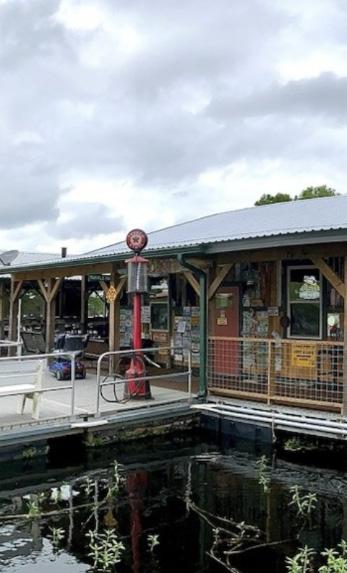
“I’d say the burger is the most popular menu item. You can add bacon, jalapeños, onions and more. They come with our house chips, which are very popular,” Christine said.
Like with all great burgers, the beef is the key. “We work with a local meat market in town. It’s a special fat-to-meat ratio that we like. We’ve gone back and forth, but so much of the flavor comes from the fat,” Friedman said.
The chili is a different story. While the same meat market provides the beef, it contains less fat. “We don’t want greasy chili.”
Also popular on the menu are chicken wings. She noted that attention to detail pays off with wings when it comes to flavor. The wings are marinated for 24 hours and they’re not battered. “That’s a personal preference. Our customers like them that way. They go better with the sauces.”
In this part of the world, tourists and locals want gumbo. At the Turtles Bar &
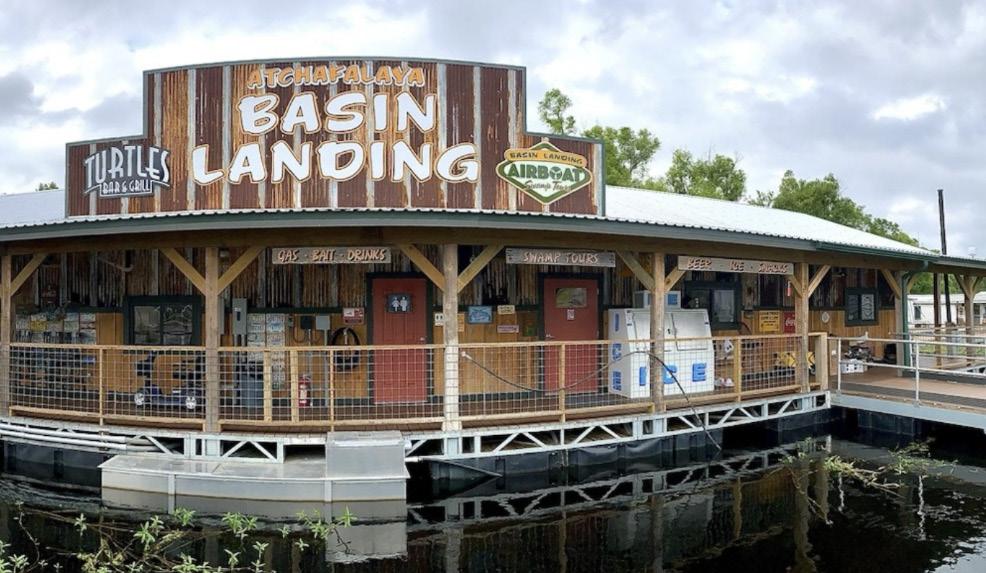
Grill, the gumbo is a staff favorite. “Our gumbo is also Nick’s homemade recipe
It’s chicken and sausage, and made using both fresh (uncooked) sausage and smoked sausage from a local meat market,” she said
Nick also created the restaurant’s homemade ranch sauce. “He’s particular about what goes in it. If a particular buttermilk is out of stock he won’t make

it,” Christine said. “It is a customer favorite. We go through a ridiculous amount of ranch sauce. Customers want to dip not just wings, but fries, burgers, fried pickles and fried jalapeños and Tater Kegs. Tater Kegs are large tater tots stuffed with bacon, cheddar cheese and chives. We also have a Cheese Bomb, which is a Tater Keg stuffed with four different kinds of cheese,” she explained.
The Atchafalaya Basin is the nation’s largest freshwater swamp—even bigger than the Florida Everglades. The store is located in the Henderson Swamp portion of the basin. The Friedman family offers a way for people to see more of the swamp.
“We have four airboats that we can run at a time. They can accommodate up to 46 passengers at one time,” Christine said. “And, this is the most beautiful portion of the swamp.”
“Visitors see alligators, birds, snakes, turtles, deer and nutria. It’s a wildlife adventure. It’s always unpredictable. It’s completely wild and you never know what you will see,” she said.
Friedman surveyed her surroundings and said, “I feel like our calling is to be here and show them the beauty of the Atchafalaya Basin. Our family has dedicated our lives to that.”

Al Hebert is the Gas Station Gourmet, showcasing America’s hidden culinary treasures. Find him at www.GasStationGourmet.com.

Frozen dispensed beverages deliver high margins and endless opportunity for creativity.
BY PAT PAPE

$2,626
The average gross profit dollar contribution from frozen dispensed beverages per store, per month.
Source: NACS State of the Industry Report® of 2024 Data
When 7-Eleven introduced the Slurpee in 1966 and promoted it with quirky radio ads aimed at young Boomers, no one suspected that the frozen beverage would one day be a signature product for the convenience store industry.
Depending on the c-store company, today’s flavorful, icy beverages go by various brand names: ICEE, Freezoni, Froster, Slushie, Chiller or Frozen Zone. But they’re all cold and colorful and still attract young people—and the young at heart— almost six decades later.
“Consumers of frozen carbonated beverages skew younger, diverse and family-oriented, with Gen Z representing a significant portion of the audience,” said Rebecca Johnson, director of dispensed innovation for The CocaCola Co. in North America. “Gen Z consumers—ages 13-27—account for 42% of frozen-beverage consumers.”
But never underestimate the cravings of older customers seeking a cold sip of nostalgia.
“We see all age groups enjoying Frosters,” said Shawn Barnes, head of dispensed beverages North America at Circle K, of the retailer’s branded beverage. “There is something about grabbing a frozen drink to cool down or having a little treat in your day that customers of all ages enjoy.”
The frozen-dispensed-beverage category includes three subcategories: frozen noncarbonated (90.3% of sales); frozen carbonated, or FCB (5.6%); and other frozen dispensed beverages (4.1%). In 2024, sales of frozen dispensed beverages averaged $4,064 per store, per month, an increase of 4.2% from 2023’s $3,898, according to the NACS State of the Industry Report® of 2024 Data.
1.7%
1.7%
Sales/Store
$3,898
$4,064
64.60%
Source: NACS State of the Industry Report® of 2024 Data
$1,400
$1,200
$400
CSX, the engine behind category metrics and NACS State of the Industry data, provides current and customizable tools for financial and operational reporting and analysis in the convenience industry. Retailers can measure their company by any of the myriad metrics generated via our live database.
Contact Chris Rapanick at (703) 518–4253 or crapanick@convenience. org for a complimentary executive walkthrough.
n 2022 n 2023 n 2024 n 2025
$1,240
Source: NACS CSX Convenience Benchmarking Database
“The gross-margin percentage for the category was an impressive 64.60%, up slightly from the previous year,” said Emma Tainter, research manager, analytics and programs at NACS. “Frozen dispensed beverages have some of the largest margins across foodservice.”
In 2023, more than 3,300 functionalproduct launches worldwide featured a fruit flavor, and 40% of those launches were beverage-based, according to Flavorchem, a flavor and fragrance producer. As a result, more fruit flavors are showing up at the fountain and in the cold case, ranging from familiar favorites such as fruit punch, lemonade and raspberry to more exotic tastes such as dragon fruit and guava.
Since 1966, more than 300 Slurpee flavors have been enjoyed by consumers around the globe. “But in the U.S., the most popular flavors continue to be Coca-Cola and Wild Cherry,” said a spokesperson for Irving, Texas-based 7-Eleven. “Blue Raspberry tops the list as Gen Z’s favorite flavor, though this group often prefers to mix two flavors to create their own personalized combination.”
Over the past year, 7-Eleven has enjoyed strong performance in the FCB category, thanks in part to fruity limited-time-only (LTO) flavors such as the new Powerade Xtra Sour Grape Shocker and the Nerds Strawberry, the latter of which hit participating stores in August.
At Sunny Sky Products, “we are seeing a lemonade craze, and we’ll be putting Sour Patch Kids lemonade front and center in our FCB units,” said Isabel Atherton, vice president of marketing.
Sunny Sky’s frozen soft-serve line includes chocolate and vanilla flavors, which will soon be joined by Frosted Lemonade. “We conducted internal sensory surveys and came up with delicious and creamy formulas that performed the best in terms of mouthfeel, flavor and consistency,” Atherton said.
The company also plans to roll out Tiger’s Blood and Pineapple Orange Yuzu in both carbonated and uncarbonated frozen drinks under the Original Slushie Co. brand.
The top-selling ICEE flavors are proven winners. “Our iconic Cherry and Blue Raspberry are the classics of the category,” said Kimmra Hingher, vice president of marketing for ICEE. “And we continue to bring exciting flavors

High-profit candy, snacks and healthy food options achieve superstar status on the Royston Gondola Shelving Unit with LED Backlit Graphics. Customers are drawn to vibrant, engaging signage from multiple angles and heights. Efficient design provides 138* linear feet of adjustable shelving in a compact footprint. Durable steel construction, powder coat paint and customized graphics from SignResource (a Royston Group company) deliver a seamless solution that performs proficiently for years. Entertain greater center-store sales, visit roystonllc.com for more.

Since 1966, more than 300 Slurpee flavors have been enjoyed by consumers around the globe.
and LTOs to drive incremental trips and consumer excitement. Our collaboration this past year with Peeps was one of our strongest performers to date.”
The ICEE team hopes to top that success in 2026 with an innovative ICEE Watermelon Limeade LTO. CocaCola is introducing Fanta Halloween Sour Fruit Punch in fourth-quarter 2025 and Minute Maid Mango Lemonade in January.
Frazil, whose flavorful treats are made with crushed ice crystals, recently released Rock N’ Roll, a frozen treat that blends grape, blueberry and blue raspberry. “It’s a nostalgic flavor for most of Gen X and millennials,” said Val Fulton, brand manager. “We also launched Cherry Limeade this year, and it’s become a customer favorite. Tiger’s Blood [strawberry, watermelon and coconut] and Blue Razzmatazz [raspberry] continue to be our top sellers.”
“LTOs are very important to the category,” Barnes of Circle K said. “While the core flavors remain fan favorites, LTOs offer a break from the norm and allow customers to try something new and, in most cases, something you can’t get anywhere other than at Circle K.”
Earlier this year, Circle K launched a Mountain Dew Summer Sparkler Froster, which quickly gained a following. “It was developed to taste similar to a Bomb Pop popsicle. We just made it a little easier to enjoy in the car,” Barnes said.
Sometimes customer response to an LTO will result in the product coming back on a permanent basis. That’s what happened at F’real, the company known for blend-it-yourself shakes and smoothies. Strawberry Shortcake and Cinnamon Churro milkshakes started as LTOs but returned to stores in June based on customer response, which was expressed via social media. F’real’s latest LTO is the Girl Scout Coconut Caramel Milkshake, which combines the tastes of toasted coconut, caramel and cocoa.
According to the National Coffee Association, about half of all coffee consumed by 18- to 24-year-olds is cold, and 82% of cold coffee consumed away from home is flavored. But so far, iced coffee drinks don’t seem to be stealing frozen-beverage fans.
“We continue to see growth year over year in frozen dispensed beverages, and I don’t think cold coffee drinks are cannibalizing the category,” said Barnes. “The FCB mission trip and the cold-coffee mission trip are truly unique. Cold coffee offers a functional and sometimes indulgent experience, while I believe the FCB trip is much more rooted around people just looking for a treat.”
The ICEE team sees the popular taste of coffee as an opportunity. “We are launching some frozen coffee flavors—Mocha Madness and Salted Caramel Swirl—with Slush Puppie this year,” said Hingher. “We continue to look for new ways to deliver flavorful, exciting offerings to our customers.”
Frazil plans to introduce a Peppermint Mocha Cafe Tango flavor. Other Frazil coffeehouse-style frozen flavors
Frozen dispensed beverages present boundless opportunities for innovation.
Same-Firm Sample, Per Store, Per Month
Source: NACS State of the Industry Report® of 2024 Data
I don’t think cold coffee drinks are cannibalizing the [frozen dispensed beverages] category.
have ranged from Caramel Macchiato to Pumpkin Spice and two lower-calorie offerings in Espresso and French Vanilla.
Over the past year, the energy drink market has seen more than $22 billion in sales as consumers have become more health conscious and focused on functional beverages, according to NielsenIQ. Now, energy additives are showing up in frozen drinks.
Yatco, a 23-unit convenience retailer in Massachusetts, gives customers a dispensed-beverage selection that includes slush drinks, lemonades, teas and an interactive digital fountain machine with 20 products.

Two locations recently added a powdered energy drink that can be mixed with water to create a frosty beverage booster. The product was purchased through NCD, and Yatco reports that sales have been exceptional. Hassan Yatim, president and COO of Yatco, noted that both stores are located near colleges, and students have discovered it. “They want to stay awake,” he said. “I’ve tried it too, and it’s pretty good.”
Last year, F’real introduced its Energy Freeze line, which currently includes Blue Raspberry and Strawberry Watermelon. Each serving
provides 100 milligrams of caffeine, “without the excessive buzz, thanks to ingredients including coconut water and green coffee extract,” according to the company.
Despite millions of existing fans of frozen drinks, publicized promotions help keep the beverages top of mind for potential consumers.
7-Eleven distributes free small-size Slurpee drinks to customers every July 11, the company’s official birthday. 7-Eleven has also hosted Bring Your Own Cup Days, which for a set price permit customers to bring almost any container that is clean, water-tight and fits under the Slurpee dispenser’s 10inch opening to fill with their favorite Slurpee flavors.
This year, 7-Eleven launched the Kerplunk Kandy Grape Slurpee drink as an ode to Green Day’s 1992 album “Kerplunk!” and partnered with NBA icon Shaquille O’Neal to release a limited-edition Shaq-A-Licious XL Sour Pineapple Slurpee drink.
“We’re ensuring Slurpee remains a relevant and defining part of the 7-Eleven experience,” said the 7-Eleven spokesperson.
For the past three years, Frazil has deemed each Friday in June Free Frazil
Fridays, through which customers can get a complimentary cup of Frazil at participating retailers.
Circle K uses its customer rewards program, Inner Circle, to promote Froster drinks with exclusive offers, and it has paid off. “We have seen our loyalty penetration grow in the category due to the offers,” said Barnes.
“Pairing frozen beverages with food or snacks enhances value for consumers, creating that perfect combo, while seasonal promotions, especially in the summer, and marketing targeted at lunch and afternoon consumption can further drive sales,” Johnson of CocaCola said.
“Frozen dispensed beverages present boundless opportunities for innovation, with consumers gravitating toward fruity, bold flavor profiles and intriguing, unexpected combinations,” she said. “Customization is at the heart of this category, whether through flavor mixing to craft personalized blends or adding creative toppings, making it all about building a unique, personalized experience.”

Pat Pape worked in the convenience store industry for more than 20 years before becoming a full-time writer. See more of her articles at patpape.wordpress.com.


Altria Group Distribution Company Inside
AGDCTradeRelations@Altria.com www.altria.com www.tobaccoissues.com BIC Corporation
www.us.bic.com/en_us
C. Cretors & Company
www.cretors.com
Calico Brands, Inc.
www.calicobrands.com
Cash Depot
(800) 776-8834 sales@cdlatm.com www.cdlatm.com
Chyl Brand LLC
(404) 642-4967 www.getchyl.com
Chyl Brand LLC
Thank you to these advertisers who have demonstrated their support of the convenience and fuel retailing industry by investing in NACS Magazine.
www.johnsonville.com
Foods, Inc.
www.lowerfamilyfoods.com
NACS CNP Discovery Center
www.convenience.org/Solutions/Cool-New-Products-Discovery-Center
NACS Convenience Summit Asia
www.convenience.org/events/GlobalEvents/Convenience-Summit-Asia NACS Foundation 15 www.conveniencecares.org
NACS HR Forum 73 www.convenience.org/events/HR-Forum
NACS Loss Prevention and Safety Symposium
www.convenience.org/events/NACS-Loss-Prevention-andSafety-Symposium
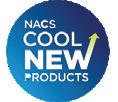
(404) 642-4967 www.getchyl.com Cool New Products Guide
www.convenience.org/Media/NACS-Magazine/Cool-New-Products
Envysion
www.envysion.com FasTrax
www.fastraxpos.com
www.federalind.com
www.iddba.org
www.buyjoey.com Johnsonville Sausage Co.
NACS Membership
www.convenience.org/Membership
NACS Show Education Sessions
www.nacsshow.com/Sessions/Education-Sessions NACS Show 2026
www.nacsshow.com
NACS State of the Industry & Talent Insights Dashboard Surveys 39 www.convenience.org/soi www.convenience.org/Research


In 2024, the national foodservice leakage rate (the percentage of shoppers who plan to purchase quick-service food within 30 minutes of their convenience store visit) rose to 28.7%, a 1.2 percentage point increase from 27.5% in 2023.
Across the board, the most foodservice leakage within the convenience channel was to burger chains. The second most popular QSR type varied by region. C-store shoppers in the Northeast and Southeast headed to fried chicken outlets, while those in the Midwest, South Central and Central sought Mexican fast food. Customers in the West region listed pizza as their second choice.
By adapting foodservice offerings to local preferences, convenience operators can ensure that their customers are seeing what they crave on the menu.
Almost a third of c-store customers will visit a QSR within 30 minutes.
Of those planning to visit a QSR, here are their top destinations.
